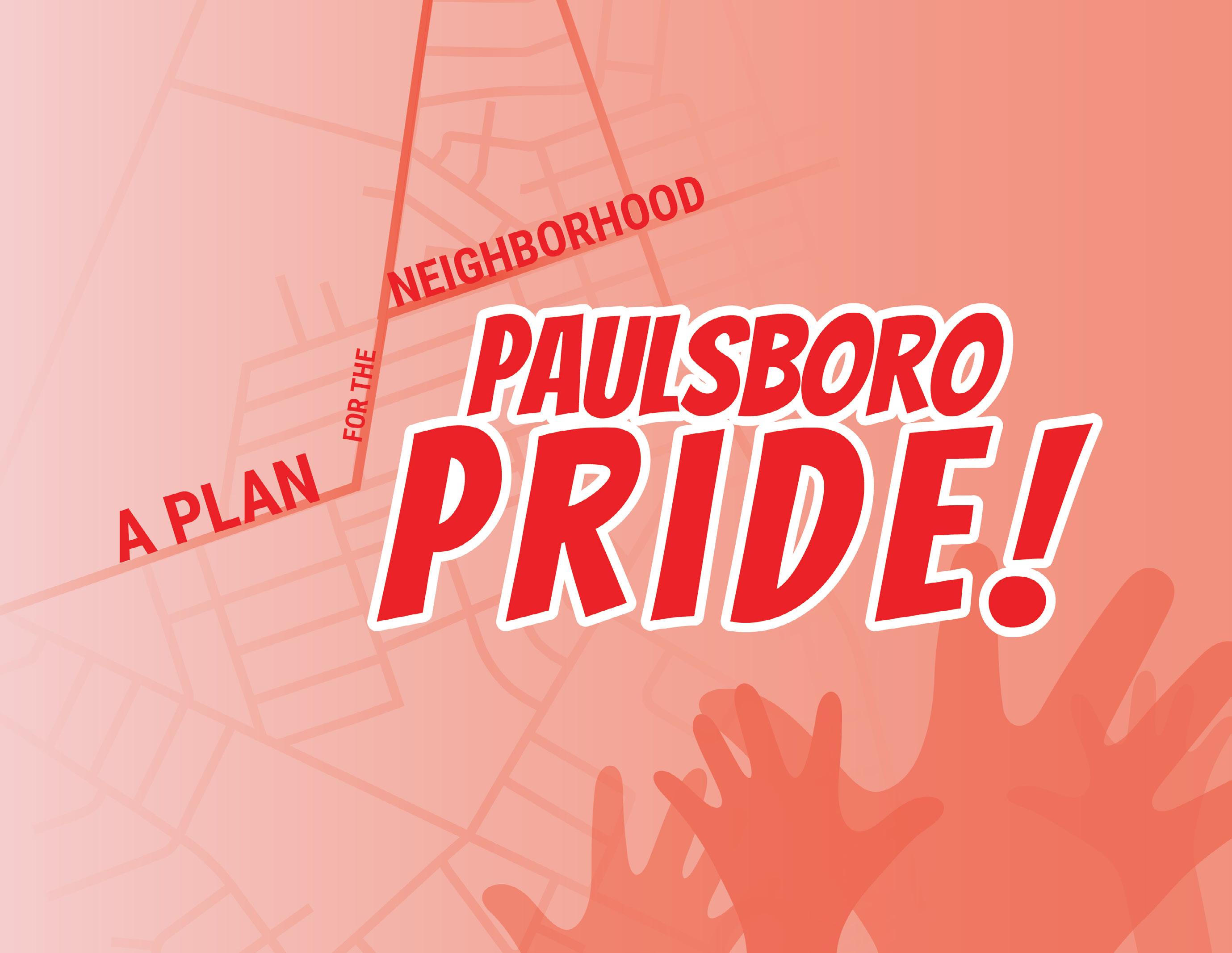

ACKNOWLEDGMENTS
AGENCY
Gateway Community Action Partnership
PROJECT MANAGER
Kyana Evans
PLAN ASSISTANT
Elsie Rivera
Shaquitta Davis
CONSULTANT
Interface Studio
COMMUNITY LIAISON
Second Baptist Church, WORCS
COMMUNITY CONVERSATIONS
FACILITATOR
Danielle Scott
INTERNS
Cara Piergiovanni
Jude Vernamonti
MBA FELLOW
Ronald Ngwashi
STEERING COMMITTEE
Elizabeth Moore
Anthony Clarke
Remenda Charles
Devonnae Grasty
Brianna Wallace
Bernadette Harvey
Ashley Harvey
Maria Guzman
Genesis Lopez
Une Evans
STAKEHOLDER INTERVIEW
PARTICIPANTS
NJ Department of Food Insecurity
Paulsboro Public Schools District
Paulsboro Education Association
County of Gloucester Health Department
Gloucester County Workforce Development Board
Camden Area Health Education Center (AHEC)
Rowan University Geography, Planning, and Sustainability Department
Inspira Health Network
Acenda NJ4S Program
Atlantic City Electric
Attentive Energy
Paulsboro Chamber of Commerce
Paulsboro Refinery PBF

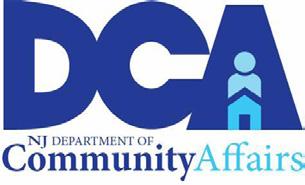

PLANNING CAMP PARTICIPANTS
Julian Gaines
Kayden Kato
Orion Cooper
Desire Cooper
Laevion Johns
Habib Koffi
Kahlil Streeter
Kelvin Santiago
SUMMER TEEN PARTICIPANTS
Eric Scott
Chris Neff
Dasoni Scott
Khristopher Rivera
Sanai Rone
Taraji Patterson
Harry Lewis
Jeffery Taylor
Aniah Hill
Thank you!
To the many business owners, residents, students, volunteers, and city staff who engaged with this team. Your work leading events, holding space for community conversations, and showing up to share your experiences and ideas has made this plan! Thank you also to the Regional Foundation and the NJ Department of Community Affairs NRTC Program for funding and supporting the efforts to put together this plan.


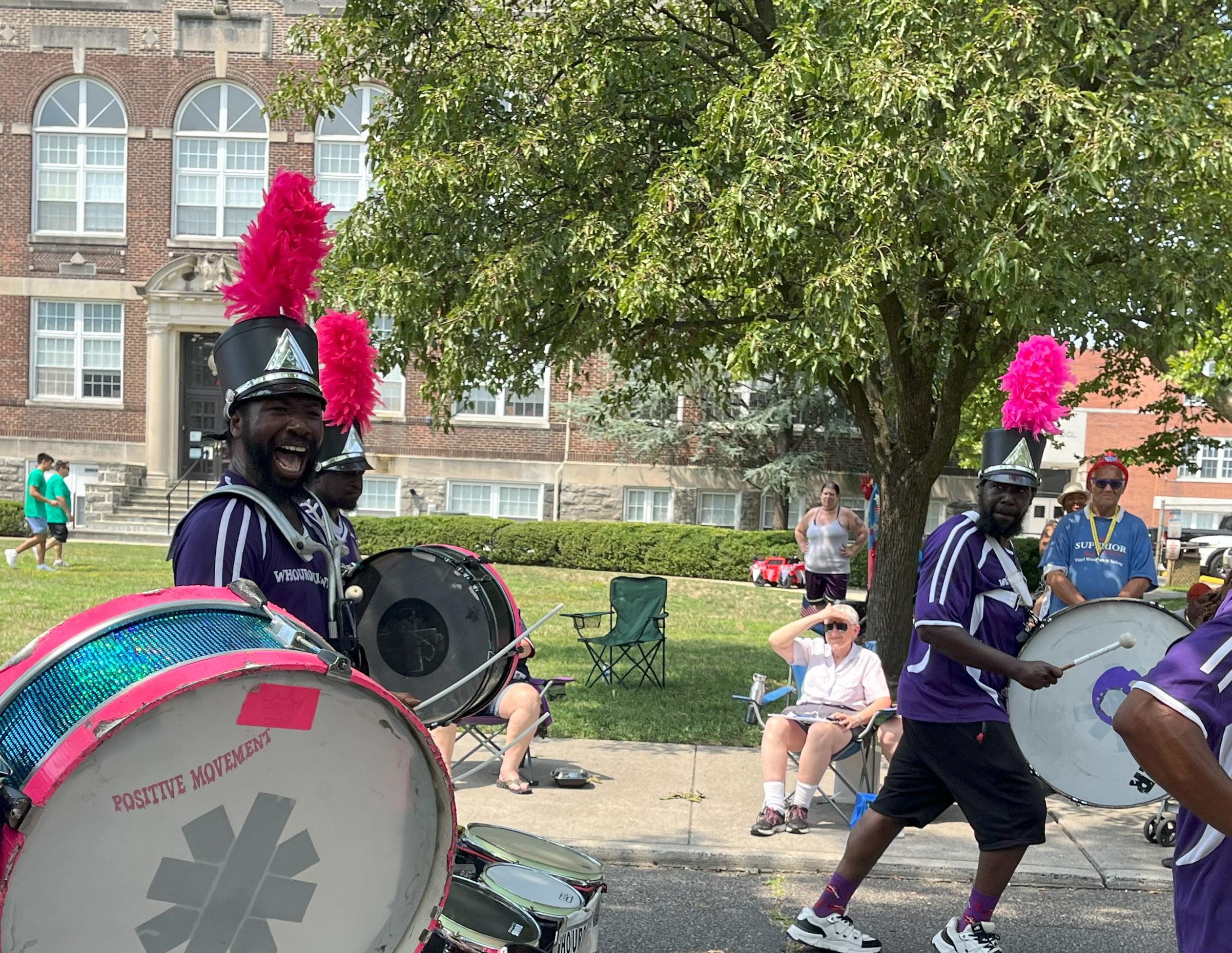

01 PUBLIC ENGAGEMENT & EXISTING CONDITIONS
History of the Community
Paulsboro boasts a rich history that dates back to the early 17th century. Initially inhabited by the Leni Lenape people, the area saw its first European settlement in 1623, when Dutch settlers established Fort Nassau near Big Timber Creek.The town derives its name from the Paul family, who settled near Mantua Creek in the late 17th century. Samuel P. Paul, a descendant of the original settlers, acquired a 100acre tract of land bounded by the Delaware River and Mantua Creek, establishing the foundation for the community that would become Paulsboro.1
A notable historical landmark is Fort Billingsport, the first land purchase made by the United States on July 5, 1776. The fort was intended to defend Philadelphia during the Revolutionary War and played a pivotal role in protecting river access against British forces.2
In the 19th century, Paulsboro emerged as a hub for maritime trade and industry, a status further reinforced by the construction of the West Jersey and Seashore Railroad in the late 1800s. The local economy flourished in the early 20th century with the establishment of oil refineries along the Delaware River, which became a significant driver of economic growth.
The 20th century saw Paulsboro develop a reputation for its inclusivity, strong community ties, and vibrant athletic
1 “Borough of Paulsboro History,” accessed January 14, 2025, https://paulsboronj.org/ general-info/history/.
2 “Refining Gloucester’s Revolutionary History,” Hidden New Jersey, accessed January 14, 2025, https://www.hiddennj.com/2013/11/refining-gloucesters-revolutionary.html
culture. In 1957, the Mayor’s Civil Rights Commission and Paulsboro High School introduced the Brotherhood Award, a program designed to promote goodwill and respect across religious and racial lines. The award, presented annually to a graduating senior, honors individuals who embody the principles of brotherhood and mutual respect.
Paulsboro High School, home of the Red Raiders, has been celebrated for its outstanding athletic programs, particularly in wrestling and football. The wrestling team has captured numerous Group I state championships, while the football team has won multiple South Jersey sectional titles, including record-breaking streaks. These accomplishments have solidified the school’s reputation as a New Jersey sports powerhouse and remain a significant source of community pride.3
However, the 21st century has brought significant challenges to the community. In 2012, a Conrail freight train derailed on the East Jefferson Street Railroad Bridge over Mantua Creek, releasing 23,000 gallons of vinyl chloride. This environmental disaster prompted evacuations and raised serious health concerns for residents.
3 “About Paulsboro High School,” accessed January 14, 2025, https://phs.paulsboro. k12.nj.us/about.
In addition to this incident, Paulsboro has faced socioeconomic difficulties, including high poverty rates, declining educational performance, rising vacancies, crime, and a lack of locally serving businesses and services. Despite these challenges, the community continues to demonstrate resilience and a commitment to restoring the pride of place for which Paulsboro has long been known.
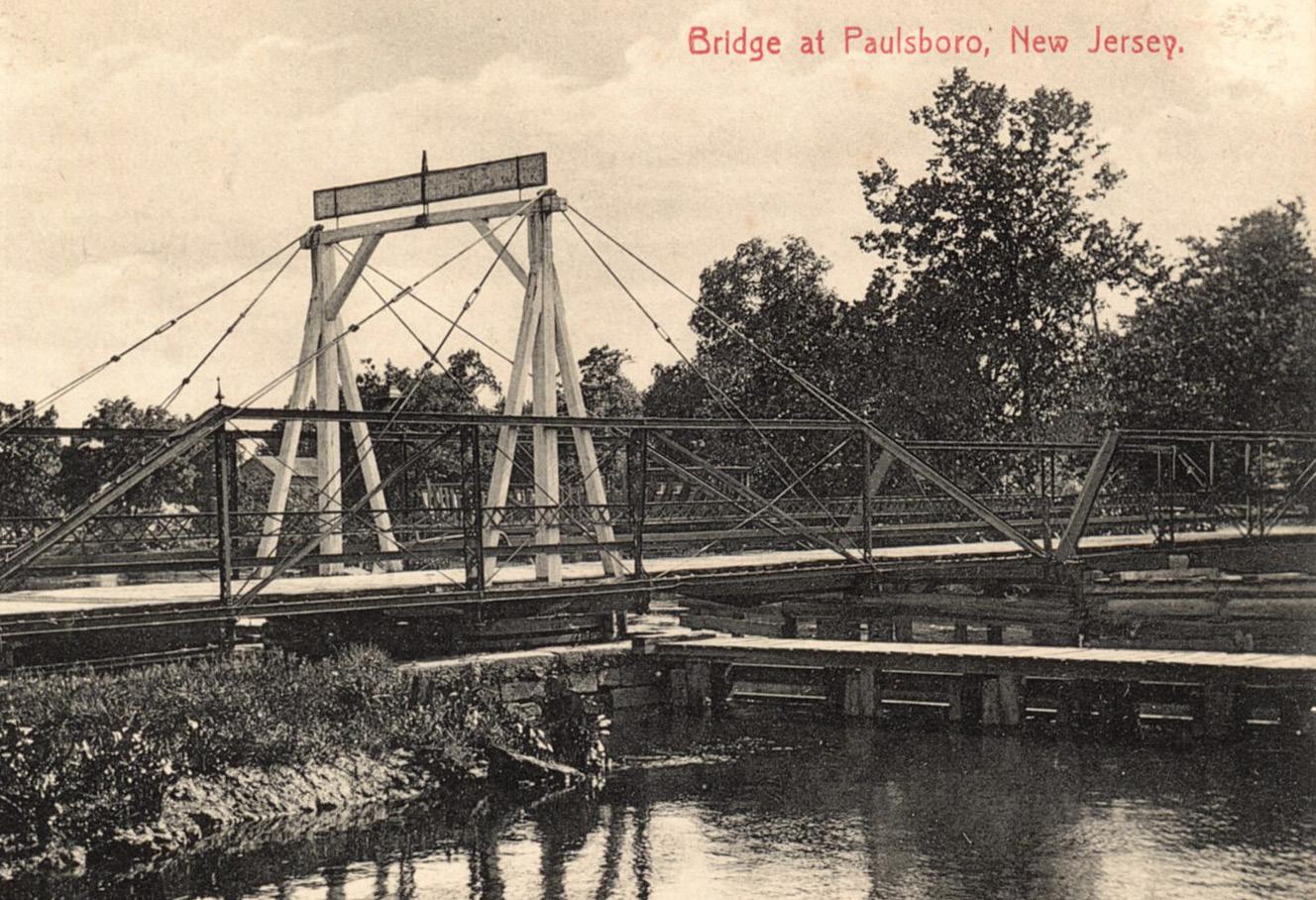
I would like to see the town embrace its heritage as a river community. We should be vigilant in maintaining Paulsboro’s heritage. “ ”
Historic photo of bridge crossing the Mantua Creek.
PAULSBORO THEN AND NOW
The Paulsboro Pride Neighborhood was once a thriving community, characterized by bustling main streets, passenger rail service, local entertainment, and even a waterfront theme park. While much of historic Paulsboro has changed over time, the community remains deeply proud of its rich history and is committed to building on that legacy as it embarks on a new era of revitalization.



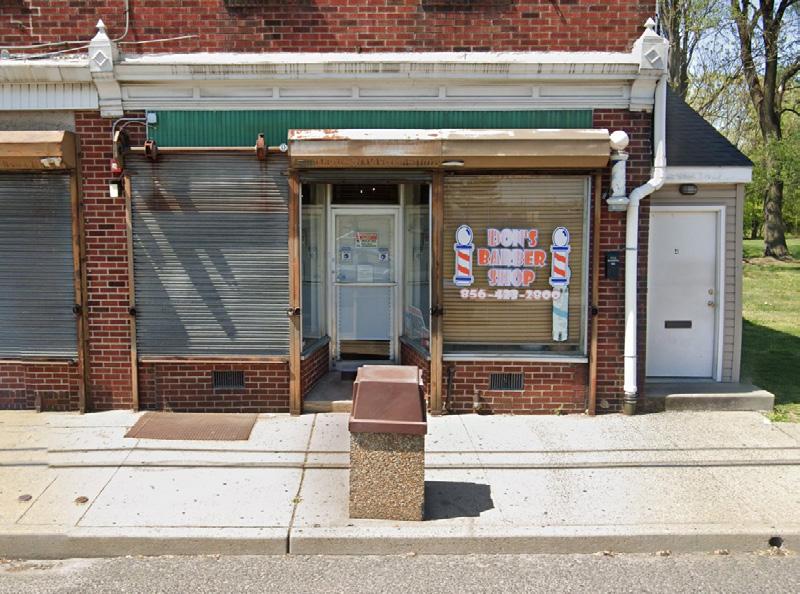

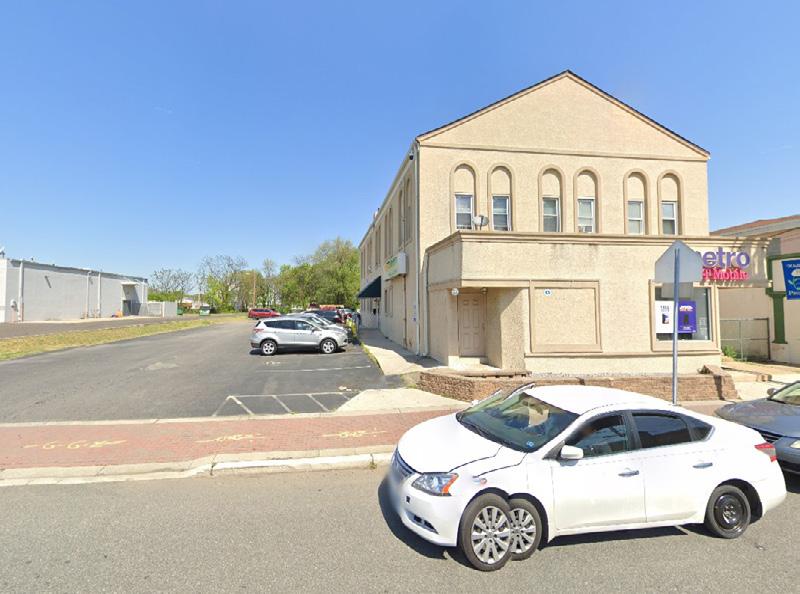
The Former Bang Bang Theatre - E Broad Street
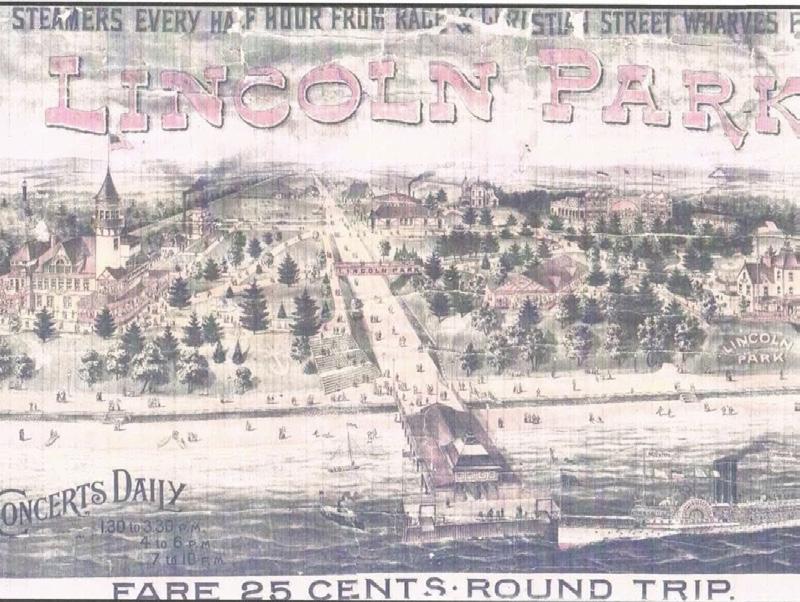
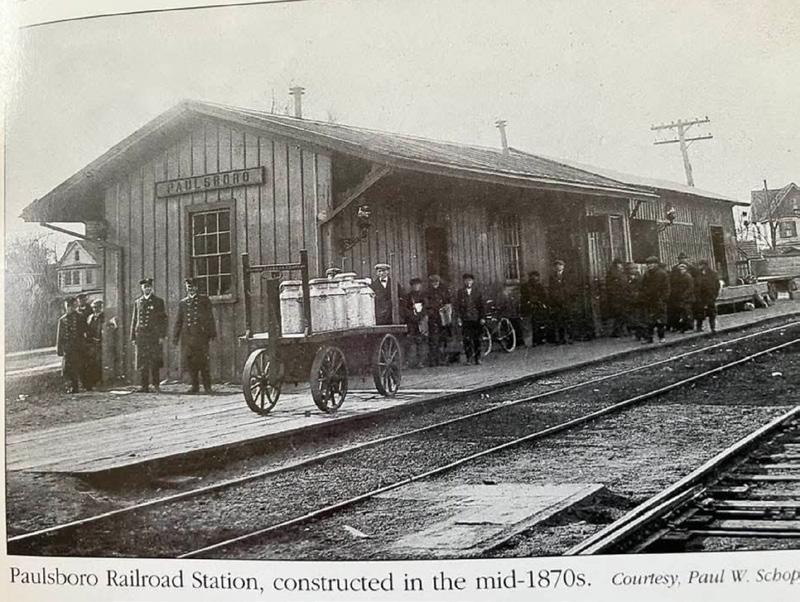
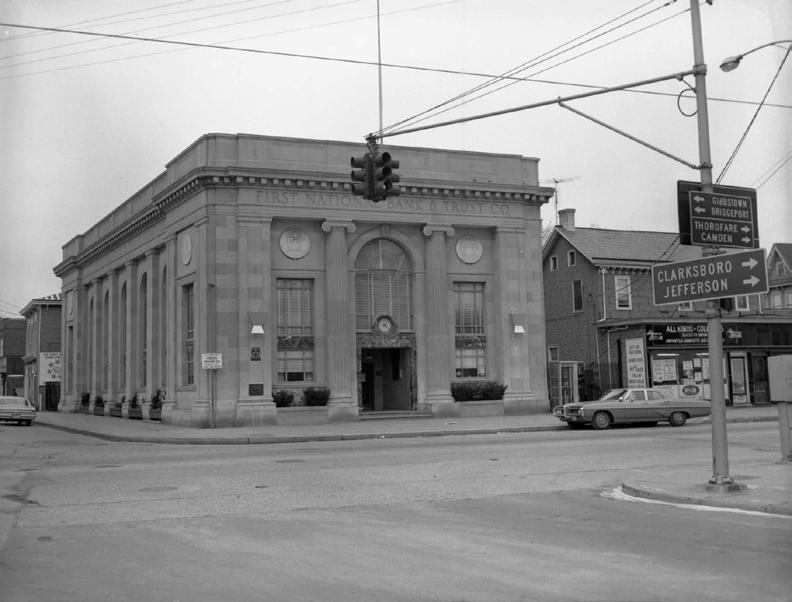
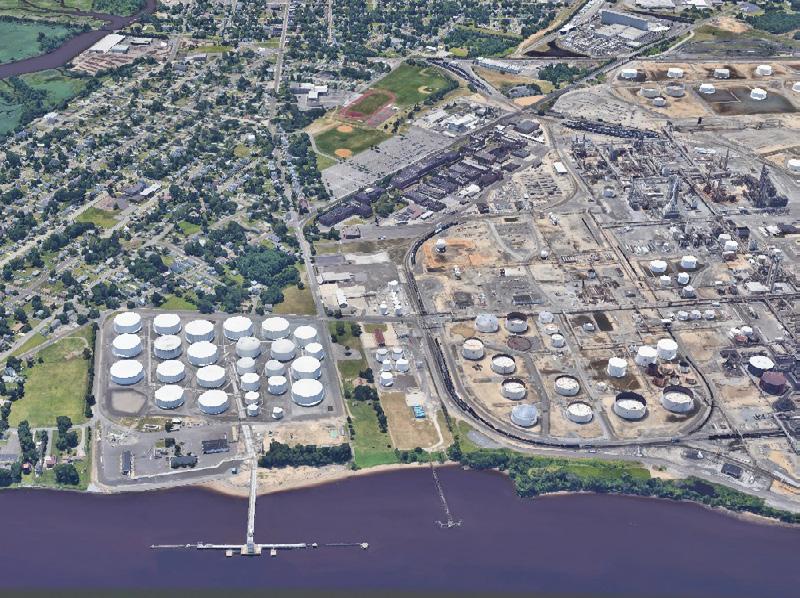
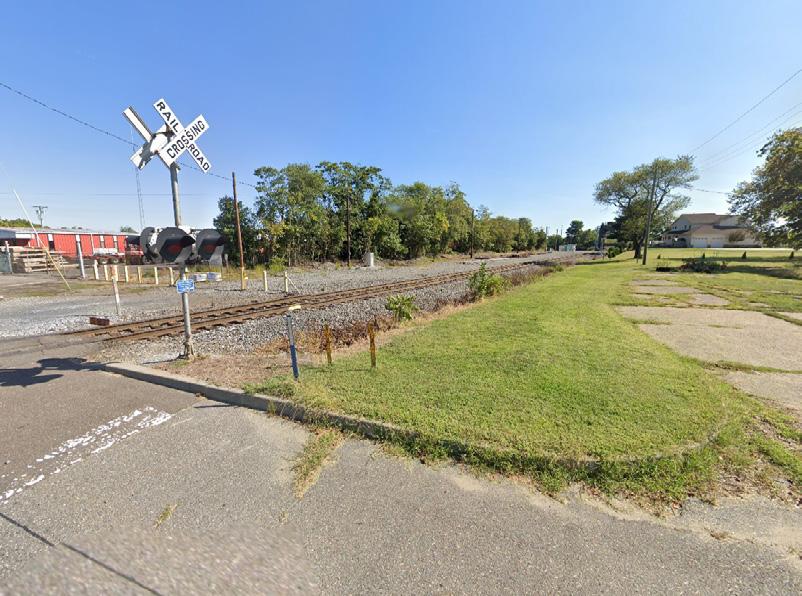
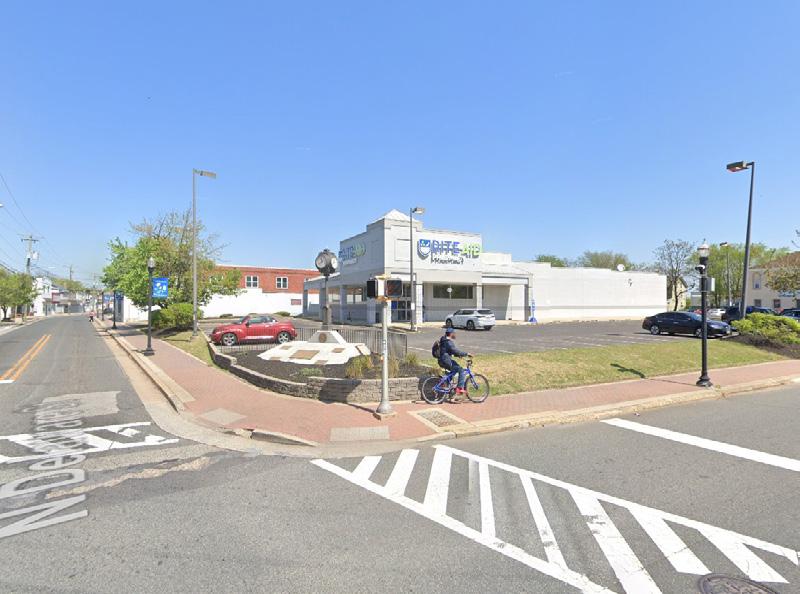
Lincoln Park - Delaware and Clonmell along the river
Former Lincoln Park site
Former Paulsboro Railroad Passenger Station near Madison Street
Site of former Paulsboro Railroad Station (approximate)
Former First National Bank & Trust Co. - Broad & Delaware Streets
Site of former First National Bank & Trust Co. - Broad & Delaware Streets
Paulsboro Pride Neighborhood Today
The Paulsboro Pride Neighborhood is bounded by Railroad Avenue to the north, Billingsport and Berkley Roads to the west and south, and the Mantua Creek to the east. The neighborhood is bisected by Broad Street/Route 44, a state highway and one of Paulsboro’s primary commercial streets. The neighborhood falls within Census Tract 5004, and includes Block Groups 1, 2, and 3 of that tract.
Home to more than 4,000 residents, the Paulsboro Pride Neighborhood accounts for approximately 65% of the Borough’s total population of 6,213. Compared to Gloucester County as a whole, Paulsboro is a more diverse community, with 38.6% of residents identifying as African American, 18.9% as Hispanic or Latino, and 16.4% as two or more races. However, economic disparities between Paulsboro and the broader county highlight the challenges faced by local residents. The median household income in Paulsboro is $68,750, significantly lower than Gloucester County’s median of $102,807. Unemployment in Paulsboro stands at 12.7%, more than double the County’s 5.2% rate, while 8.9% of families live in poverty, nearly twice the County’s 4.5%.
Housing conditions further underscore the economic strain on Paulsboro residents. The Borough’s housing vacancy rate is 14.3%, nearly three times the County’s rate of 4.9%. Additionally, housing costs are a burden for both homeowners and renters, though renters in Paulsboro are particularly affected. While 24.3% of homeowners in Gloucester County and 21.6% in Paulsboro are considered cost-burdened, meaning they spend more than 30% of their income on housing, the disparity is far greater among renters. In Gloucester County, 49.2% of renters experience cost burdens, but in Paulsboro, that figure rises to 73.3%, illustrating the heightened financial pressure on those renting in the Borough.
1.1: Census Tracts & Block Groups 2020

Figure
NEIGHBORHOOD CONDITION PHOTOS
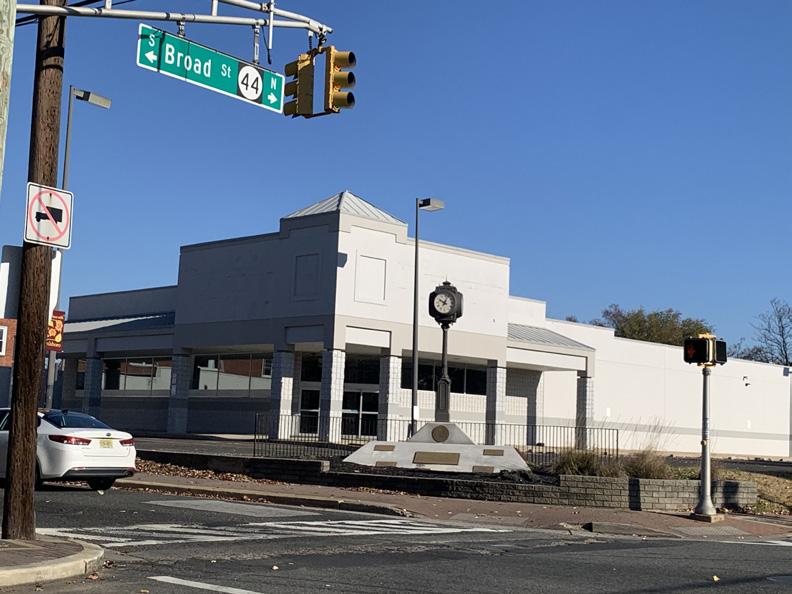

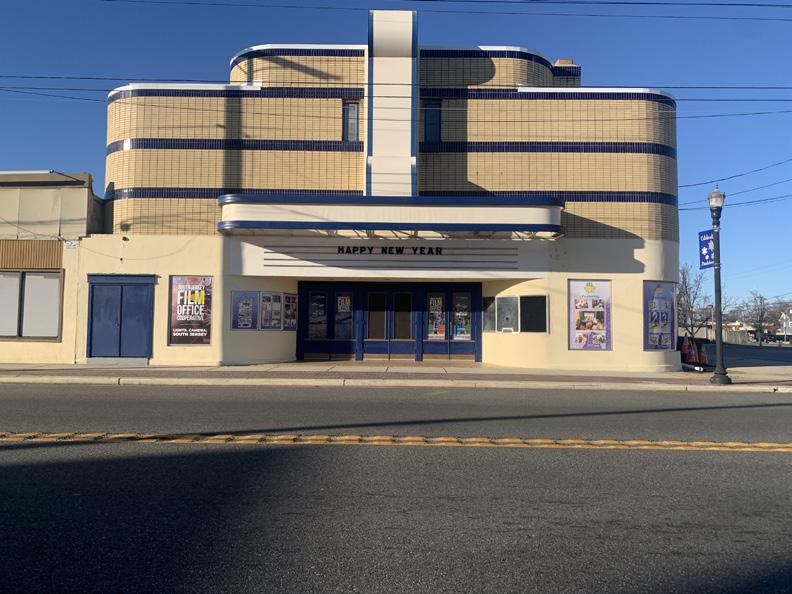



Former Rite Aid pharmacy - 3 E. Broad St. Gill Memorial Library - 145 E. Broad St.
The Hill Theatre, a former movie theater now used as studio space for film and television productions. - 35 W. Broad St.
The historic Paul House. - 710 E. Broad St.
Former CVS pharmacy. - 231 W. Broad St.
Vacant storefronts on Delaware St.

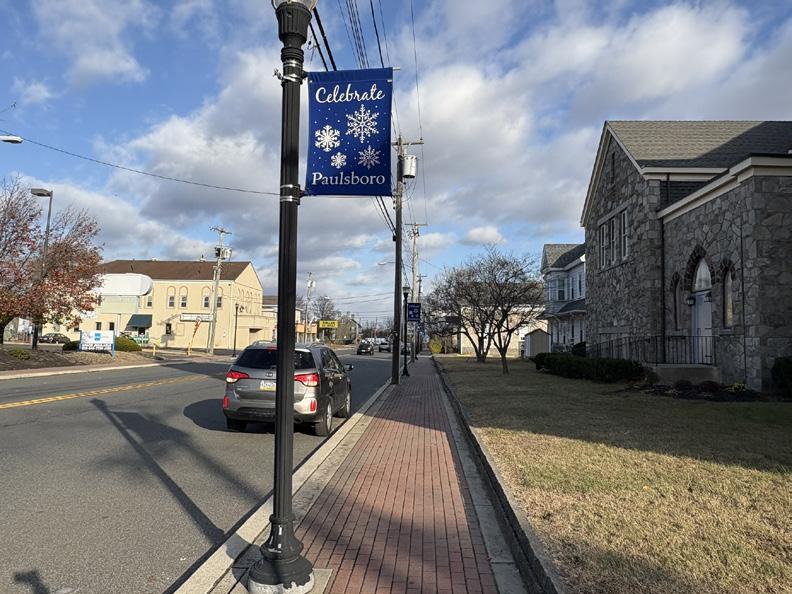


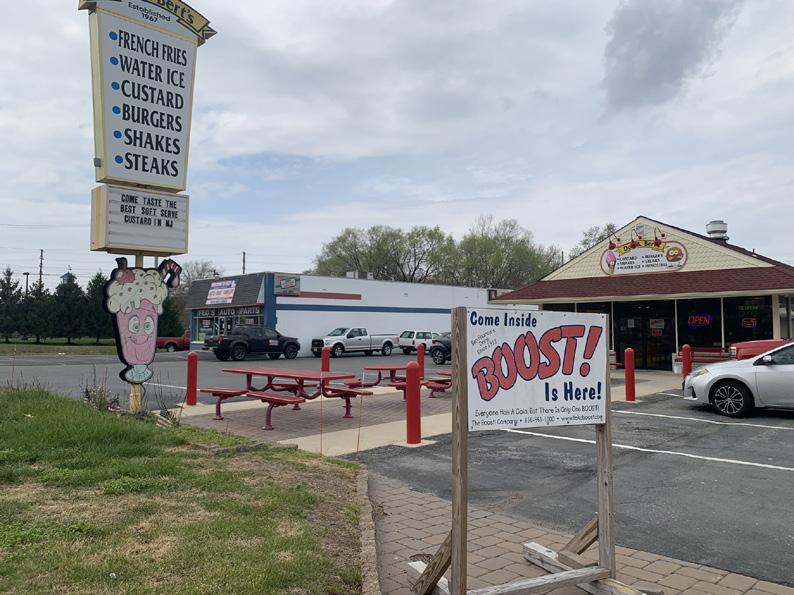

Vacant building at intersection of Delaware St. & Swedesboro Ave. Banner and streetscape in front of St. Paul’s United Methodist Church
Dollar General - 117 E. Broad St.
Don & Bert’s Custard Stand - 635 W. Broad St.
Sons of Italy Lodge - 525 W. Broad St.
Dollar Tree & Save-A-Lot - Paulsboro Plaza Shopping Center, W. Broad St.
NEIGHBORHOOD CONDITION PHOTOS

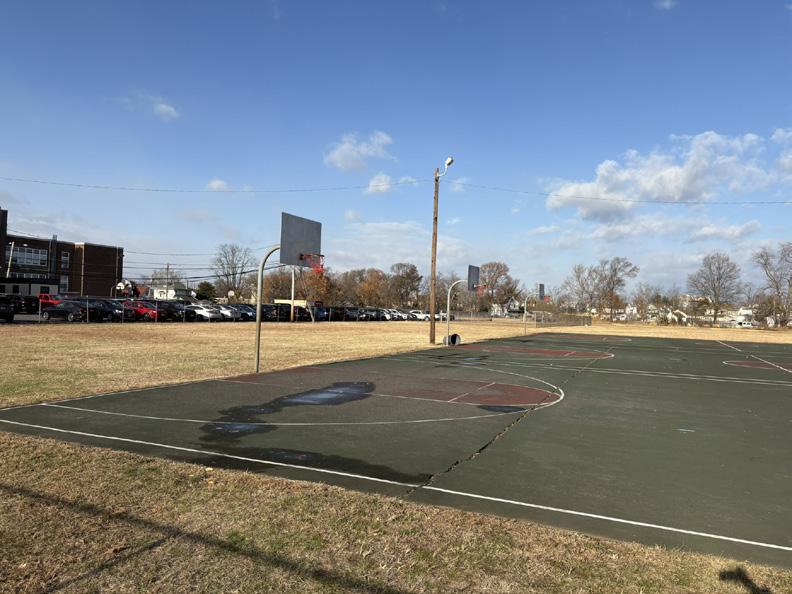
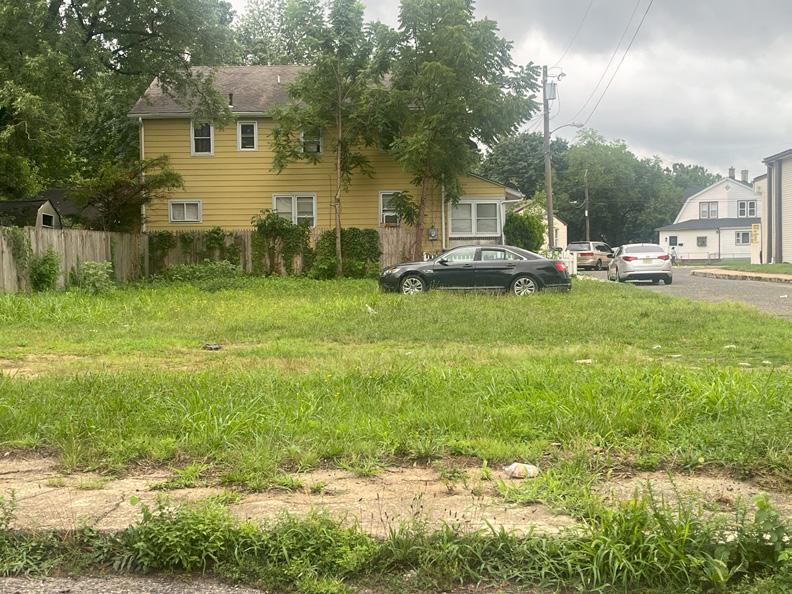
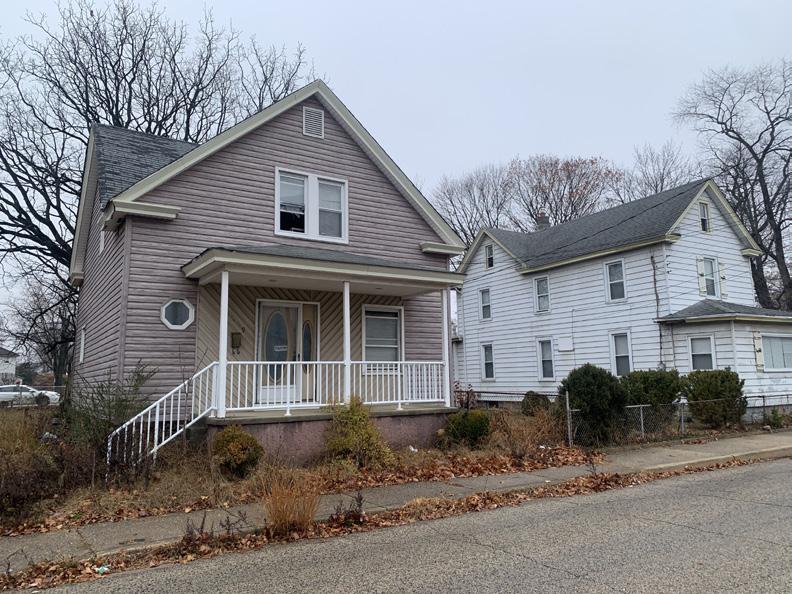


Vacant lot on Monroe St.
Neighborhood housing stock examples
Buck Street Park with missing ladder/path to slide Baird Avenue Recreation Area basketball courts

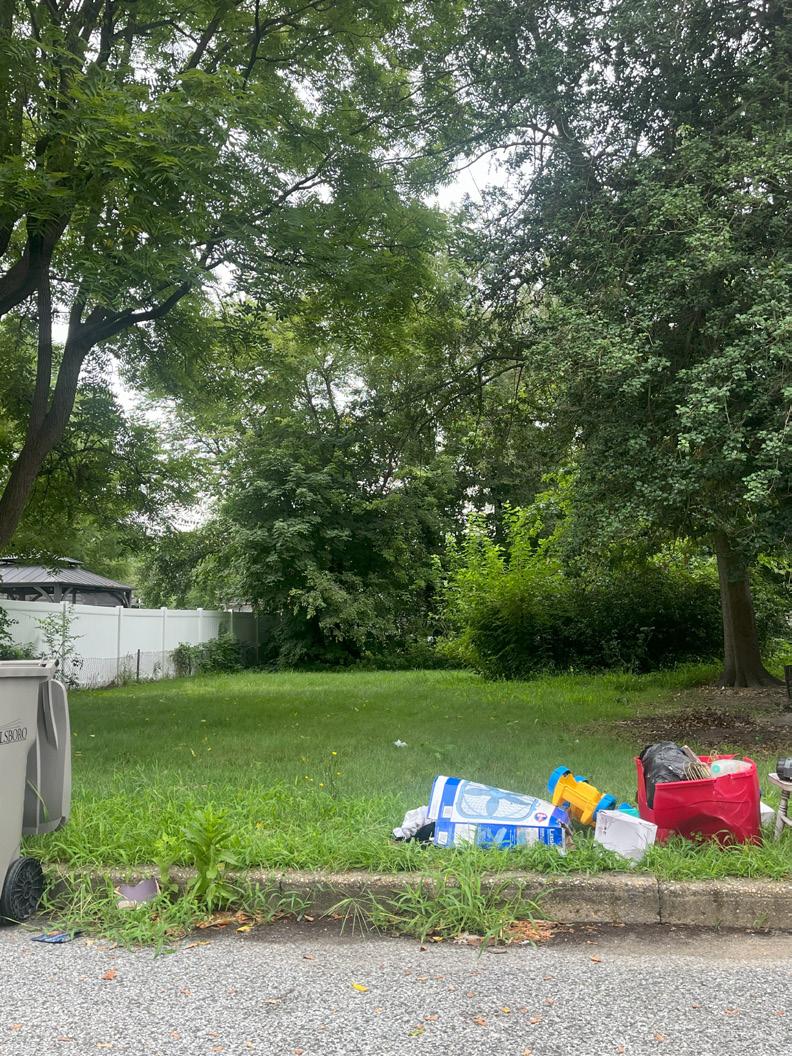
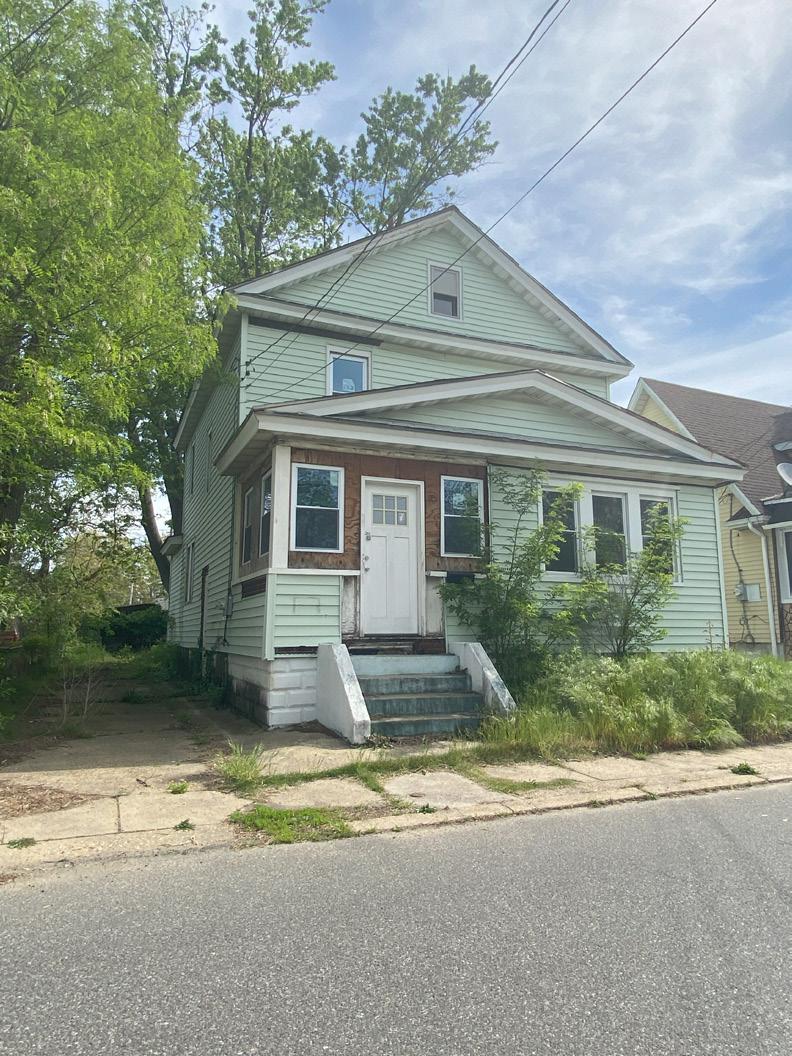
Vacant home
Excess trash in vacant lot
Home undergoing renovation
Why Plan? Why Now?
The Paulsboro Pride Neighborhood is home to families that have lived there for generations, fostering a strong sense of community identity. However, the southern half of the community is increasingly impacted by negative trends that threaten the neighborhood’s future and the well-being of its residents. Violent crime has risen in recent years, with several high-profile incidents contributing to a growing negative perception of the community.
Residents have expressed concern about the state of their neighborhood, which is burdened by vacant lots, accumulating debris, and deteriorating housing conditions. Paulsboro has long been considered an affordable haven for working-class families seeking homeownership. However, a rise in substandard rental housing and the ongoing effects of the nationwide housing affordability crisis have shifted the community from a majority homeowner to a majority renter demographic.
The Borough’s commercial districts are also facing challenges. The recent loss of the community’s only two national pharmacy chains has compounded difficulties in accessing essential goods and services. Designated as #36 on the NJ Economic Development Authority’s 50 Food Desert Communities List, Paulsboro presents significant challenges for residents without access to a car, as traveling to services, resources, or employment opportunities can require hours by public transit, even for nearby destinations.
The State of New Jersey has recognized Paulsboro as a community that is struggling on many fronts. In addition to being listed among the top food desert communities by the NJEDA, Paulsboro has been recognized as one of the State’s most distressed municipalities, ranking #23 out of 564 municipalities on New Jersey’s 2023 Municipal Revitalization Index, the State’s official measure and ranking of municipal distress based on social, economic, physical, and fiscal conditions in each locality. Additionally, Paulsboro is considered an “Overburdened Community” by the NJ Department of Environmental Protection, which is defined as a community with a large percentage of low-income, minority, or low English proficiency households and may face disproportionate harmful effects from nearby facilities.
Once recognized as an ideal place to raise a family, Paulsboro Pride now grapples with an underperforming educational system and a lack of youth-focused activities, programs, and safe spaces, eroding this critical strength.
The Paulsboro Pride Neighborhood Plan offers a pivotal opportunity to address these challenges. Built on an extensive community outreach process involving residents, business owners, stakeholders, and youth, the Plan reflects a collective vision for the future. It provides a roadmap for the community, outlining goals, projects, and initiatives designed to meet the shared aspirations of the Paulsboro Pride community and foster a vibrant, equitable, and thriving neighborhood.

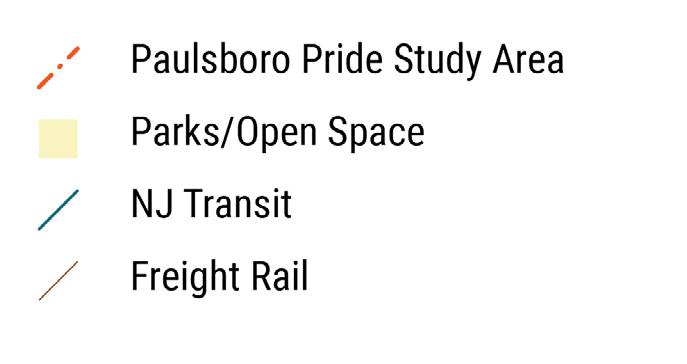
Figure 1.2: Paulsboro Pride Neighborhood
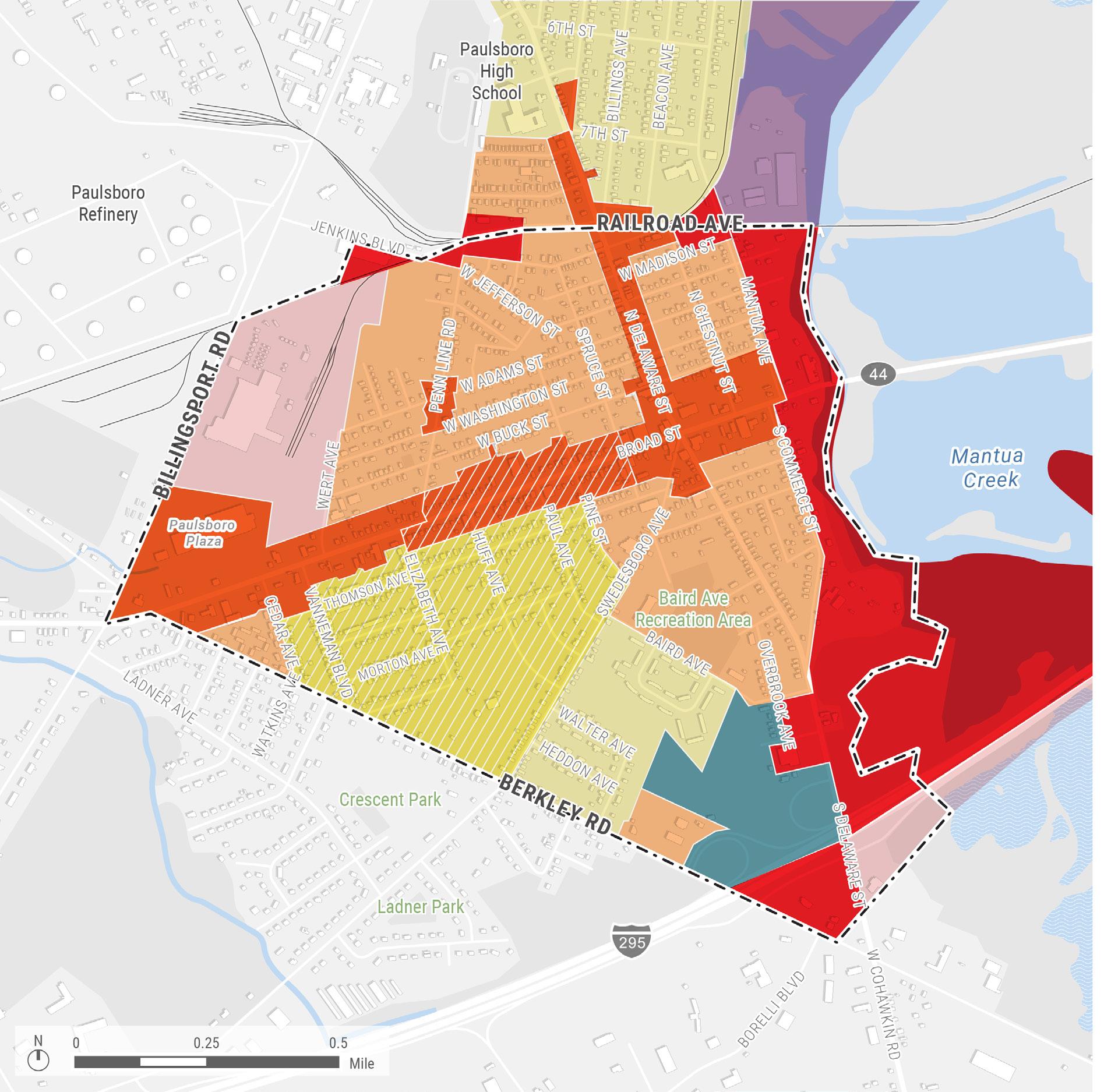
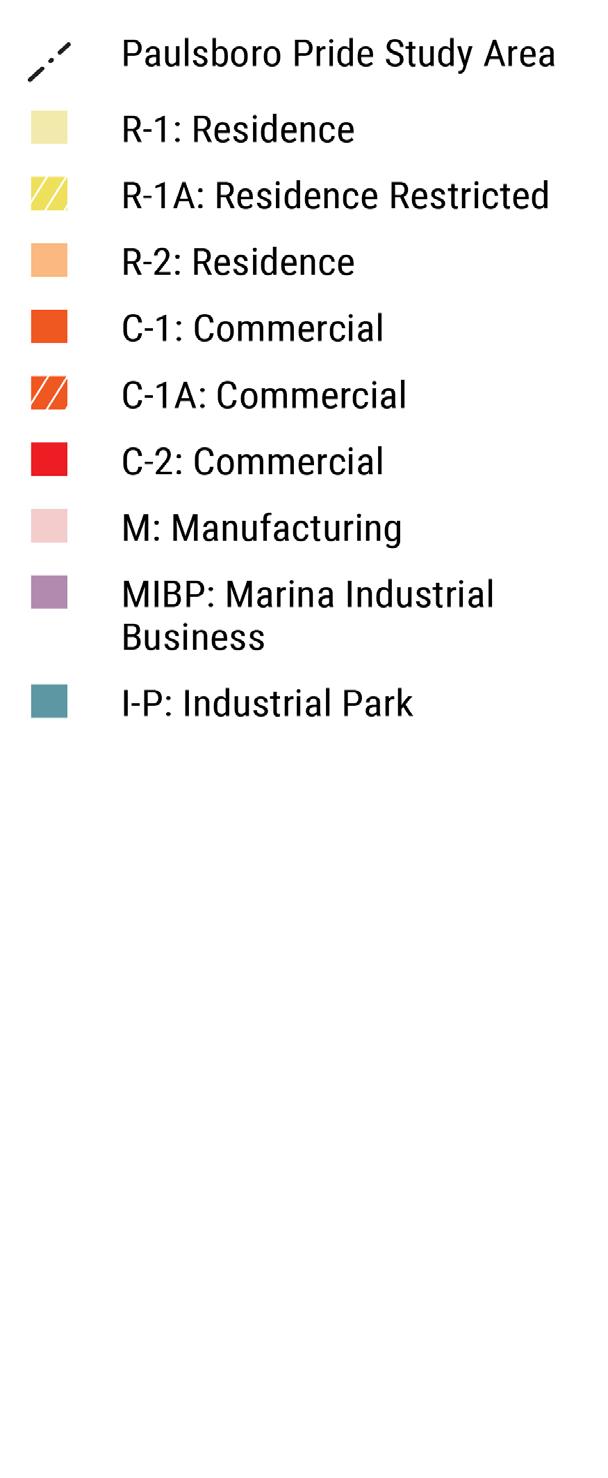
Figure 1.3: Zoning
2015 Borough of Paulsboro Zoning Map
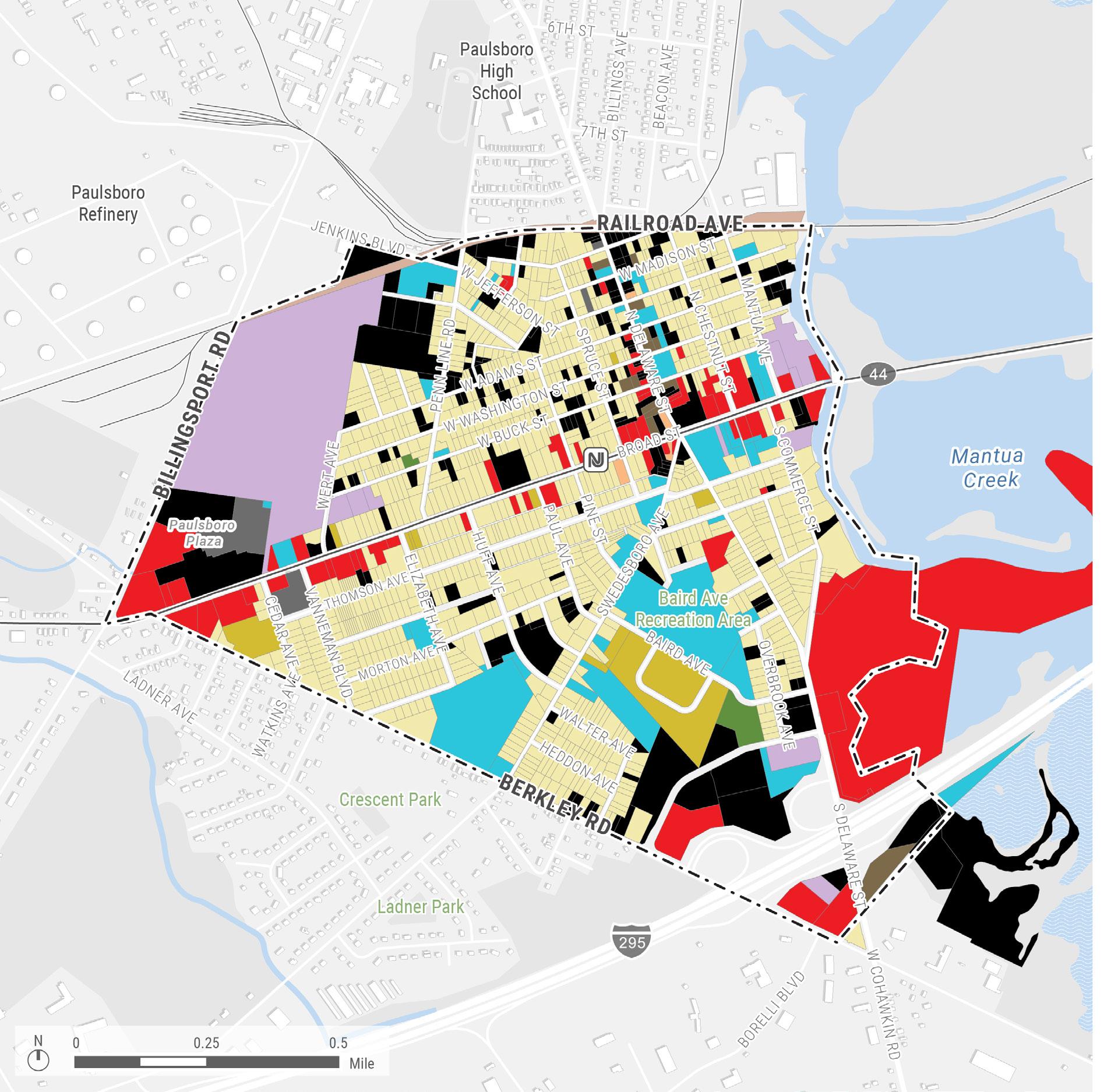
2024 Field Survey
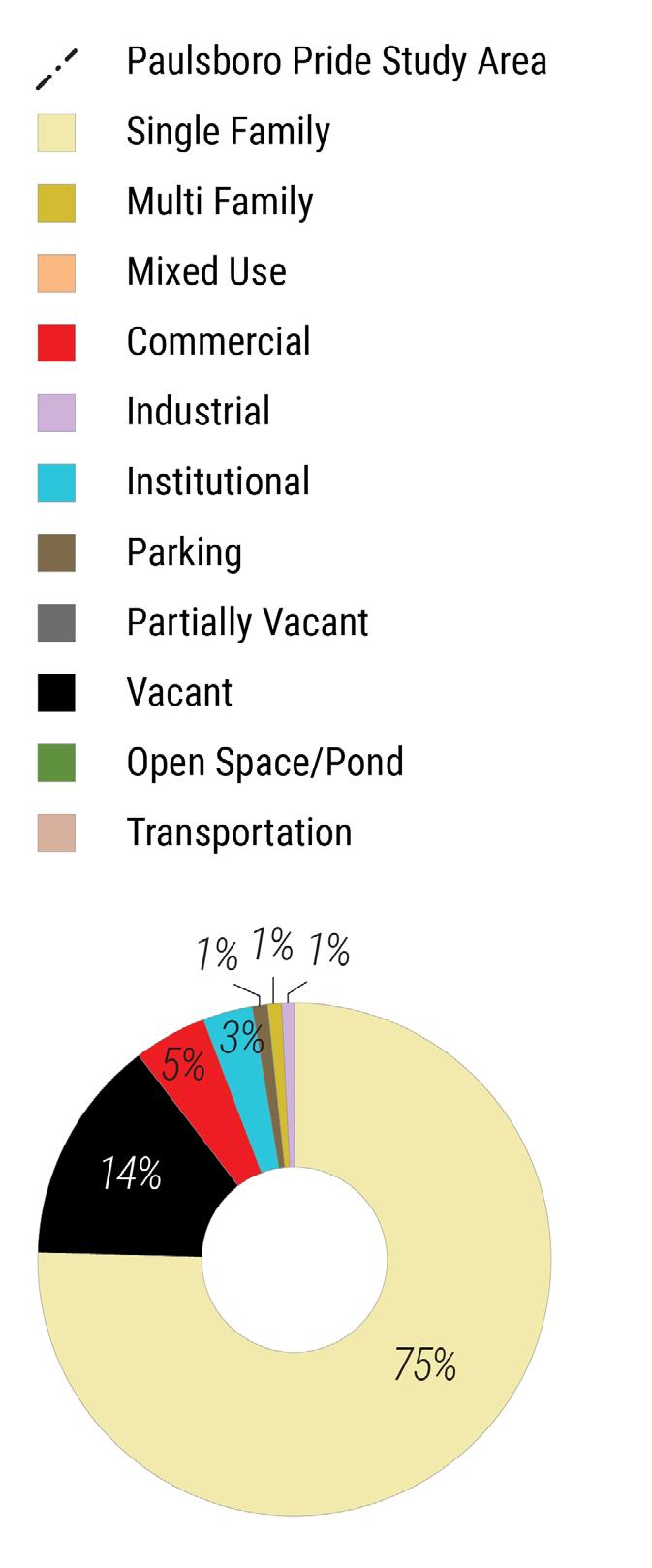
Figure
Engagement Process & Methods
The public engagement approach for the Paulsboro Pride Neighborhood Plan was designed to reach as many members of the community as possible. The primary goal of the engagement process was to understand the issues and opportunities that mattered most to residents and to identify the changes they hoped to see for the future. Outreach activities were thoughtfully planned to include community members of all ages and backgrounds, with several efforts specifically aimed at engaging young people. The Paulsboro Pride team prioritized accessibility, meeting residents where they were by attending events, visiting schools and churches, and conducting door-todoor outreach, among other methods. These activities ranged from short interactive exercises at community events to in-depth conversations at neighborhood gathering spaces.
Key highlights of the engagement process included connecting with residents at popular summer events, such as Juneteenth, Paulsboro Day, and the July 4th Parade, as well as hosting smaller pop-up activities at schools and other local venues. A series of targeted and open focus group discussions and interviews were held at multiple locations, providing additional opportunities for in-depth dialogue. To collect quantitative data, the team conducted surveys, including a Success Measures neighborhood survey, as well as specialized surveys for business owners and youth. Additional outreach efforts included the production of a video capturing what makes residents “Paulsboro Proud,” as well as kids’ camps, community cleanups, neighborhood walks, and volunteering at local events. Finally, to conclude the engagement process, a series of community open houses were held throughout the neighborhood to review the draft plan and gather feedback on the proposed strategies.
ENGAGEMENT BY THE NUMBERS
2,000+ People Reached in Pop Ups & Community Events
120 Community/Steering Committee Meeting Attendees
8 Interns, Fellows, and Assistants
20 Summer Youth Planning Camp Participants
1,000 Social Media Engagements
60+ Interviews and Stakeholder Discussions
225 Open-Invite Community Conversation Attendees
350 Household Surveys Completed
300+


1.5: Outreach Locations
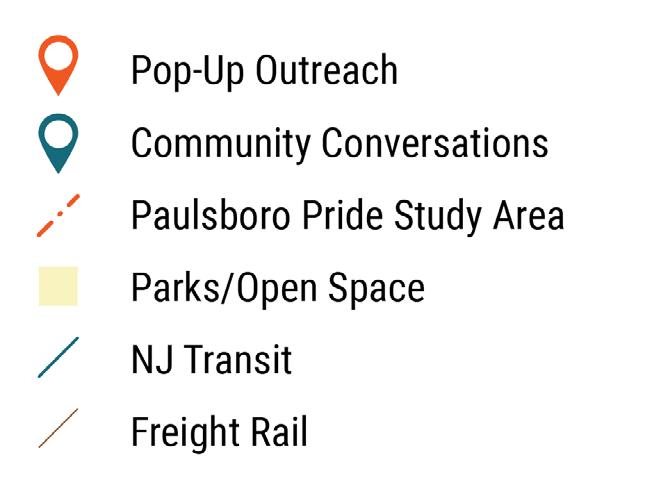
Figure

INTERVIEWS
During the summer months, the project team conducted interviews with 22 community residents. These interviews were led by both the project manager and summer interns. Residents were asked a series of questions about their experiences living in Paulsboro, their aspirations for the community’s future, and their suggestions for revitalization through open-ended discussions.
In addition to resident interviews, the project manager engaged with several local stakeholder groups over the course of the project. These discussions focused on the work being done as part of the Paulsboro Pride Neighborhood initiative, the community planning process, and issues that should be addressed in the final neighborhood plan.

COMMUNITY CONVERSATIONS
The project team engaged over 60 local residents through a series of community conversations held at multiple locations throughout the community which were open to all residents who wished to participate in discussions about revitalization efforts. Additionally, the team conducted focus groups with local community organizations, asking questions about their missions and perspectives on the needs and opportunities in the Paulsboro Pride Neighborhood. Each community conversation was transcribed in full and included a summary of the primary themes raised by residents.
COMMUNITY CONVERSATION THEMES
Based on all the information gathered, there is an overall feeling that there is no longer a sense of community/ neighborhood and that the pride in the town is gone. From the community conversations, the overall sentiment is that the proverbial village no longer exists, and that people aren’t as connected to the town and don’t have the same sense of pride as was once evident in the past. The sentiment from most of the participants is that the contributing factor of this could be the insurgence and increase of the transient population and lack of homeowners in town.
Changes Over Time: Participants expressed a sentiment of nostalgia for a safer, more community-oriented past. They noted increased crime, decreased community pride, and the closure of essential stores affecting everyone.
Family and Community Bonds: Many residents stay in Paulsboro due to strong family ties and a sense of community. They emphasize familiarity and comfort as key reasons for remaining despite challenges.
Challenges Faced: Issues highlighted include economic decline with businesses shutting down, inadequate police engagement with the community, and administrative leadership perceived as lacking transparency and professionalism.
Perceptions and Aspirations: There is a desire to beautify Paulsboro and to improve its image from its current negative associations to being known as a welcoming, safe town with strong community involvement and accountability.
Desired Improvements: Residents want more involvement in community affairs, youth recreational programs, increased police presence and community engagement (community policing), and improved communication from local leadership.



HANDOUTS AND DOOR HANGERS PROMOTED THE SURVEY.
NEIGHBORHOOD SURVEY
The project team developed a statistically valid neighborhood survey, which was distributed via direct mail to a random sample of residents throughout the Paulsboro Pride Neighborhood. To increase participation, door hangers and follow-up phone calls were used to encourage households that did not initially respond to complete the survey. Additional copies of the survey were made available at community outreach events for residents who wished to participate; these responses were tallied separately. To ensure inclusivity, the survey was translated into Spanish and Arabic, allowing residents to complete it in their preferred language.
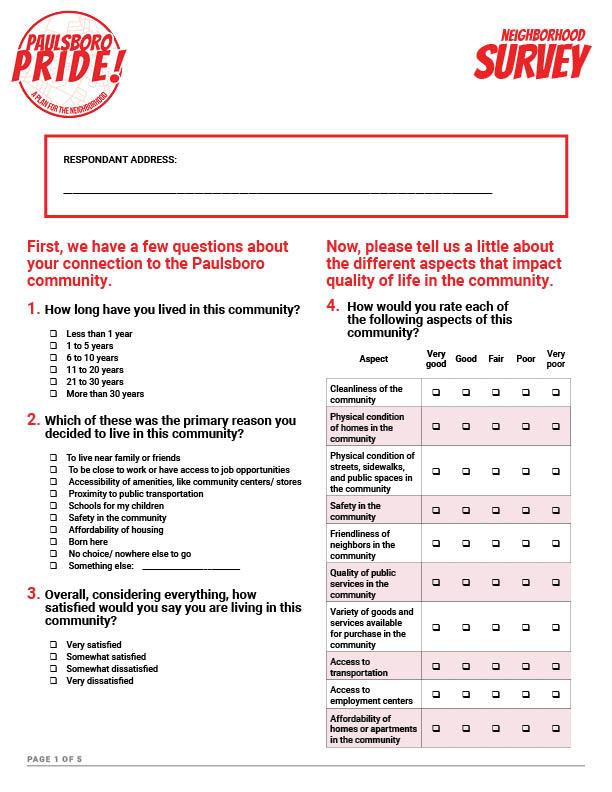

First page of the paper version of the survey.
SURVEY THEMES
The survey provided insights into residents’ needs, priorities, quality of life, personal circumstances, and community challenges, asking about:
• Connection to Paulsboro: How long respondents have lived in the community and their primary reason for choosing to live there.
• Overall Satisfaction: Level of satisfaction with life in the community and specifics such as cleanliness, housing conditions, safety, and public services.
• Community Amenities: Frequency of using community resources and services, like grocery stores, healthcare, parks, and places of worship, in and outside Paulsboro.
• Desired Businesses: Types of new services respondents would like to see.
• Safety Perceptions: How safe respondents feel during the day and night.
• Community Changes: Respondents’ views on how the community has changed over the past three years and predictions for the future.
• Housing Situation: Expenses over time, affordability, and interest in ownership.
• Food Security: Frequency of insecurity, such as running out of food or using pantries.
• Access to Healthcare: Instances of being unable to afford medical, dental, or mental health care over the past year.
WHO TOOK THE SURVEY?
The survey was open to residents who resided within the Paulsboro Pride Neighborhood. Of the 1,072 occupied households, 266 households completed the neighborhood survey.
62% of responding households reported having children under 18 years old, while 38% did not have any children in the household. Among those with children, 43% had one or two children, 10% had three, and 9% had four or more.
Survey respondents primarily identified as Caucasian/White (47%) or Black/African American (35%). Smaller proportions identified as Mixed Race (9%), Other (6%), American Indian/Alaska Native (1%), or Asian (1%). Additionally, 13% of respondents identified as Hispanic, Latino, Latina, or Latinx, while 87% did not.
Survey participants were evenly distributed across most age groups, with 22% each in the 25–34, 35–44, and 55–64 age brackets. Smaller proportions were aged 65–74 (13%), while only 1% of respondents were either 18–24 or 75 and older.
31% of respondents have lived in the community for more than 30 years, and 13% have been residents for 21–30 years. 19% have lived in the community for 1–5 years, and 16% for 6–10 years, while only 3% were newcomers with less than a year in the area.
Figure 1.6: How long have survey respondents lived in Paulsboro?
How long Survey Respondents
have lived in Paulsboro
POP-UPS
Pop-up events held throughout the summer were a key component of the engagement process, offering quick, interactive activities to gather resident input on the future of Paulsboro while reaching a broad audience. These events took place throughout the summer and early fall, either by building on existing community events, such as the Juneteenth Festival, or by hosting activities at important community spaces like schools.
The activities included:
• Collaborative Map: Residents were invited to share ideas or concerns and identify key locations on a map where these ideas could be implemented.
• Spin Wheel: This interactive tool prompted conversations around key topics, including safety, public spaces, education and activities, collaboration, local businesses, and block conditions.
• “What Makes You Paulsboro Proud?” Board: A series of write-in prompts encouraged residents to document their ideas for the key topics and issues impacting the Paulsboro Pride Neighborhood.
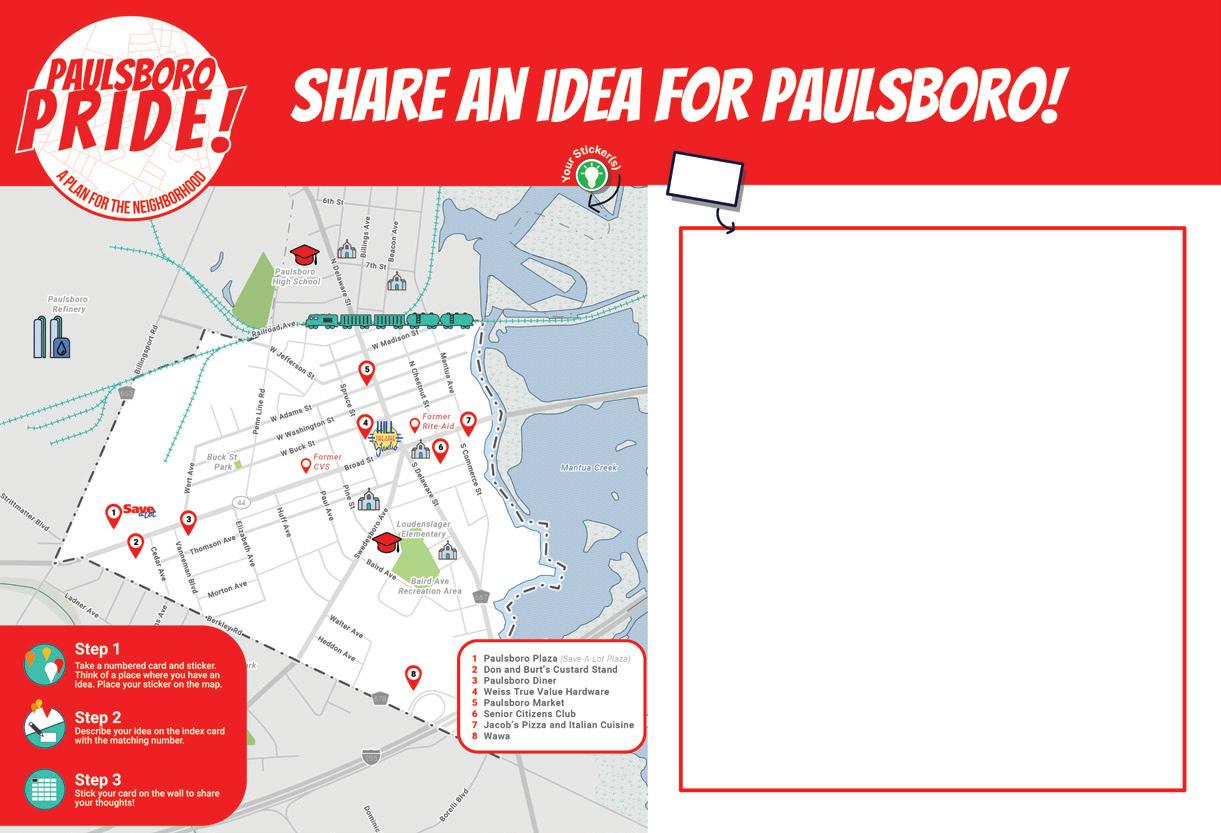


There are people who care and are trying to make changes. This is on the incline.
”
Pop-up engagement materials.
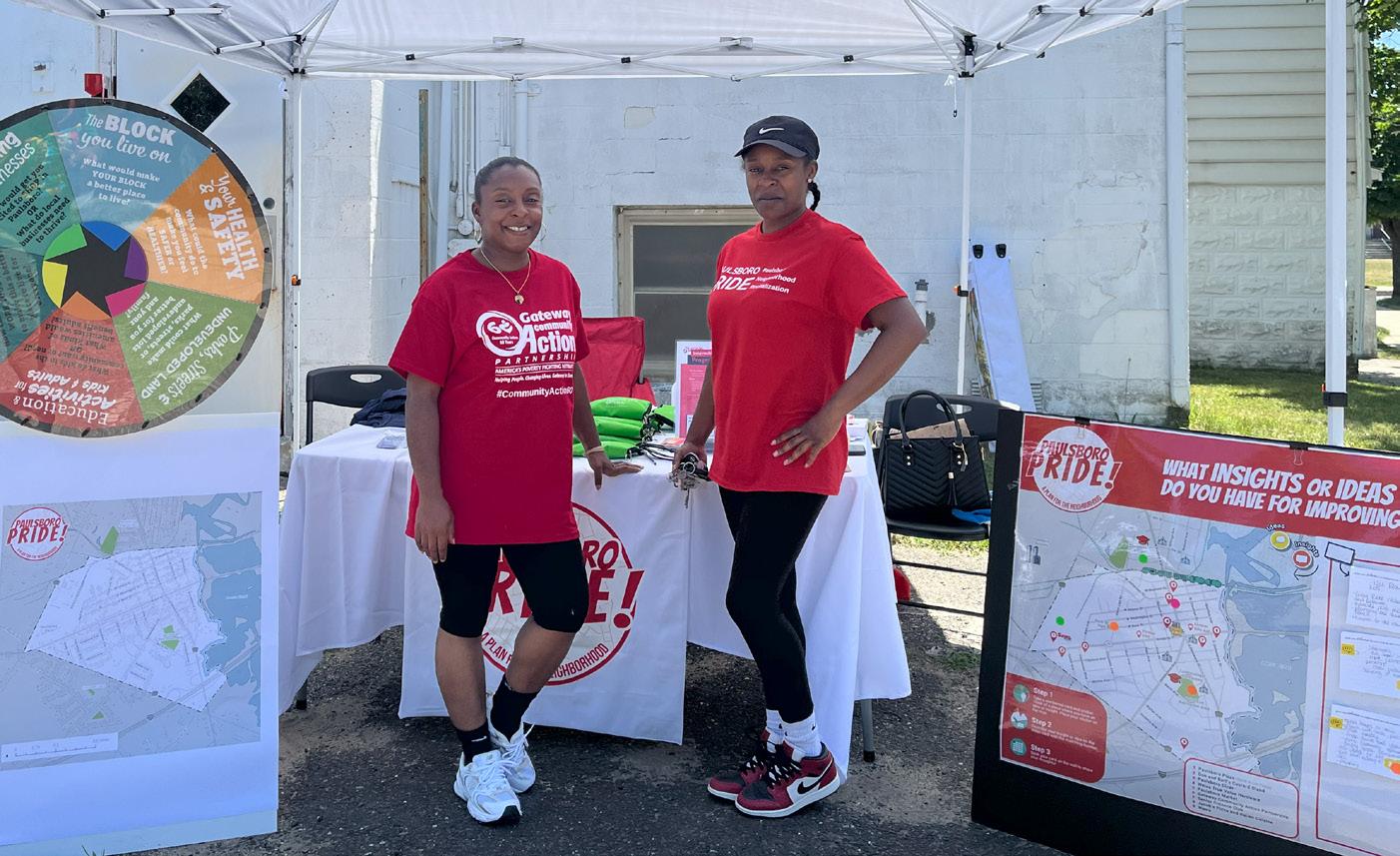

» BUCK ST PARK PLAYGROUND BUILD
» APRIL COMMUNITY MEETING
» COMMUNITY CLEAN-UP
» SBC AGAPE OPEN AIR MARKET
» SECOND BAPTIST RISE YOUTH EVENT
» JUNETEENTH EVENT
» JULY 4TH PARADE
» COMMUNITY MOVIE NIGHT
» LOUDENSLAGER BACK TO SCHOOL
» PAULSBORO DAY
» SBC TRUCK OR TREAT
» PAULSBORO COMMUNITY TRUCK OR TREAT EVENT
» PAULSBORO TREE LIGHTING CEREMONY
» PAULSBORO BLACK HISTORY MONTH PROGRAM
» COMMUNITY OPEN HOUSE EVENTS THE PAULSBORO PRIDE NEIGHBORHOOD PLAN TEAM POPPED UP AT EVENTS, INCLUDING:
SOCIAL MEDIA
The Paulsboro Pride Neighborhood Facebook and Instagram pages served as key platforms for sharing updates about the planning process and connecting with the community. These pages provided a direct line of communication between the project team and local residents. Steering Committee members and project staff also engaged with the community by posting to local groups and forums, asking key questions, and gathering valuable feedback from residents.
BUSINESS OWNERS
The project team drafted and mailed letters to 25 local businesses located within the Paulsboro Pride Neighborhood. The team conducted phone interviews with seven local business owners, asking a series of questions to gather feedback on their experiences owning and operating a business in Paulsboro. Additionally, the team developed a business owner survey to collect input from a broader range of local businesses within the community.
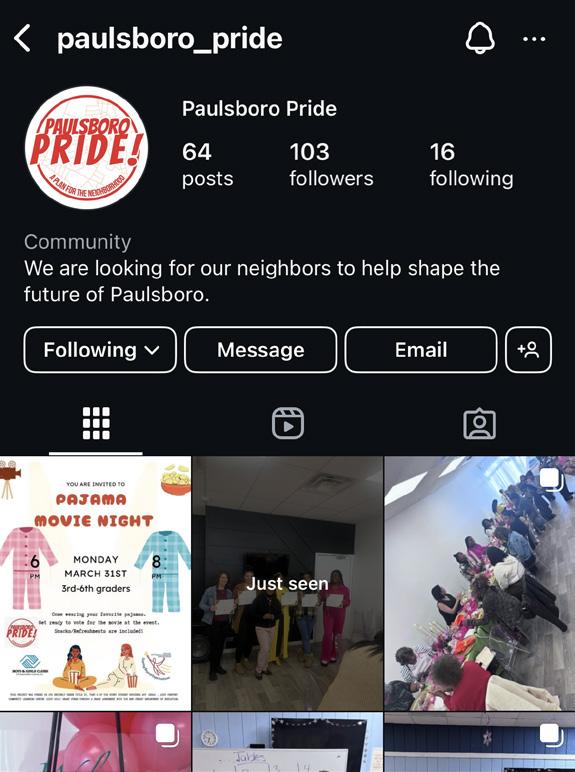
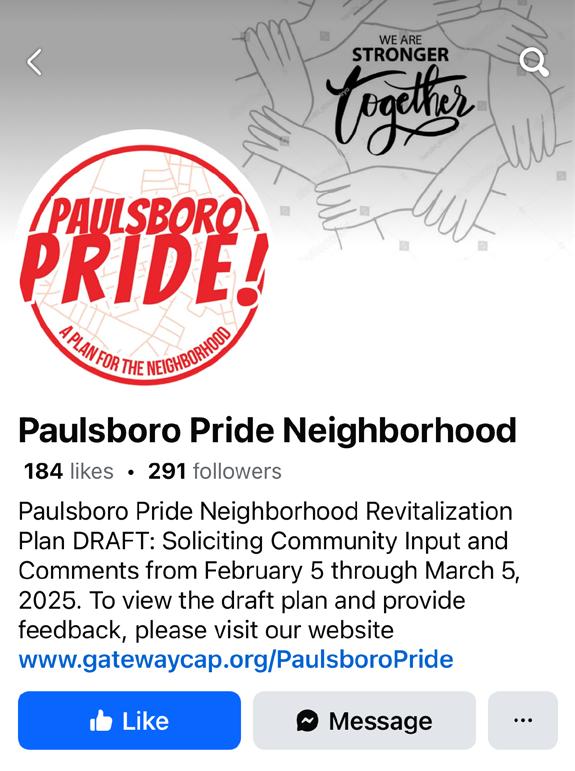

YOUTH ENGAGEMENT
During the planning process, it became evident that gathering input from youth and young adults was essential to effectively plan for the future of the community. To achieve this, the project team hosted a series of youth engagement activities to hear their thoughts and perspectives on community improvement. In addition to providing a platform for young residents to share their ideas, these activities aimed to educate them about community planning and civic engagement. The Paulsboro Pride Neighborhood Plan empowered youth to meaningfully advocate for change and actively participate in shaping the future of their community.

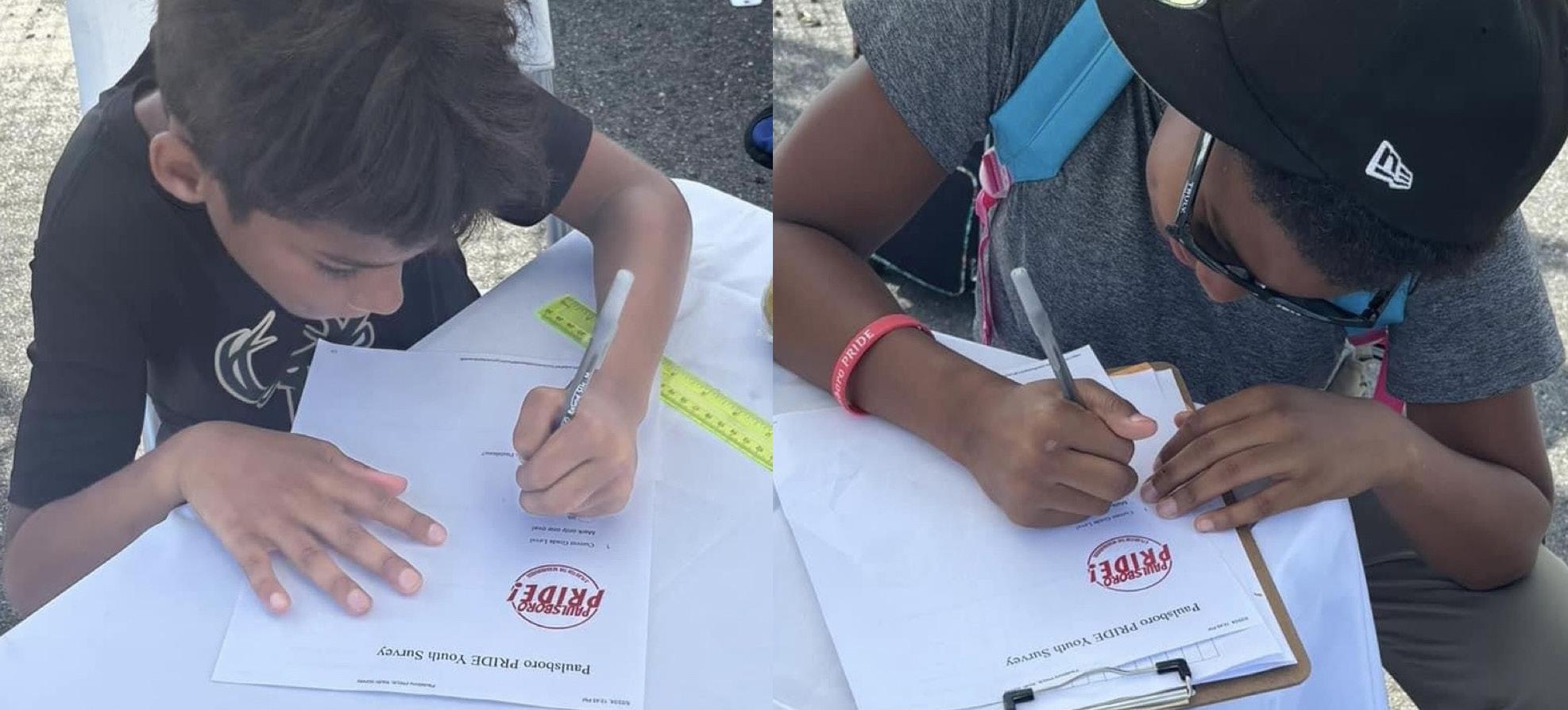

SUMMER YOUTH PLANNING CAMP
In the summer of 2024, ten youth aged 11 to 14 participated in a unique summer program designed to teach junior high school students about the community of Paulsboro, the significance of neighborhood planning, and how they can contribute to various projects throughout the community.
Community Planning 101 Workshop:
The students took part in a workshop focused on the fundamentals of the community planning process. The session emphasized the importance of creating a resident-driven plan and highlighted the critical role of youth voices in shaping the Neighborhood Plan. Through this workshop, participants gained a deeper understanding of why their input—and that of their peers—matters in building a better future for Paulsboro.
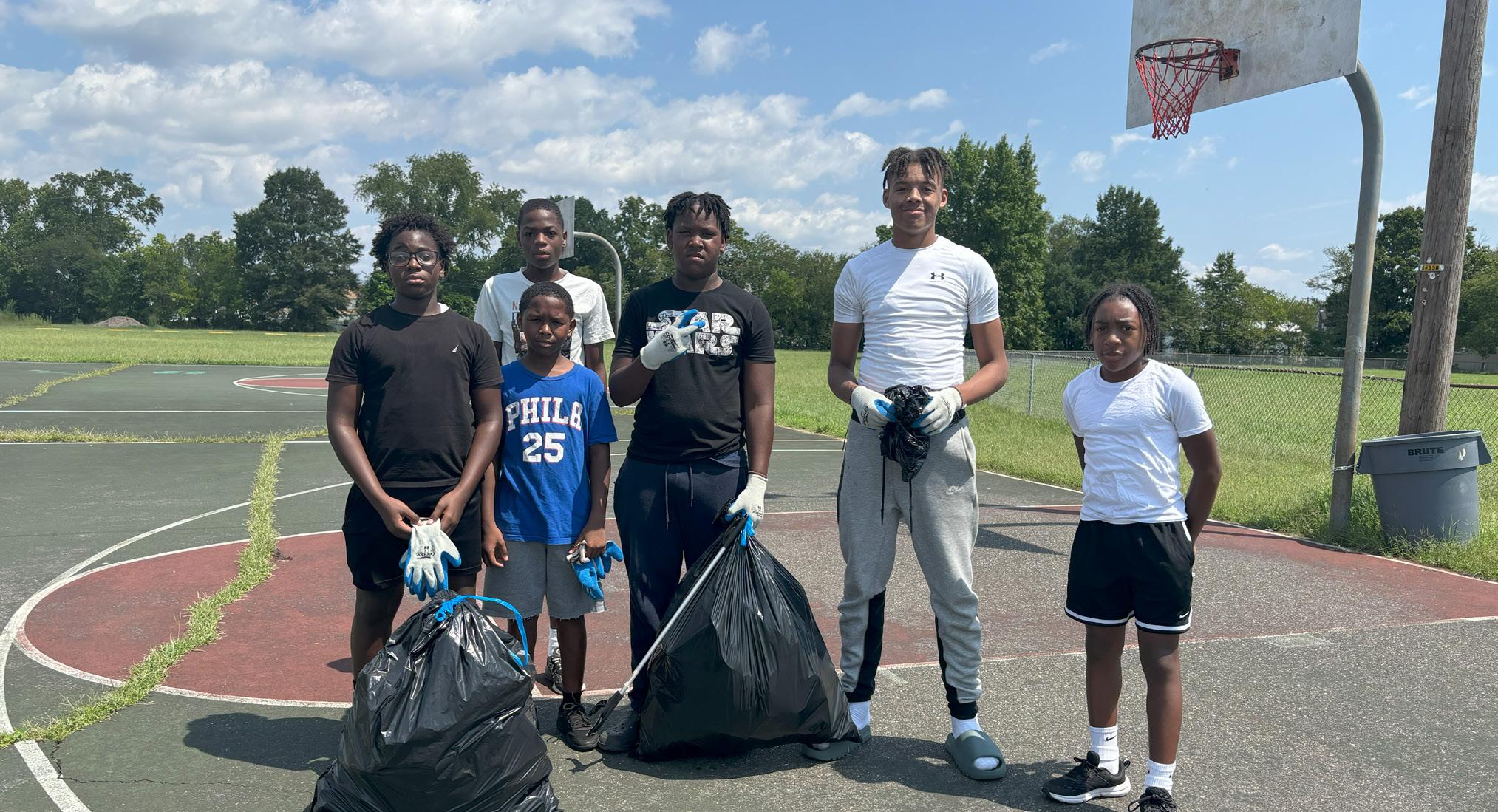

Community Walk:
The students also participated in a two-day community walk throughout the neighborhood. During the walk, the planning team engaged the youth in discussions about their visions and aspirations for changes in the community. The students had an opportunity to interact with residents, share information about the Neighborhood Plan, and encourage participation in the neighborhood survey. This activity allowed the youth to see their community through a planning lens while fostering direct community engagement.
Visioning Exercise:
During the community walk, the students identified a specific area in need of improvement: the public basketball courts. These courts are marred by cracks, overgrown grass sprouting through the concrete, faded paint, and litter strewn across the area. Recognizing the urgent need for cleanup, the youth dedicated an afternoon to removing trash and debris. Following the cleanup, they brainstormed creative ideas to revitalize the site, including the adjacent vacant lot that once housed a baseball field. Their vision included improved basketball courts in an enclosed space, a community pool, and a recreation facility offering exercise and activity spaces for residents.
Figure 1.7: Grade of Youth Survey Respondents
Grade of Youth
Grade of Youth
Respondents
YOUTH SURVEYS
The Paulsboro Pride Neighborhood Plan team, with support from summer interns, developed a youth survey using questions provided by Success Measures. Over 100 youth participated in the survey, offering valuable insights into their priorities and aspirations for the community.
You never know what someone’s going through behind closed doors. “ ”
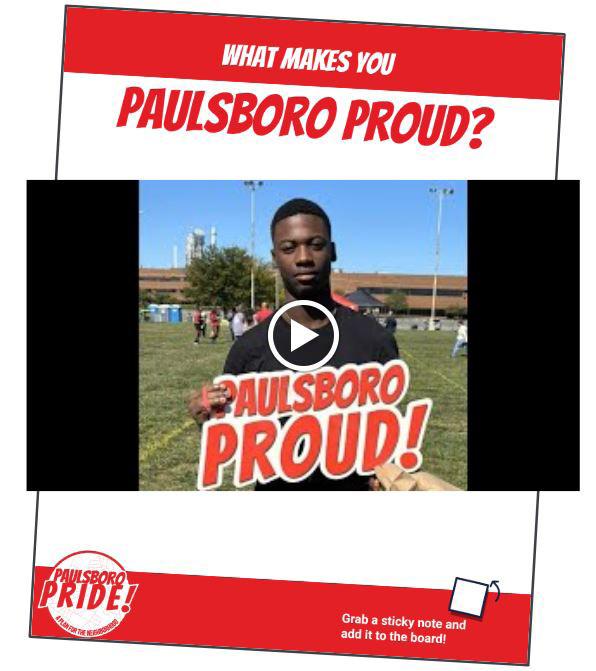
PAULSBORO PROUD COMMUNITY VIDEO
PROJECT
Throughout the summer, participants in the Summer Youth Planning Camp created a video titled Paulsboro Proud. The project involved filming short clips of various community members, capturing their responses to the question, “What makes you PROUD to be from Paulsboro?” The students gathered these mini-interviews at summer pop-up events, sporting activities, and local church gatherings, engaging both youth and adults to share their perspectives.
Screenshot of the Paulsboro Proud Community Video Project.
SUMMER TEEN COMMUNITY MAPPING/
NEIGHBORHOOD CONDITIONS PROJECT
Over the course of four weeks, ten high school students participated in a project focused on surveying and documenting the current conditions of their community. The students were divided into groups, with each group assigned a specific area or block to survey. Prior to starting the project, the students attended an orientation session where they received training on how to complete the survey forms.
Under the guidance of their mentors, each group walked their assigned block, conducted a visual inventory, and recorded key issues or noteworthy observations on the provided forms. At the conclusion of the project, the entire group reconvened to share their insights and reflections on what they had observed during their time exploring the community.
Teens highlighted several key issues in the community:
• Numerous streetlights were out, leaving streets very dark at night.
• Many sidewalks were in poor condition and required repairs.
• Privately owned vacant lots were poorly maintained, with overgrown grass and litter.
• Trash and litter were prevalent on many streets.
• Potholes and damaged streets were common and in need of repair.
• Sidewalks were frequently obstructed by overgrown grass, parked cars, and other barriers.
• Vacant homes across the community were not well maintained.
• Many homes in the area were surrounded by trash and debris.

COMMUNITY OPEN HOUSE
The project team hosted a series of community open houses to review the draft plan and strategies. The events were held at multiple locations to reach as many community members as possible, including the Second Baptist Church, Gateway CAP, Mt. Carmel UAME Church, the Paulsboro Senior Citizens Center, and Gill Memorial Library, as well as two youth events at the Boys and Girls Club. During the events, attendees were asked to review the proposed strategies displayed on boards and were given stickers to indicate which strategies they thought should be prioritized.
Attendees overwhelmingly supported the “Invest in Paulsboro’s civic assets and public spaces” strategy, receiving the most stickers out of all of the strategies, while other strategies, such as “Host a variety of events throughout the year that bring Paulsboro residents together” and “Create support programs to help prospective homeowners and renters” also received a significant amount of support as the #2 and #3 most voted for recommendations.



Figure 1.8:

Key Findings from Engagement & Data Analysis
A CLOSE-KNIT COMMUNITY
THAT’S FRAYING AT THE EDGES
Paulsboro’s pride is reflected in the social ties of the community. 52% of people who took the neighborhood survey said the “friendliness of neighbors in the community” was good or very good in Paulsboro. For a community that has also perceived a decline in previous years of the neighborhood quality, this is a uniquely high figure and speaks volumes to the community’s historically tightly woven bonds.
Despite this history of strong community ties, current neighborhood conditions have negatively impacted residents’ perception of Paulsboro. When evaluating residents’ perceptions of the neighborhood’s recent past and future, 55% of respondents to the Success Measures Community Survey said that the community has declined in the past 3 years. Residents are slightly more optimistic about the future with 33% saying they believe the community will improve.
Figure
1.9: Perceptions of the Recent Past & Future
Success Measures of Community Survey, 2024

I’m in my 50’s and went to high school here. I’m still friends with people from high school. The tight-knit relationships created in Paulsboro are unique and powerful. Our community and relationships are extraordinary.
CHALLENGES FOR FAMILIES AND YOUTH
One of the key reasons residents who moved to, and stayed in Paulsboro over the years is the community’s reputation as a great place to raise a family. In Paulsboro, kids are the core of the community. As of the last decennial census in 2020, the child care population (under 5) makes up 7% of the community and the school age population (5 to 24) accounts for 30% of the population. However, these figures are a slight decline from where the community stood ten years prior in 2010, indicating that the share of the neighborhood’s population that is made up of families is declining.
This result tracks with issues related to kids and families heard throughout the engagement process. Overall, there is a strong desire to see more activities and places to go for kids, issues that were raised by participants of all age groups. Additionally, there is strong evidence that a lack of spaces and programs for kids is a major obstacle that needs to be addressed. The Success Measures Community Survey found that 67% of respondents leave the community to visit parks, playgrounds, or other green spaces. Additionally, when asked what types of businesses or services residents would like to see in their community, an exercise or recreation facility was one of the top three choices selected in by survey respondents among a long list of choices, something that was echoed in the pop-up engagement sessions and community conversations.
Figure 1.10: Population by Age
Decennial Census 2020, Gateway CAP Neighborhood Trends Report
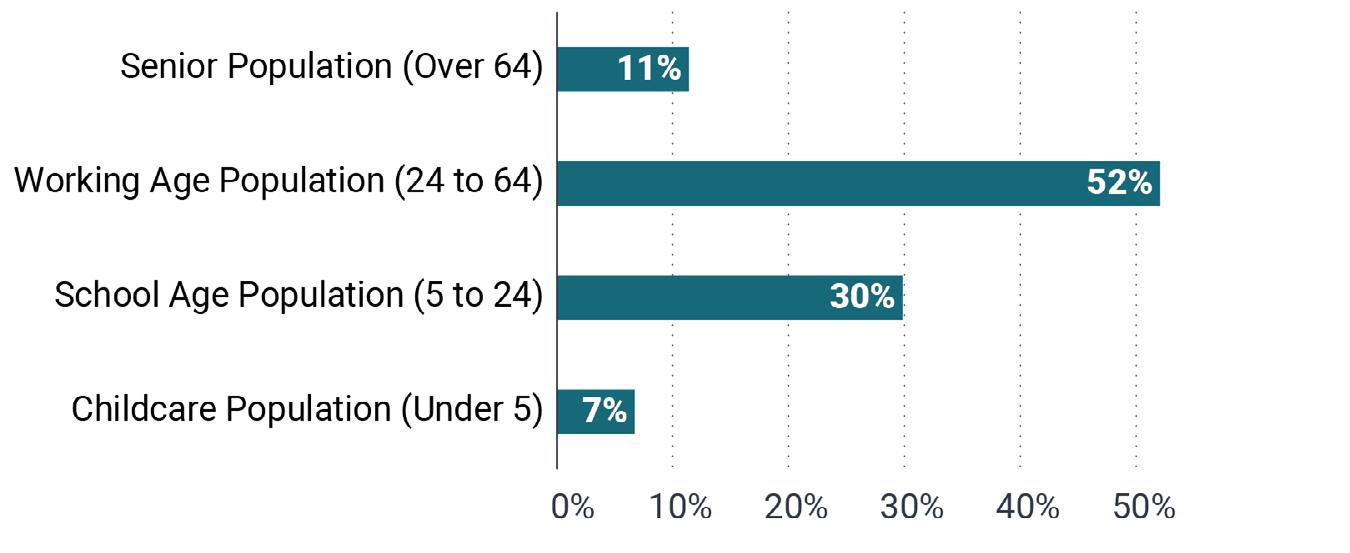
1.11: Houshold by Type
ACS 5-Year Estimates, 2017-2021, Gateway CAP Neighborhood Trends Report
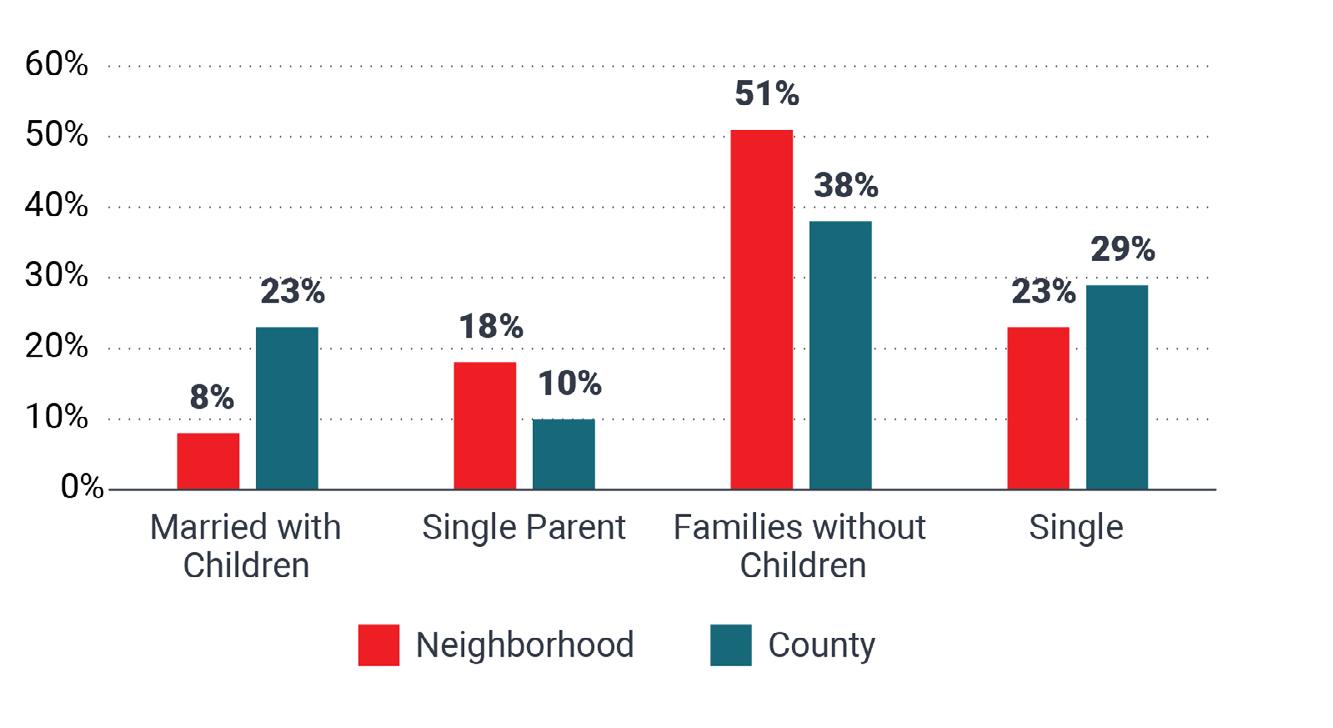
There used to be more job opportunities for kids, especially during the summer. Now there’s nothing much to do.
Figure
SERIOUS CONCERNS ABOUT CRIME AND
SAFETY
Concerns around crime and safety in the community have worsened in recent years. According to the results of the Success Measures Community Survey, 67% of residents rated safety in the community as fair, poor, or very poor, highlighting a widespread sense of unease. Overall, the primary concerns centered around the rise of violent crime and gun violence, persistent crime hotspots, safety walking around the community, and quality-of-life issues.
Incidences of violent crime in Paulsboro have more than doubled since the start of the pandemic, increasing from an average of 4.9 violent crimes per month in the period of Dec. 2019-2020 to 12.4 violent crimes per month during the period of Dec. 2022-2023. Clearance rates, which are a measure of crimes “cleared” or solved by police, similarly dropped from a rate of 64.8% to 51.9% during the same time period.
The serious nature of violent crimes additionally means that headline-grabbing crimes are potentially fueling perceptions, both internally and externally, that Paulsboro is a dangerous community, and not the safe and welcoming family-oriented community it was once known as.
It is important to note however that issues of safety are not only limited to the purview of policing, but can be influenced by environmental factors such as the quality and availability of safe and supportive places to go, the quality of public infrastructure, and the presence of vacant and run-down properties. The Youth Survey, which was fielded to students in 3rd through 12th grade, found that when students were asked how the community could be safer for school-aged kids, a majority of responses (65.1%) focused on aspects of the physical environment as key areas for improvement.
“ ”
There was so much violence during covid and no communication...we felt like sitting ducks.
Figure 1.12: All Violent Crimes and Clearance Rates (2019-2023)
FBI Crime Data Explorer. Source: Reported Summary Reporting System (SRS) data from Paulsboro Police Department Data Last Updated 04/15/2024. Accessed 12/22/2024: https://cde.ucr.cjis.gov/LATEST/webapp/#/pages/explorer/crime/crime-trend
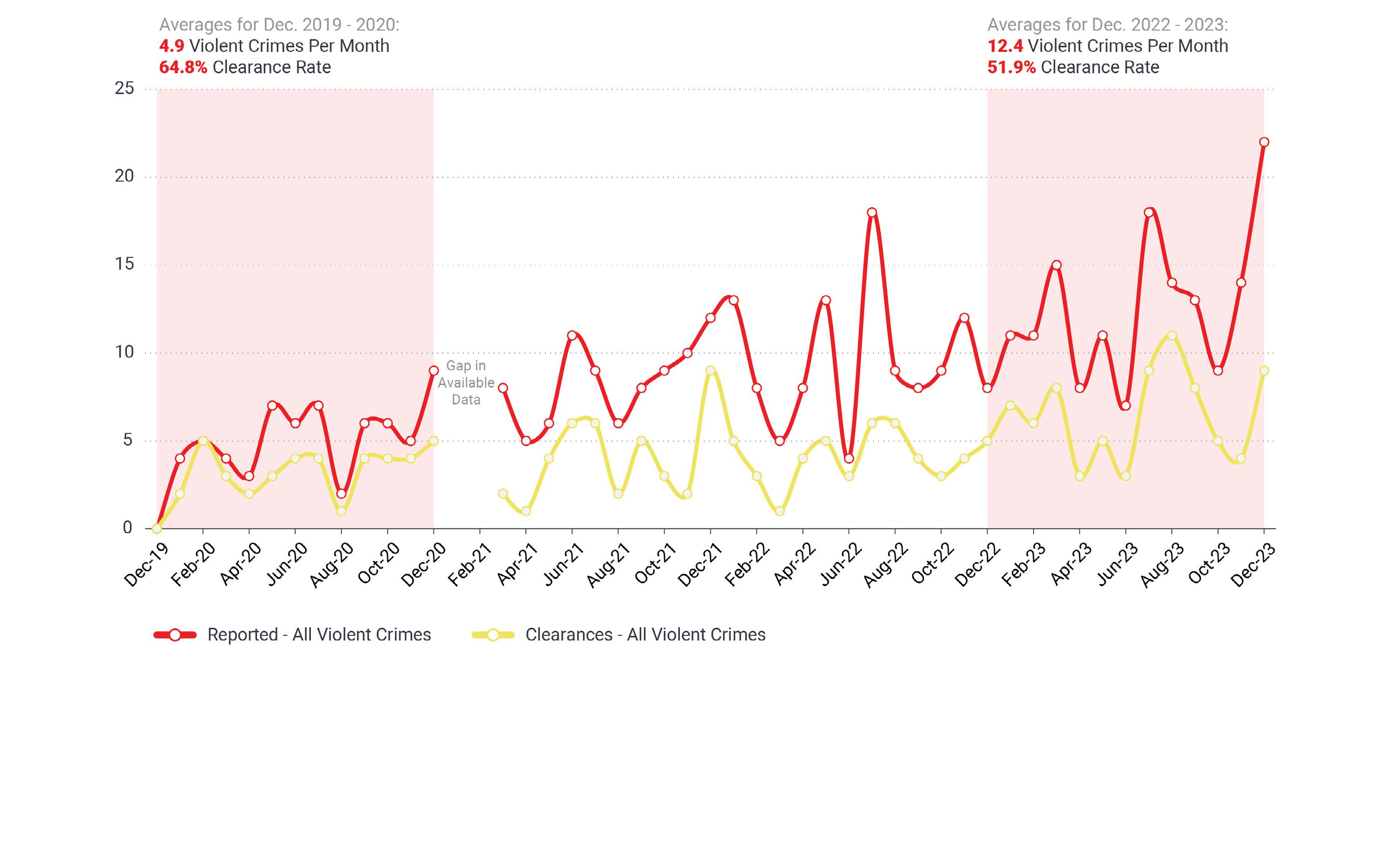
The most common safety issue highlighted by students was the need for better street lights (23.2% of respondents to the Youth Survey). A Block Conditions Survey that recorded information about public infrastructure, cleanliness, and attractiveness throughout the Paulsboro Pride Neighborhood recorded poorly maintained sidewalks and street lighting along 37% of the blocks surveyed. The highest concentrations of poorly maintained street lighting were found along the “Presidential Streets”, as well as in residential areas south of Broad Street and surrounding Loudenslager Elementary School and the Baird Ave Recreation Area.
Issues around lighting and the community’s sense of safety walking in the community were further confirmed by the Success Measures Community Survey. While 83% of community survey participants wrote that they feel safe walking in the community during the daytime, only 47% of survey participants expressed feeling safe at night time.
Figure 1.13: Perception of Safety While Walking in the Community Success Measures Community Survey, 2024

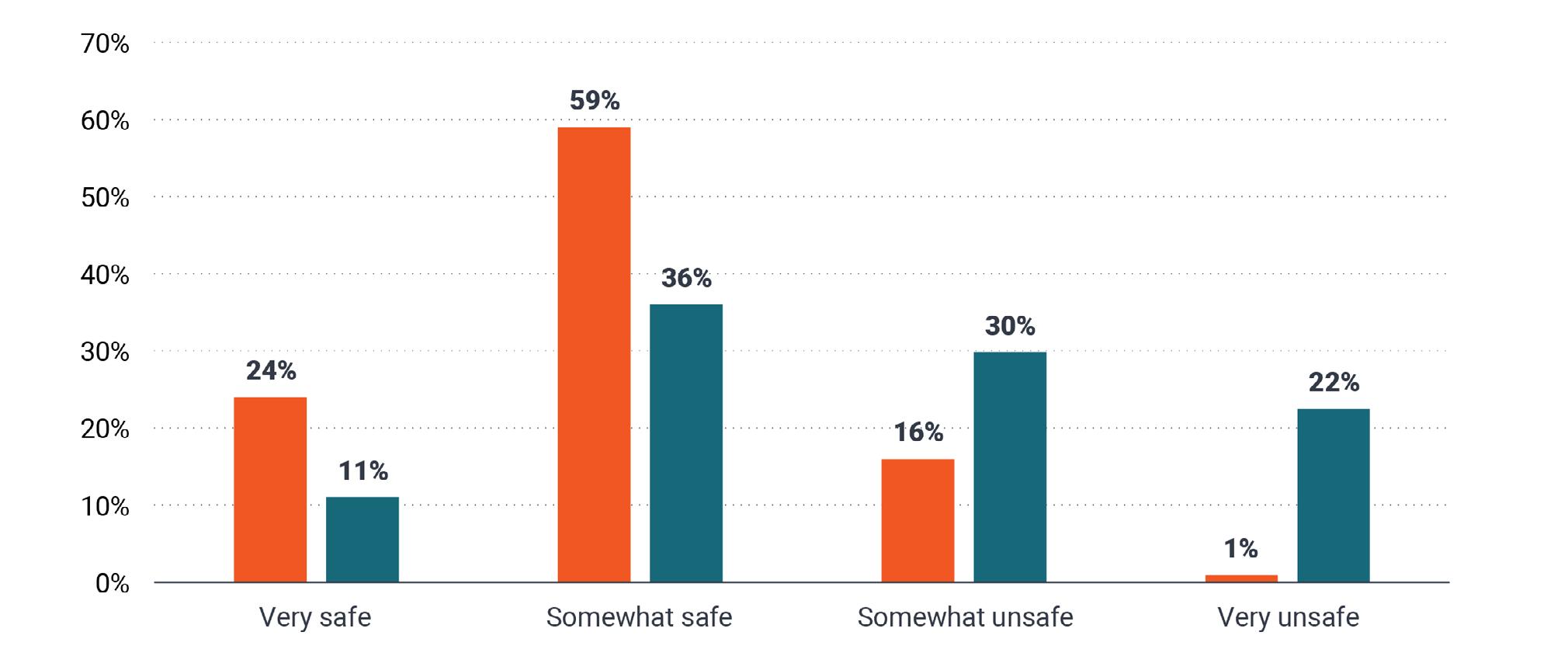

Figure 1.14: Street Light Conditions
2024 Block Conditions Survey

QUALITY OF LIFE ISSUES, SUCH AS TRASH,
VACANT LOTS, AND BEAUTIFICATION, TAKE CENTER STAGE
Issues around trash, dumping, litter, and beautification have become increasingly urgent concerns in the Paulsboro Pride Neighborhood. Trash collection in particular is a public service that needs immediate attention. 53% of respondents to the Success Measure Community Survey ranked trash collection as Poor or Very Poor. The issue is so important to residents that many reached out to ask why there weren’t more questions on the community survey about trash and recycling services.
The Block Conditions Survey similarly found higher concentrations of trash and debris along the Presidential Streets and the commercial corridors of Broad and Delaware Streets. Both the prevalence of vacant lots and density of housing could be contributing to higher levels of trash and debris in these areas due to recent changes in how trash pickup and recycling are handled. Paulsboro residents are now limited to using a single 50-lb can for weekly trash pickup, which has led to issues
Residents also noted the prevalence of vacant lots and homes in the community as issues. According to the U.S. Census’s 5-Year 2018-2022 estimates, the Paulsboro Pride Neighborhood has a 15% household vacancy rate.
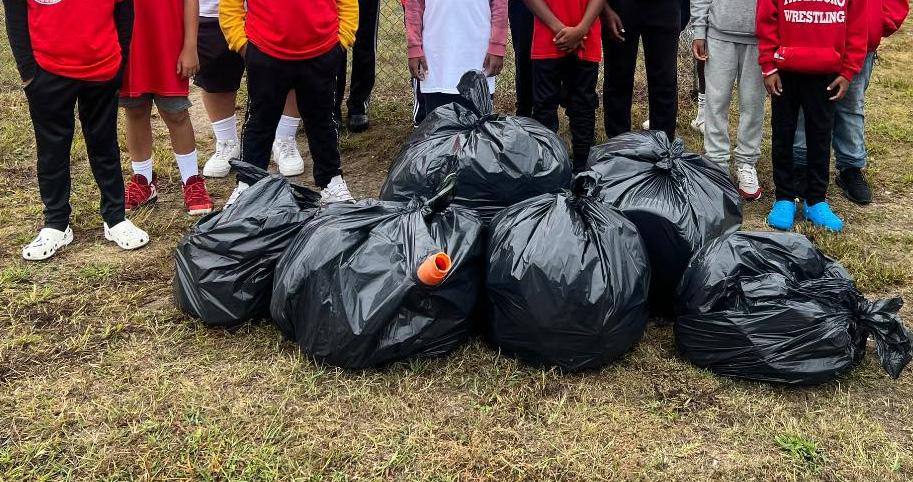
Trash and debris collected from youth community cleanup.
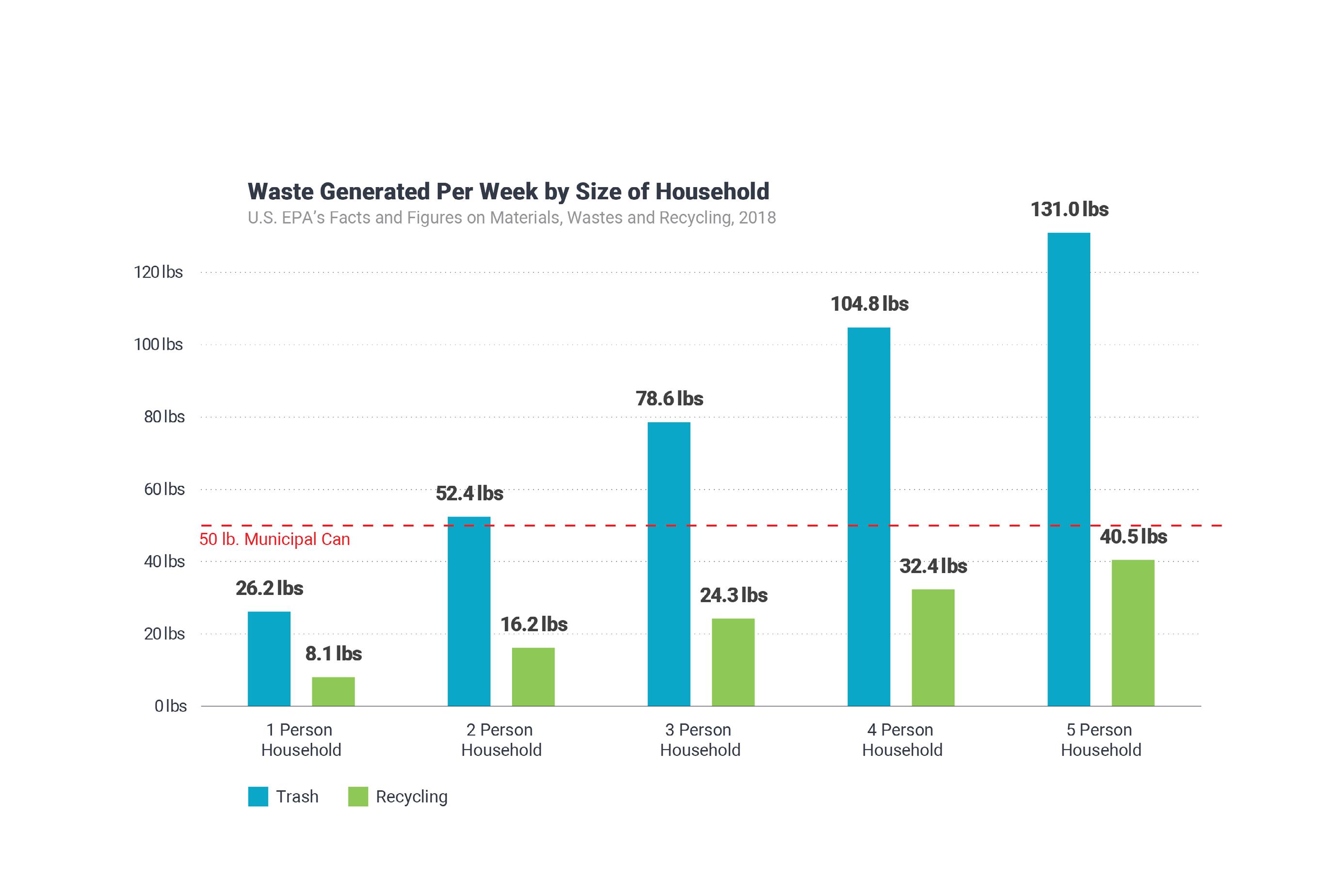
1.15: Waste Generated Per Week by Size of Household
U.S. EPA’s Facts and Figures on Materials, Wastes and Recycling, 2018
Figure
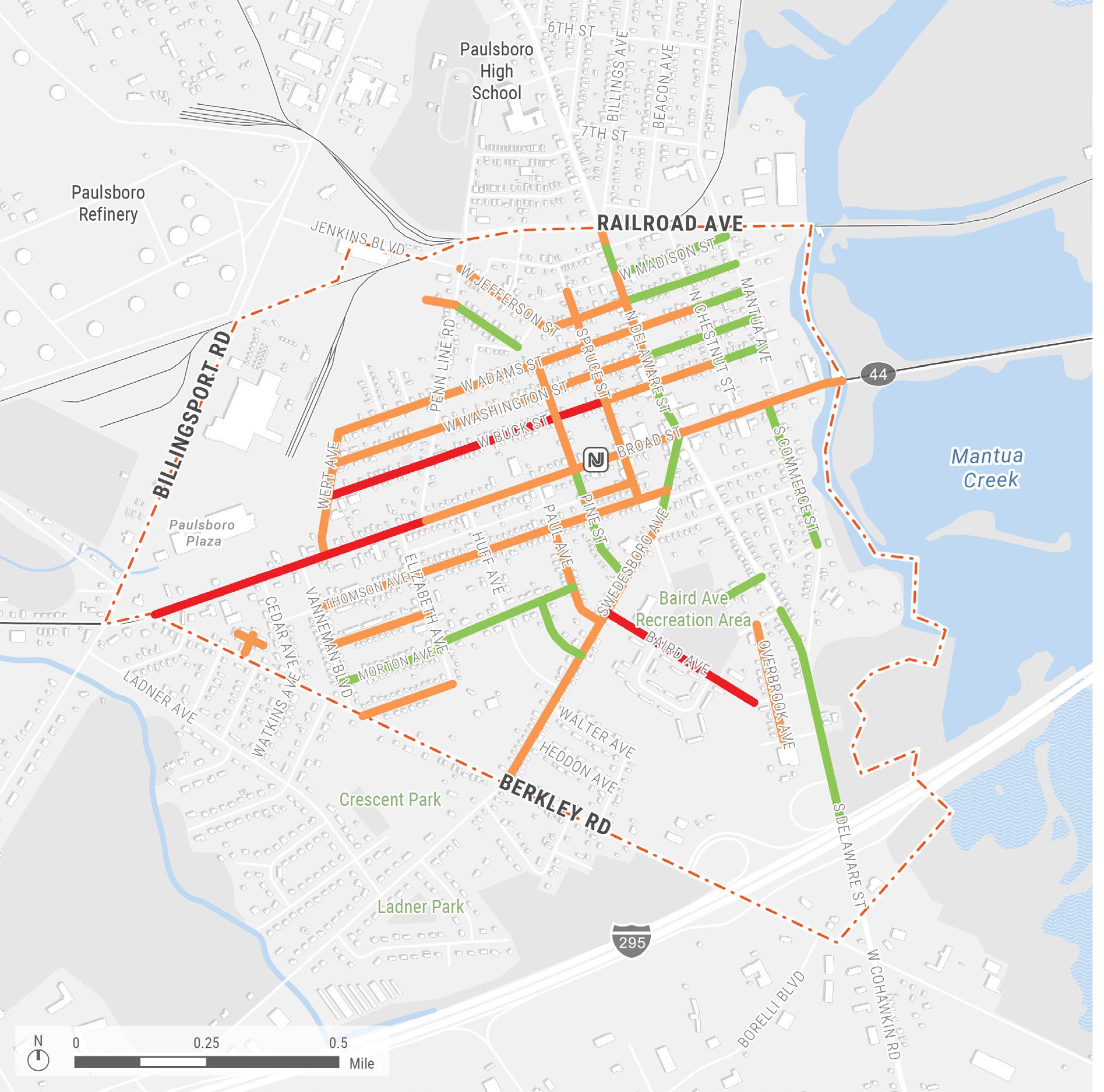

Figure
ENVIRONMENTAL ISSUES THREATEN
LONG-TERM HEALTH
Over the past few decades, environmental issues have plagued Paulsboro residents, most notably through water contamination and air pollution. Paulsboro’s waterfront has long been the site of heavy industry, and, according to the EPA’s 2012 Toxic Release Inventory, the Paulsboro Refining Co. dumped 800,000 pounds of toxins into the Woodbury Creek Watershed, which feeds into the Delaware River, making it the 3rd worst polluter in the state. On top of that, in that same year, a train transporting vinyl chloride derailed over Mantua Creek, dumping 23,000 gallons of the toxic gas into the air and water. In 2013, tests conducted on the drinking water from the Paulsboro Public Water System found high levels of PFAS, also known as “forever chemicals” that are linked to increased cancer rates. To reduce the level of contaminants, the Paulsboro Public Water System has been using specialized filters to remove PFAS from the drinking water since 2016. However, those exposed to PFAS prior to the introduction of the filters may still experience adverse health effects now and in the future.
Luckily, there are several initiatives underway to better understand the potential health effects from environmental contamination on Paulsboro’s residents. In 2021, the Rutgers Environmental and Occupational Health Sciences Institute began a study of the health effects from PFAS in Paulsboro’s drinking water, recruiting community members to evaluate their PFAS blood levels and other health measures. Additionally, with the passage of New Jersey’s Environmental Justice Law in 2020, Paulsboro is
now listed as an “Overburdened Community”, which refers to any census block groups with at least 35% low-income households, at least 40% minority residents or members of a tribal community, or at least 40% of households with limited English proficiency. In accordance with the Environmental Justice Rules, any existing or proposed facilities located adjacent to these communities may be required to conduct further analysis. While these efforts provide a sense of hope for the future, neither will eliminate past environmental harms, and residents will still have to contend with the impacts of living adjacent to heavy industry.

2012 train derailment near Mantua Creek (Source: South Jersey Times/Rae Lynn Stevenson)
AN INCREASINGLY PRECARIOUS HOUSING
SITUATION FOR BOTH RENTERS AND HOMEOWNERS
The Paulsboro Pride Neighborhood has seen a declining homeownership rate. Between 2010 and 2020, the community’s homeownership rate dropped by eight percentage points, and resulting in a rental rate of 60%.
A high share of households (both owners and renters) in the Paulsboro Pride Neighborhood are also cost-burdened. Typically, households should spend less than 30% of their income on housing costs. Those that spend more than 30% are considered cost-burdened, and those that spend more than 50% of their income on housing costs are considered extremely costburdened. As of 2021, 38% of households in the community were cost-burdened and 13% were extremely cost-burdened.
This data on cost-burdened households was largely confirmed by the results of the Success Measures Community Survey, which found that 56% of residents (both owners and renters) in the Paulsboro Pride Neighborhood experience periodic financial instability in meeting their housing expenses.
Despite this, renters in Paulsboro, an increasingly large population, stay in the community for years (75% of renters have rented here more than 5 years according to the Community Survey) and aspire to buy homes in the neighborhood.
Figure 1.17: Change in Homeownership Rate (2010-2020)
Decennial Census 2010 and 2020, Gateway CAP Neighborhood Trends Report

Figure 1.18: Housing Cost Burden for Owners and Renters
ACS 5-Year Estimates 2017-2021, Gateway CAP Neighborhood Trends Report
Housing in Paulsboro is advertised as a pitstop. There’s not enough of anything to help encourage people to want to stay here. “ ”
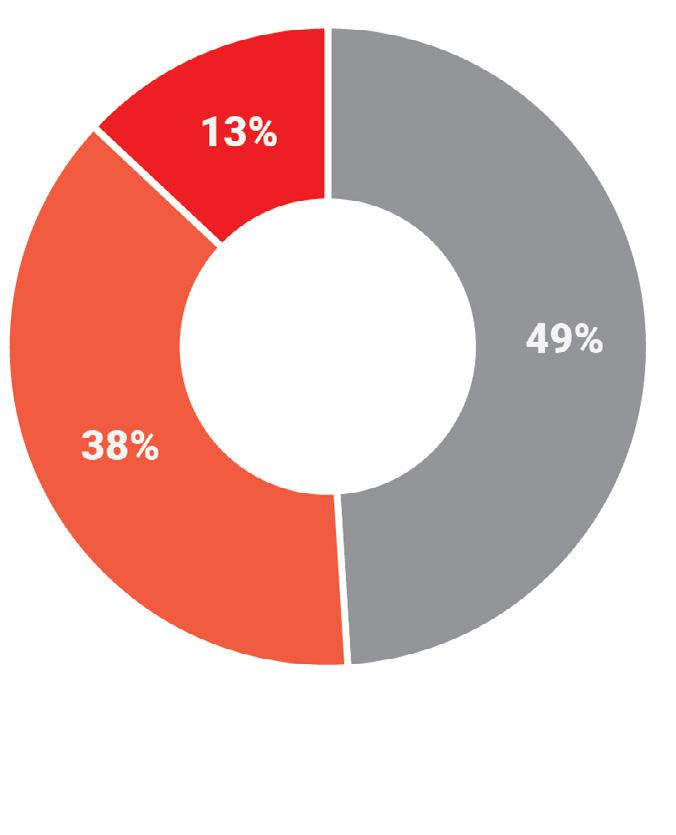

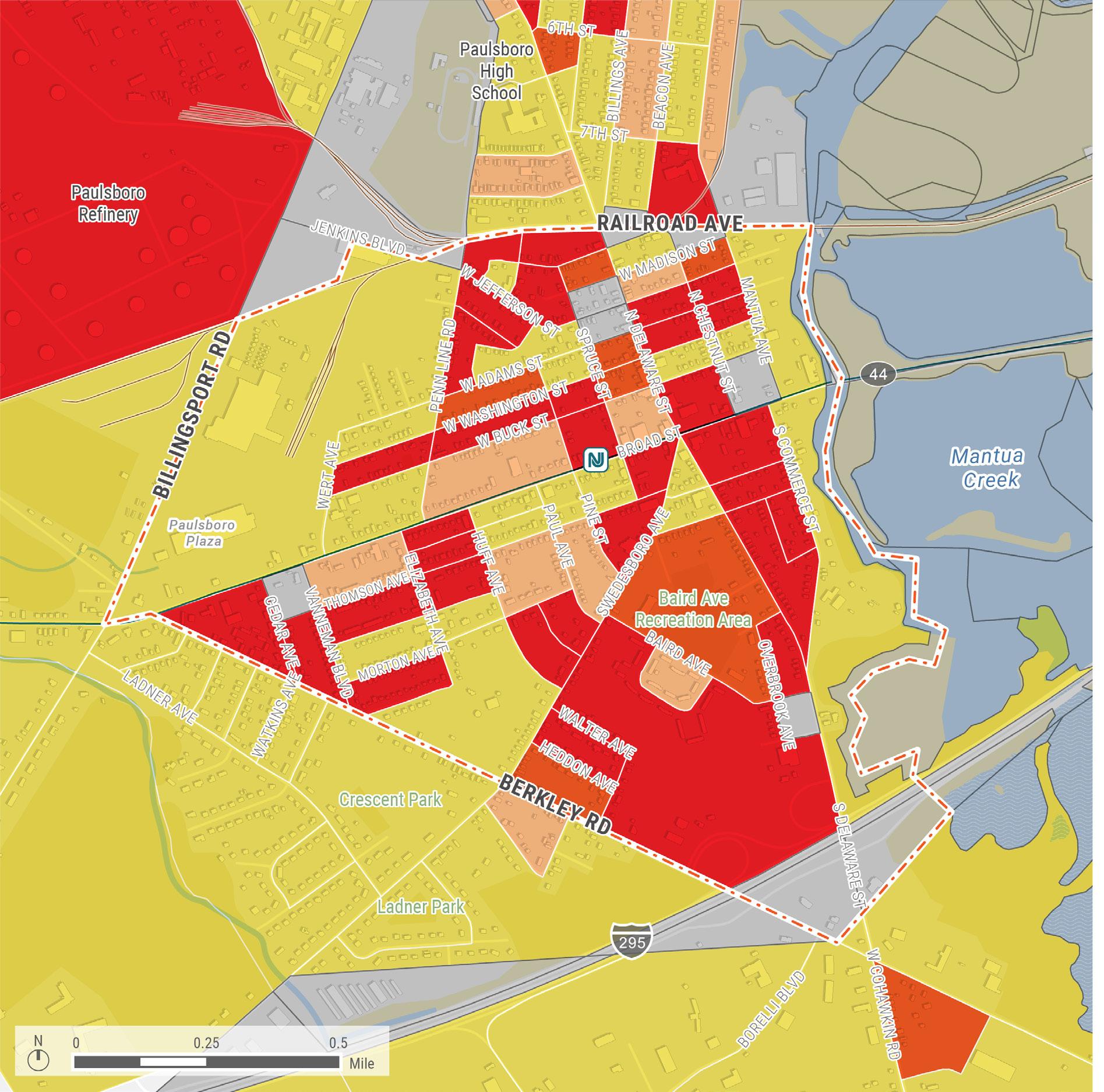
Figure 1.19: Percentage of Households That Are Renter-Occupied
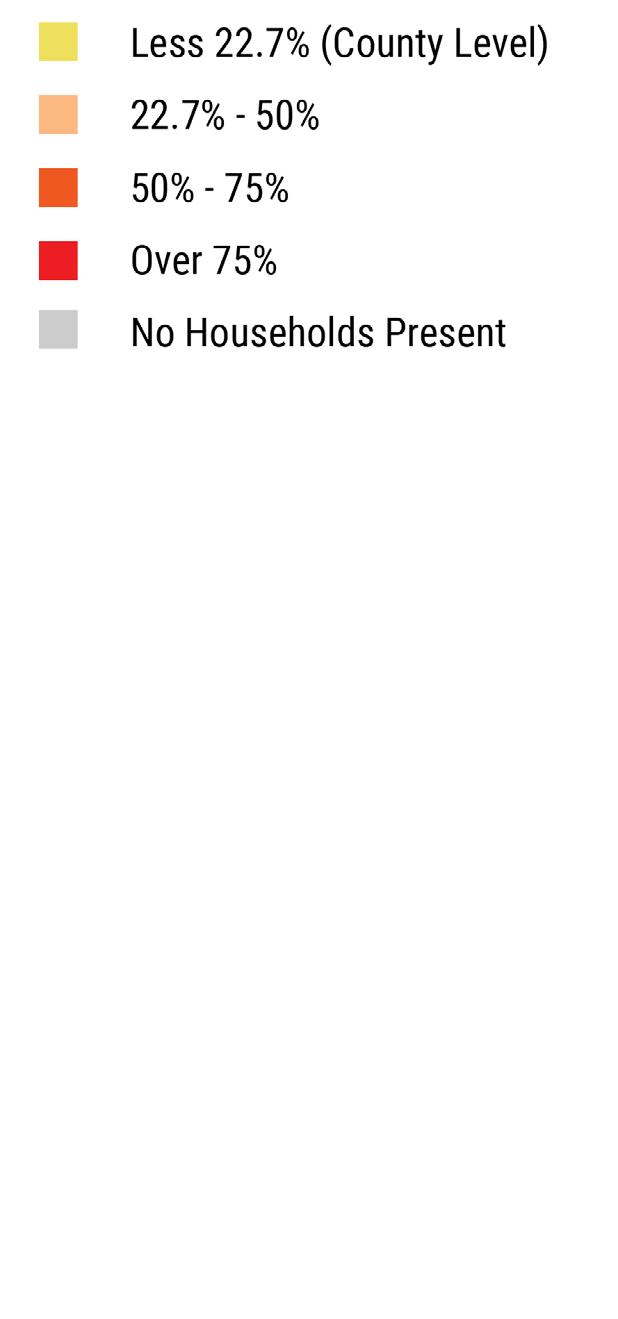
A NEED FOR BETTER EDUCATIONAL
OPPORTUNITIES
Education is a key concern for many residents of the Paulsboro Pride Neighborhood. On multiple metrics, current Paulsboro students are falling behind State educational standards. Only 12.1% of Paulsboro students have met or exceeded expectations on statewide assessments for English language arts, and less than 10% have met or exceeded expectations for mathematics. The four-year graduation rate in Paulsboro is 87.3% and the five-year graduation rate is 85.2%, rates which are approximately 4% and 7.5% behind State educational standards.
As a whole, residents in the Paulsboro Pride Neighborhood have lower educational attainment rates when compared to the rest of Gloucester County. Just 16% of residents completed a bachelor’s degree or higher, compared to 23% across the County. Around half of residents have only completed high school, while 8% received less than a high school education.
Educational attainment and levels of employment are often related, and unemployment data similarly shows a disparity between the Paulsboro Pride Neighborhood and Gloucester County. The unemployment rate for the Paulsboro Pride Neighborhood was 4x the rate of Gloucester County (26% vs. 6%).
Opportunities for work within (or within a short commuting distance) of Paulsboro may also be contributing to higher unemployment rates. The two most common industries Paulsboro residents work in are healthcare and social assistance (15%) and retail trade (14%). For both industries, there are few opportunities for residents who want to work in the borough, and getting to these jobs requires long commutes by bus for those who don’t have access to a car.
They don’t see a path in life, they just see the corners. “ ”
Figure 1.20: Median Student Growth Percentile for English Language Arts (ELA) and Mathematics
State of New Jersey Department of Education. NJ School Performance Report for Paulsboro School District (15-4020), 2022-2023

Figure 1.21: Percentage of Students Who Met or Exceeded Expectations on Statewide Assessments
State of New Jersey Department of Education. NJ School Performance Report for Paulsboro School District (15-4020), 2022-2023

Figure 1.22: Percentage of Students Who Graduate High School Within Four or Five Years of Entering High School
State of New Jersey Department of Education. NJ School Performance Report for Paulsboro School District (15-4020), 2022-2023

A LACK OF LOCAL BUSINESSES, SERVICES, AND FOOD INSECURITY
Many long-time residents throughout this process have noted an absence of local businesses on the main commercial streets and the recent loss of the two national pharmacy chains (a nationwide trend) that the community has relied on. Today, 50% of the survey respondents rated the variety of goods and services available in their community as poor or very poor, and leave town for their basic services and needs like medical care, or have to go without them.
While commercial businesses can be found scattered throughout the Paulsboro Pride Neighborhood, the core concentrations of commercial activity are along the Broad Street & Delaware Avenue corridors at the east of the study area, and the Paulsboro Plaza shopping center area (and surrounding parcels) at the western edge of the neighborhood. Both face different challenges, and present different opportunities for revitalization. Properties along the Broad Street & Delaware Avenue corridors are characterized by their historic nature, walkability, and size that make them suitable for stores, restaurants, and other types of small businesses. Paulsboro Plaza was built to accommodate a generous amount of parking for the automobile-age, and for years has had excess space to fill - both in terms of building vacancies and pad sites along Broad Street that were never developed.
The lack of businesses and services is especially acute in Paulsboro for residents who don’t own a car. For purposes of illustration, a theoretical resident on Washington Street used to be able to walk 5 minutes to the CVS on Broad Street. Without a car, getting to the next nearest CVS in West Deptford on a typical afternoon (a 15 minute drive) could take anywhere from an hour or two given hour-long headways between buses and a transfer from the 455 to the 412 line. Getting to Rite Aid, located closer in neighboring Gibbstown, can take a half hour by bus compared to a drive time of 5 minutes.
Paulsboro is one of 50 communities across the State of New Jersey that an analysis by the Economic Development Authority has found to be a food desert, which looks at the absence of supermarkets, poor public transit, low internet use, and high-poverty rates. Paulsboro is the only community in Gloucester County to be ranked as a food desert by the State. More than a third of households in the Paulsboro Pride Neighborhood are experiencing food insecurity, and this number increases for family households with more children, according to the neighborhood survey.
The empty Rite-Aid is problematic. Instead of tearing down buildings, we should focus on re-purposing them.
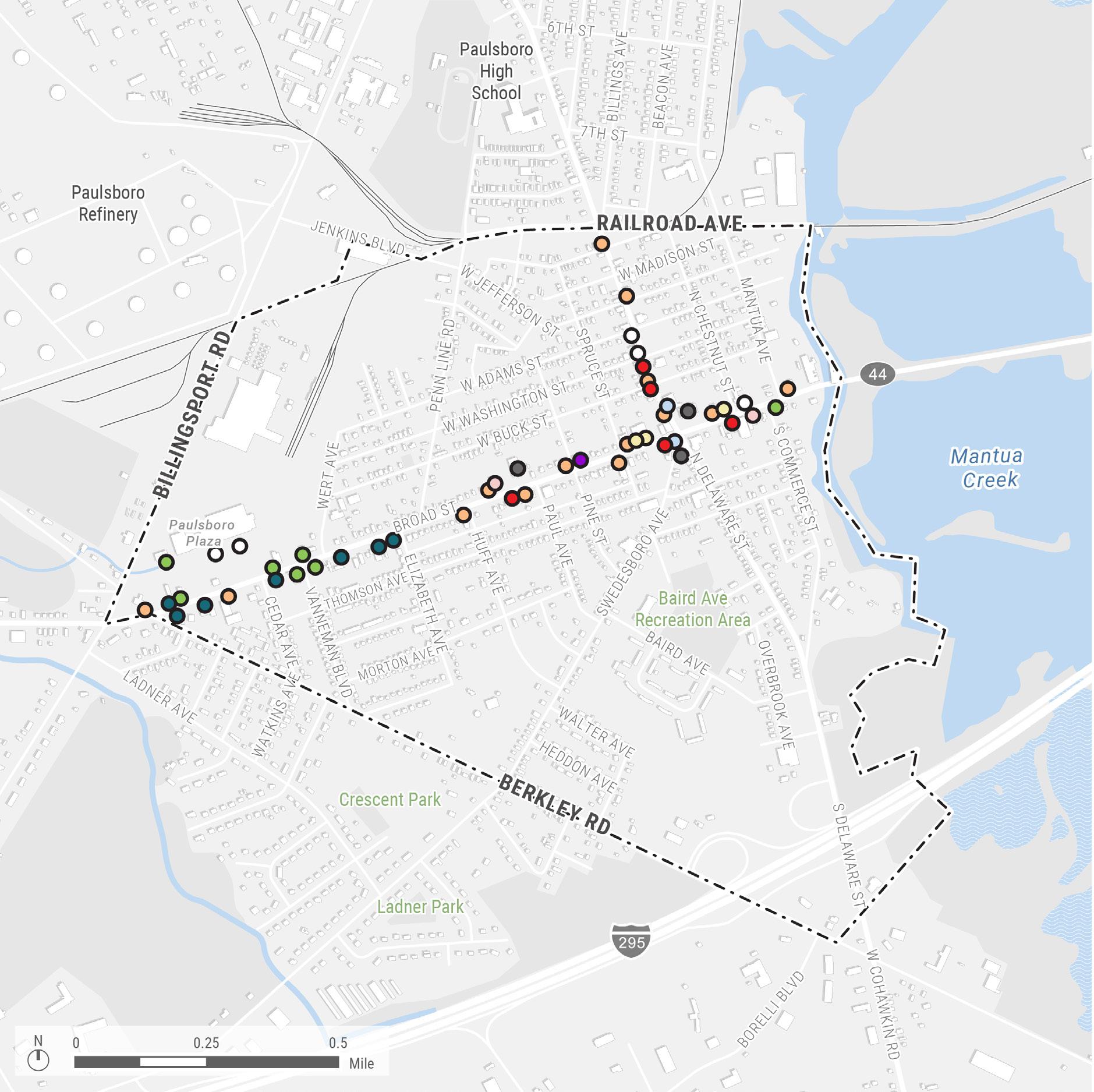
Figure 1.23: Ground Floor Businesses along Delaware Street and Broad Street by Type Gloucester County, NJ Office of Information Technology, Office of GIS (NJOGIS) 2023, Desktop and Field Research 2024, and Google Maps 2021
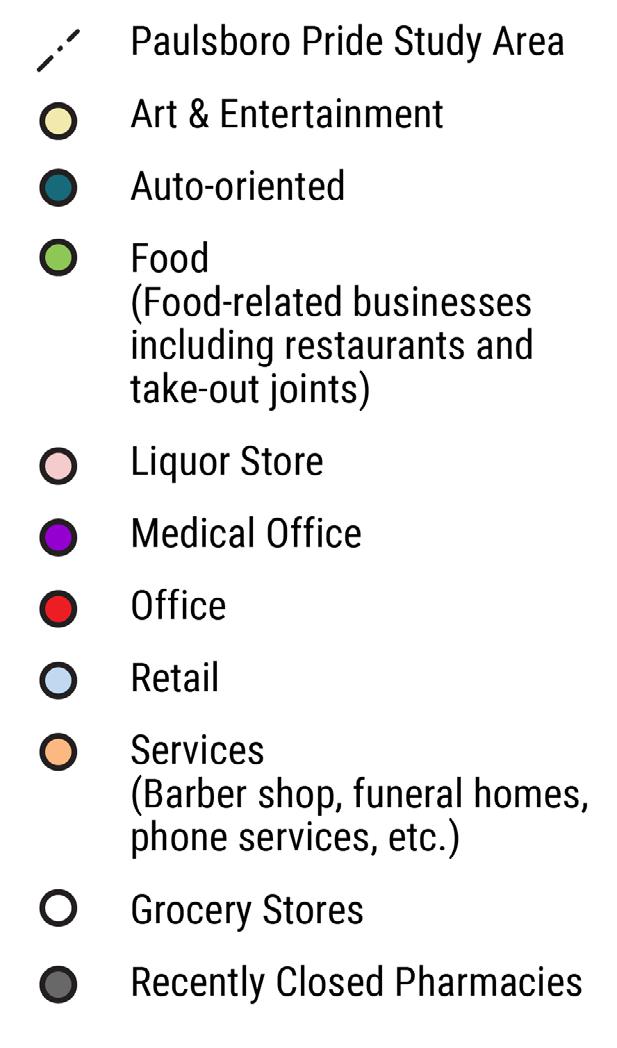

The Vision Statement and Goals section of a neighborhood plan serves as a cornerstone for shaping the community’s future.
The Vision Statement provides a concise and aspirational depiction of the desired future state of the neighborhood, rooted in its unique history, character, and potential. It acts as a guiding beacon, encapsulating the community’s collective aspirations and setting the tone for all subsequent planning efforts.
Goals, on the other hand, translate the Vision Statement into actionable and measurable objectives. They provide the framework for addressing key issues, leveraging opportunities, and aligning efforts across stakeholders. Together, the Vision Statement and Goals establish a shared foundation for decision-making, ensuring that future initiatives contribute cohesively to the longterm aspirations of the community.
Vision Statement Goals
Paulsboro will be a safe, vibrant, and family-friendly community that takes the phrase “Paulsboro Pride” to heart. Together, we will foster a strong sense of belonging by celebrating our rich cultural diversity, preserving our history, and strengthening the bonds that will make Paulsboro feel like a village.
We will prioritize safety through collaborative efforts and positive community-police relations. We will create a clean, beautiful, and welcoming environment that showcases Paulsboro’s pride at every corner. By investing in educational opportunities, civic spaces, youth programs, and family-friendly amenities, we will ensure that Paulsboro becomes not only a great place to grow up but also a community where families thrive for generations.
We will improve housing, expand transit access, and support economic opportunities to make Paulsboro a place where everyone can afford a high quality of life. Through revitalized public spaces, thriving small businesses, and local shopping opportunities, we will build a vibrant local economy and a sustainable future for all. Together, we will ensure Paulsboro grows as a community where residents are proud to live, work, and celebrate life.
1. Make safety a top priority.
2. Leverage our Paulsboro Pride, and strengthen and restore the feeling of Paulsboro as a village.
3. Ensure Paulsboro is a great place for young people to grow up and a great place to raise a family.
4. Clean and beautify the community in a way that reflects the pride residents have for Paulsboro.
5. Promote stable and accessible housing options to help existing and new residents establish longterm roots.
6. Strive to make Paulsboro a community where people can afford a good quality of life.
7. Advance economic development through local businesses and services to meet residents’ daily needs.


02 RECOMMENDATIONS
GOAL 1: Make safety a top priority in Paulsboro
Crime and safety remain critical concerns for Paulsboro residents, with many expressing unease about conditions in the community. While most people feel comfortable walking in the neighborhood during the day, that sense of security declines significantly at night. Throughout the community engagement process, safety emerged as a dominant theme, with many participants identifying it as a top priority for the future of Paulsboro.
STRATEGY 1:
Foster positive police-community relations
1.1 Encourage opportunities for regular community/police interactions to build trust with residents.
1.2 Host monthly meetings between residents and police to review community safety issues and collaboratively work through solutions.
1.3 Provide a text message, 311, or similarly easy-touse anonymous service for residents to report nonemergency safety issues and improve communication with law enforcement.
1.4 Increase foot patrols around the neighborhood to deter crime in known hotspots and have a visible presence of officers at key times, such as when school dismisses and students are walking home.
1.5 Support a variety of activities that bring youth and local police together. Examples could include youth and police athletic tournaments, the existing shop-with-acop program, or simply creating more opportunities for youth-police interaction at community events. There’s a problem with police engagement within the community.
Community Partnerships with Police Departments - Camden, NJ
The Camden County Police Department Community Policing Model, established in 2013, emphasizes community engagement through foot patrols, neighborhood meetings, and partnerships with local organizations. This approach fosters trust and transparency, and has contributed to significant reductions in violent crime and improved public perception of safety.
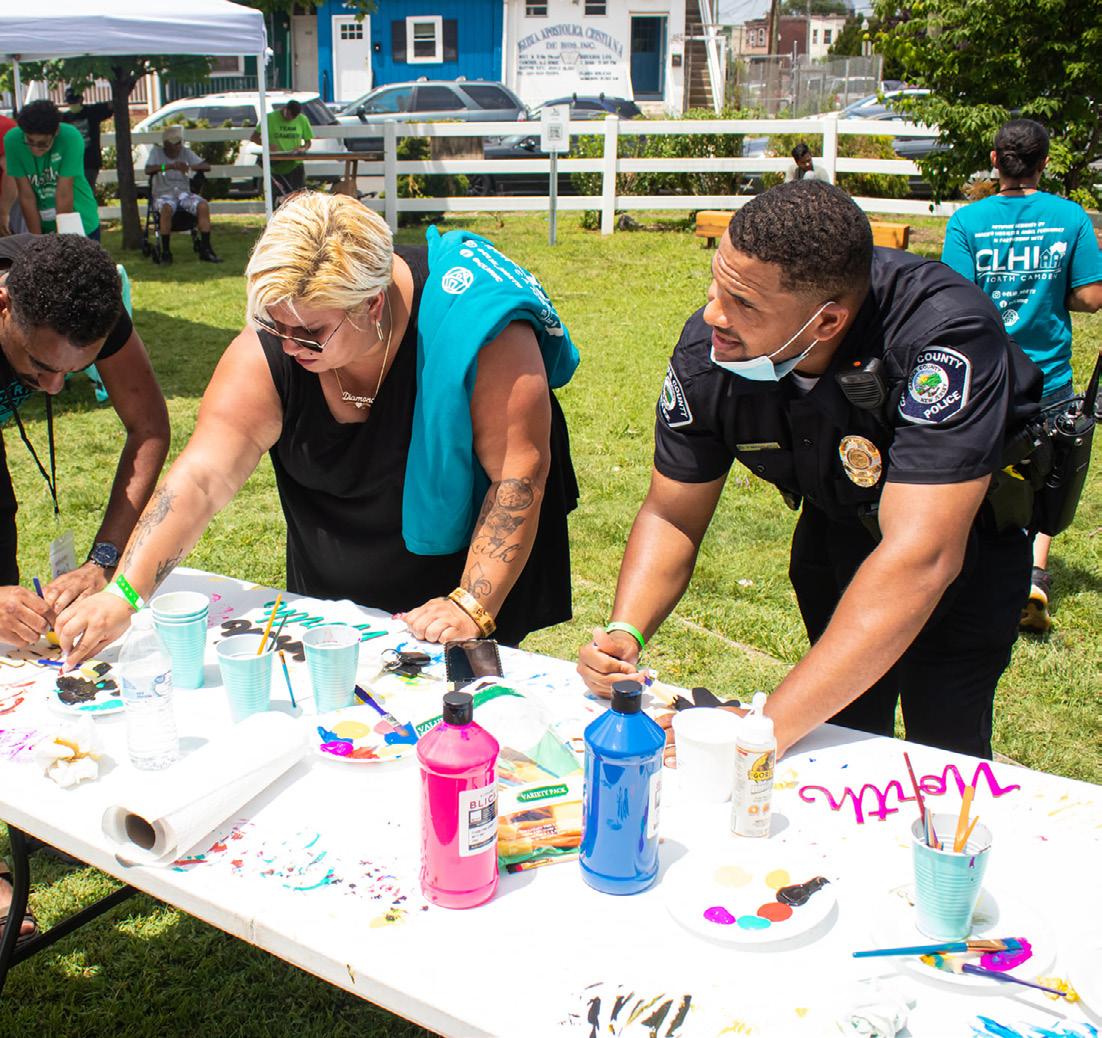
STRATEGY 2:
Coordinate efforts to strategically address safety issues
1.6 Improve coordination across departments by creating a committee on public safety that brings together the police, residents, and other departments to work collaboratively through safety issues.
1.7 Create a security camera incentive program for residents and businesses with an initial focus on commercial streets and blocks that are crime hot spots.
1.8 Use Crime Prevention Through Environmental Design (CPTED) to enhance lighting, maintain vacant spaces, and other safety-related physical improvements in order to improve real and perceived safety for residents walking in the community, day or night.
1.9 Regularly evaluate the effectiveness of crime prevention/safety interventions and adapt strategies as needed. Continuously gather input from residents to ensure approaches are aligned with community needs and that residents are being heard.
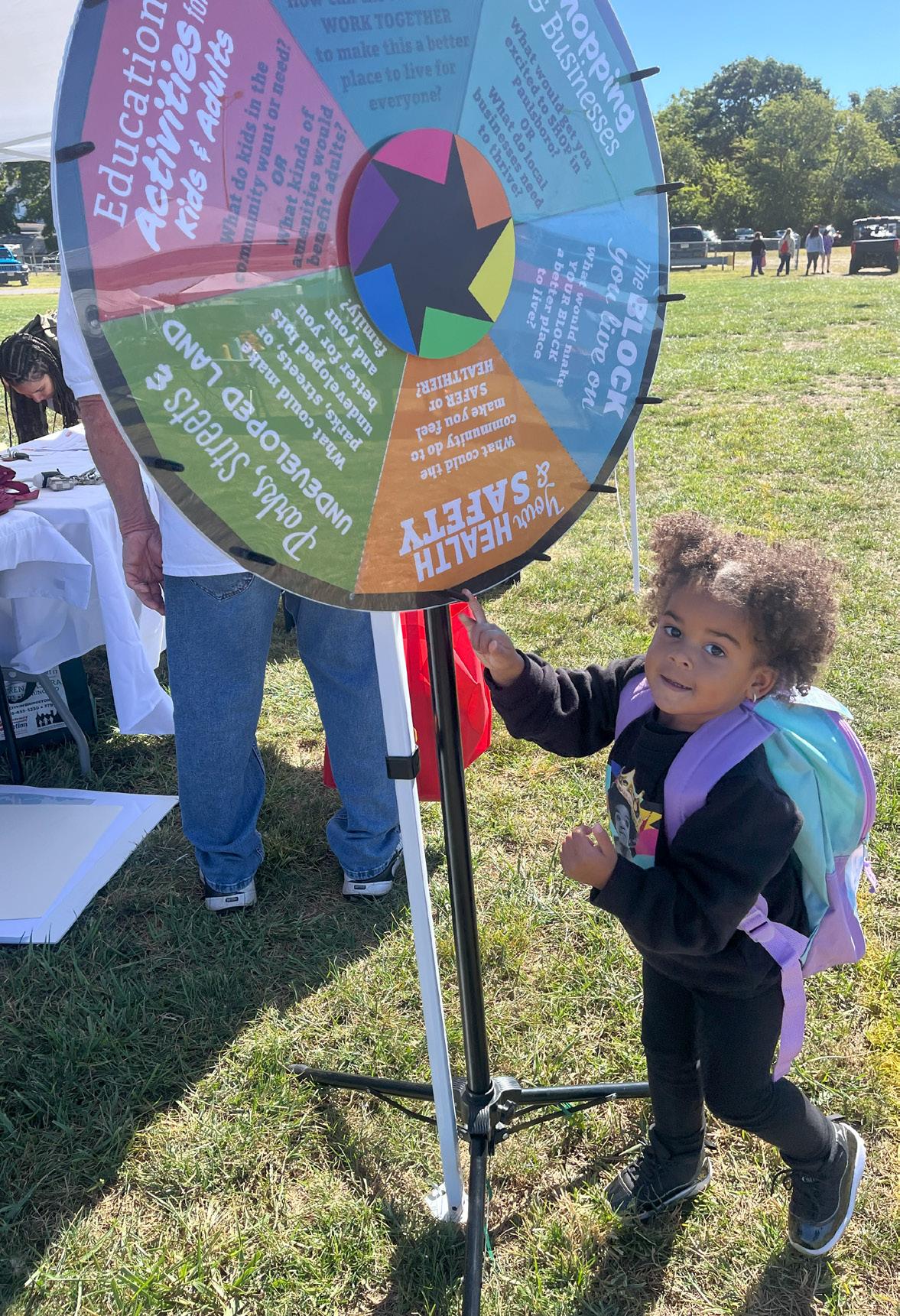
A young participant interacting with the spin wheel at a pop-up outreach event.

Figure 2.24: How can we make the community safer for school-aged kids?
Youth Survey (Paulsboro public school students in grades 3-12)
GOAL 2: Leverage our Paulsboro Pride, and strengthen
and restore the feeling of Paulsboro as a village
Paulsboro Pride has long been more than just a tagline—it is a defining characteristic of the community, reflecting its small-town feel and the strong bonds between neighbors. In recent years, however, some residents feel that this sense of pride has faded, with many believing the community has declined. Despite these concerns, there remains a sense of optimism, as some residents believe conditions will improve in the coming years.
The strength of neighborhood ties continues to be a key aspect of life in Paulsboro, with many residents praising the friendliness of their neighbors. Additionally, community connections remain an important factor in the neighborhood, with many citing proximity to family and friends as a primary reason for living in Paulsboro.
STRATEGY 1:
Celebrate the cultural diversity and rich history of Paulsboro
2.1 Incorporate the history of Paulsboro into the school’s curriculum, and provide field trips that help students see the important roles Paulsboro played in the early history of the United States.
2.2 Pursue grant funding to promote local historic tourism and storytelling. A number of Paulsboro’s historic sites have been elevated in recent years, though residents know little about Paulsboro’s history. Additionally, historic tourism could have a potential positive financial impact by bringing visitors to the community.
2.3 Host culture-focused events to celebrate the rich history of the community and its residents as a way of increasing civic pride and knowledge of local history.
2.4 Create a welcome packet to introduce new residents and businesses to Paulsboro.
We
have bigger opportunities for heritage tourism because a lot of history happened here.
“ ”
Local History Resources for Schools - Mississippi
The Mississippi Department of Archives and History provides a variety of resources and advice to make it easy for teachers in the state to incorporate local history into their lesson plans. Programs include:
Traveling Trunks: A trunk of active learning activities and hands-on artifacts that bring history into the classroom.
Field Trip Guides: Printable ready-to-use field trip lesson plans for visits to local historic sites designed for educators.
Mississippi History Day: A cross-curricular program with a basis in exploring state history that encourages students to apply in-depth research and critical analysis to a topic, and in a medium, of their choice.

STRATEGY 2:
Recognize and promote the unique skills and talents of residents
2.5 Host an all-ages Paulsboro talent show to celebrate the variety of skills and interests of residents.
2.6 Create a directory highlighting the skills and services of local residents and businesses to provide an easy-to-use directory for hiring local talent and skilled tradespeople.
STRATEGY 3:
Host a variety of events throughout the year that bring Paulsboro residents together
2.7 Host regularly scheduled events that bring the entire community together and that address identified needs, such as weekly farmer’s markets that accept federal nutrition assistance programs and increase access to fresh food.
2.8 Create volunteer and paid opportunities for residents to connect with one another and work collaboratively on small projects and initiatives that advance the goals of the neighborhood plan and tackle community issues.
2.9 Recruit younger leaders and volunteers to run and strengthen staple community events, such as Paulsboro Day and the Juneteenth Event. Paulsboro Day is an important annual community event, but members of the event planning committee have decided they can no longer run the event due to their age (70-85). Recruiting a new class of leadership to continue this event with ongoing Borough support should be a priority.
Farmers Market - Akron, OH
The Summit Lake Neighborhood Farmers Market not only provides access to fresh produce in a community with limited grocery options, but also provides a weekly free event that brings neighborhood residents together.

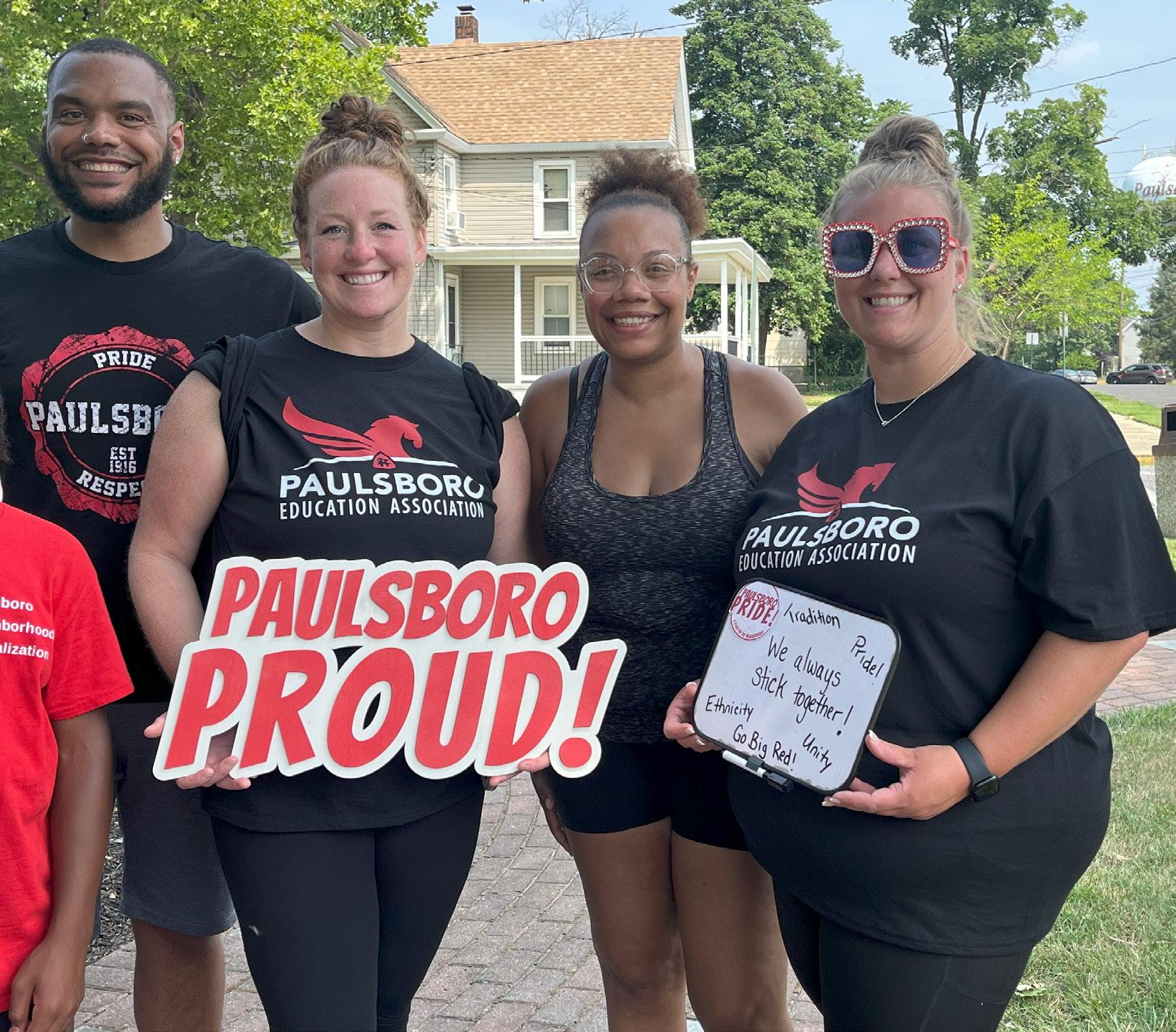
We all love Paulsboro, but we deserve better. We could get something done and boost morale to accomplish something. “ “ ” ”
Members of the Paulsboro Education Association at a pop-up engagement event.
GOAL 3: Ensure
Paulsboro is a great place for young people to grow up and a great place to
raise a family
Paulsboro’s changing demographics show a decline in families with children, with many residents perceiving the area as less family-friendly than in the past. Spaces that are typically family-friendly, such as parks and playgrounds, face frequent issues, including inadequate restroom facilities, odors from the nearby refinery, litter, and signs of drug use, causing many families to travel outside the community for parks and green spaces. Furthermore, during a two-day community walk, local youth expressed concerns over broken streetlights, deteriorating sidewalks, and overall neighborhood conditions.
Through engagement efforts, residents consistently emphasized the need for yearround, high-quality structured activities for children and families, with youth themselves expressing strong interest in expanded programming and community events. Older residents recall a time when more programs existed for young people, reinforcing the sentiment that opportunities have diminished over time.
STRATEGY 1:
Invest
in Paulsboro’s civic assets and public spaces
3.1 Build a community recreation center to provide a space for yearround, high quality programs and activities for youth, families, and seniors. First steps may include identifying potential sites, developing an initial cost estimate, and researching funding sources.
3.2 Provide operational and capital support that recognizes Gill Memorial Library’s role as a community hub for a variety of Paulsboro residents.
3.3 Work with the Boys and Girls Club to build programs and staff supports to appeal to tweens and teens.
3.4 Make improvements to the Baird Avenue Recreation Area, which currently has three deteriorated basketball courts and no seating, shade, or additional activities.
3.5 Resolve issues with the Kaboom Playground and add amenities at Buck Street Park.
3.6 Leverage planned investments in Fort Billings Park, as part of the United States’ 250th Anniversary celebrations, to create a permanent natural park for residents with access to the waterfront and shore.
3.7 Consider establishing adult recreation leagues in Paulsboro. Community outreach revealed a strong interest in adult activities, and the town’s deep-rooted pride in athletics—along with its strong high school alumni network—makes this a natural fit. These leagues would encourage more residents to utilize public spaces and potentially advocate for their improvement.
Last time I took my grandkids to the park, there was trash, baggies, and other things and no bathroom to use.”
Community Recreation CenterChicago, IL
The FamilyPlex by Breakthrough Urban Ministries in Chicago’s West Side began in 2001 as an idea drawn on a white board by local teenagers to improve their neighborhood by giving residents a safe, welcoming place to go. 15 years later, this 42,500 sq ft facility opened its doors to provide a range of services to the community, including a preschool, art studio, gymnasium, fitness center, and a medical clinic.
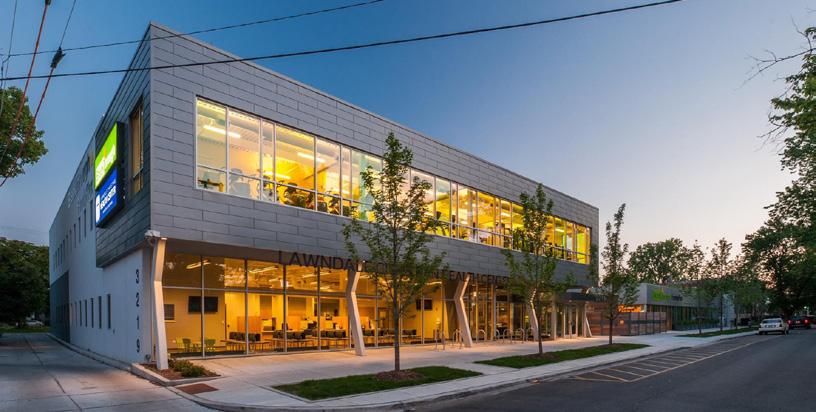
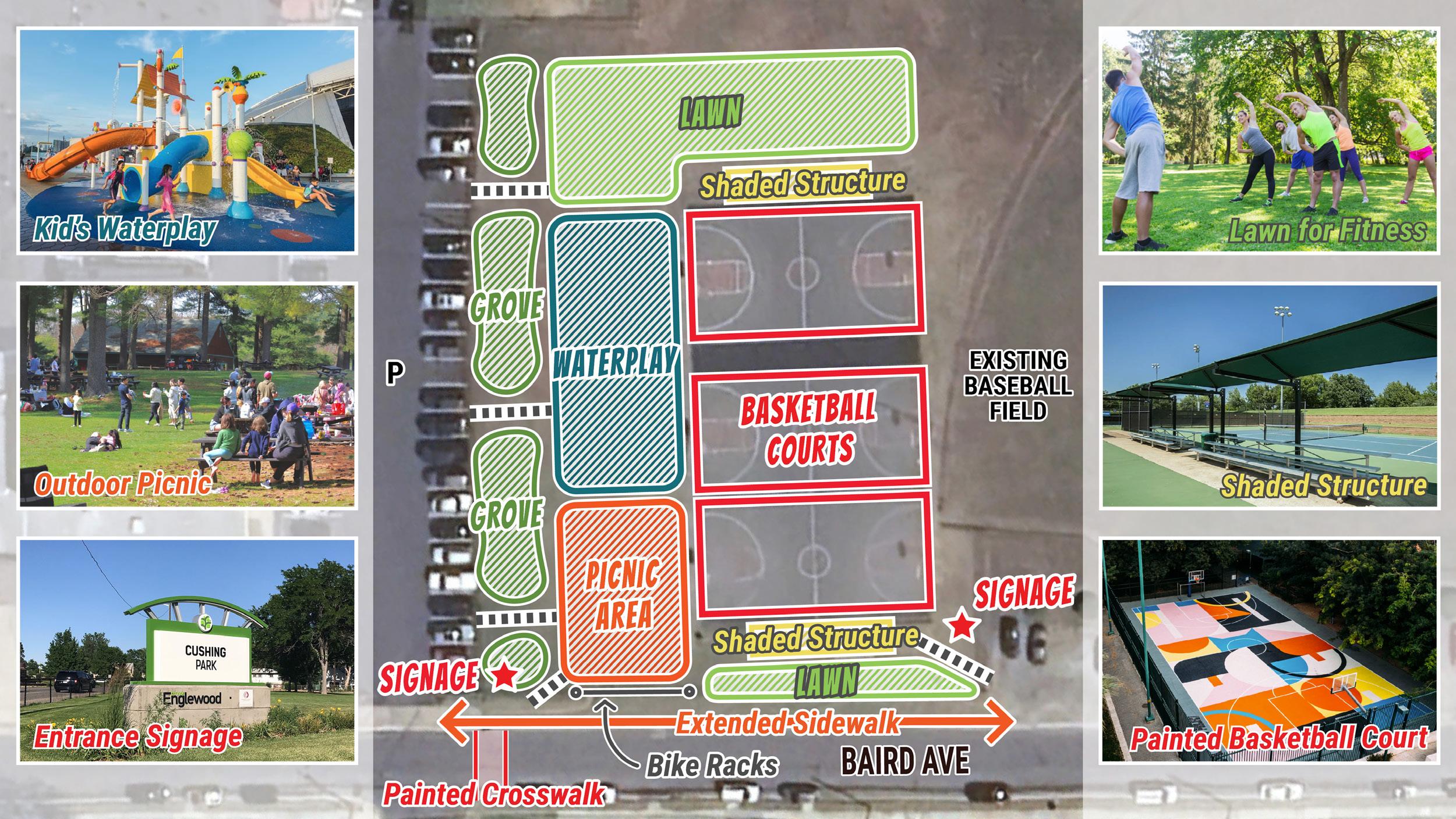
Figure 2.25: Diagram of Potential Improvements to the Baird Avenue Recreation Area
STRATEGY 2:
Support a wide variety of yearround, high-quality programs for youth of all ages
3.8 Create youth-oriented programs and events, such as a summer play streets program, to keep youth active and engaged in the summer. A playstreets program could also be an effective way of engaging police officers in youthcentered activities. Playstreets programs often involve a federally funded meal component through state-administered programs that fund and deliver free meals to sites.
3.9 Provide financial and in-kind support to a wide variety of after-school and summer programs for youth of all ages.
3.10 Support high-quality daycare, aftercare, and pre-school programs.
3.11 Seek funding to use public school facilities for programming that happens outside of school hours. This could help a range of year-round high quality programming while efforts continue to build a dedicated recreation center.
3.12 Provide employment, enrichment, and careerdevelopment programs for youth.
What do Paulsboro youth want to see in their community?
The following are responses from students to the Youth Survey addressing the question: “Are there any activities or programs you would like to see in your school and/or community?”
Programs
• Dance
• Cheerleading
• Kickball
• Football
• Cooking Classes
• Basketball
• Summer Camps
• Soccer
• Band
• Pep Rallies
• Volleyball
• Clubs
• After-School Clubs
• Tennis
• Homework Club
• Arts & Culture
• Chess
• Baking
• More Electives
• Drama Club
• Music
• Trade Programs
• Lacrosse
• Cheer Volleyball
• Bowling
• Martial Arts
• More Classes About History Of Town
• Tournaments
• Clean-Up Days
• Field Trips
• Carnivals
• Teen and Young Adult Activities
• Open Mic Nights
• Open Gym
• Open Mic Nights Businesses
• Repurposing Old Buildings Events
• Restaurants
• More stores on Delaware Street
• More stores where kids can hang out
• Movie Theater
Facilities & Infrastructure
• Rec Center
• Pool, Splash Pad
• More Parks, Better Parks
• Bigger, Better Facilities
• Safe & Clean Hangout Spaces
• Better Sports Equipment
• Skating Rink
• Repaired And Improved Streets
• Fix Tennis Courts
Make it safer to walk in Paulsboro for kids of all ages
3.13 Start a walking school bus to make it safer for children to walk to and from school. A walking school bus is a group of children walking to school with one or more adults, and can be a safe and fun way for children to get physical activity as they travel to and from school with adult supervision.
3.14 Advocate for infrastructure maintenance (sidewalks, lighting, crosswalks) and traffic calming to make safer streets for pedestrians, especially along common routes to and from local schools. The most common walking route serving all public schools and areas of focus for infrastructure improvements are shown on the map and photos at left.

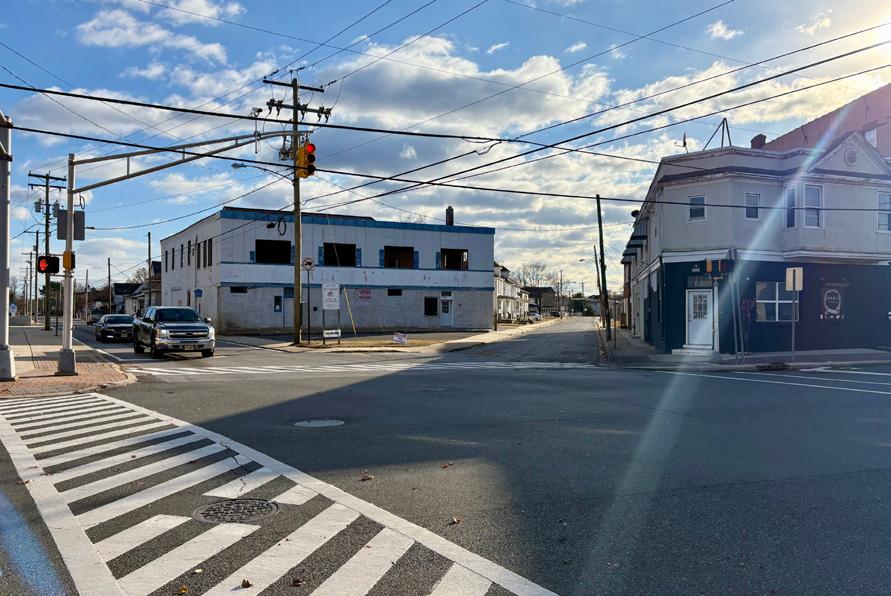

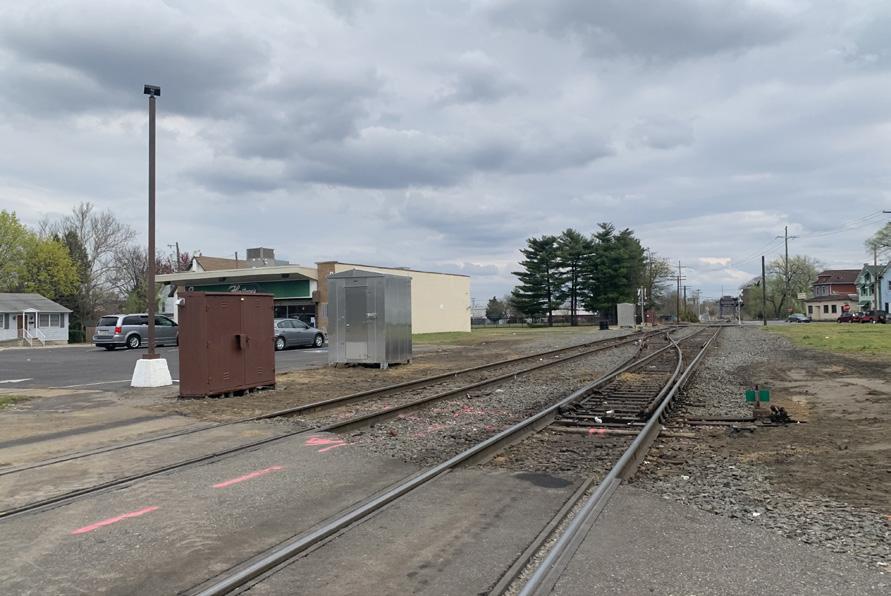
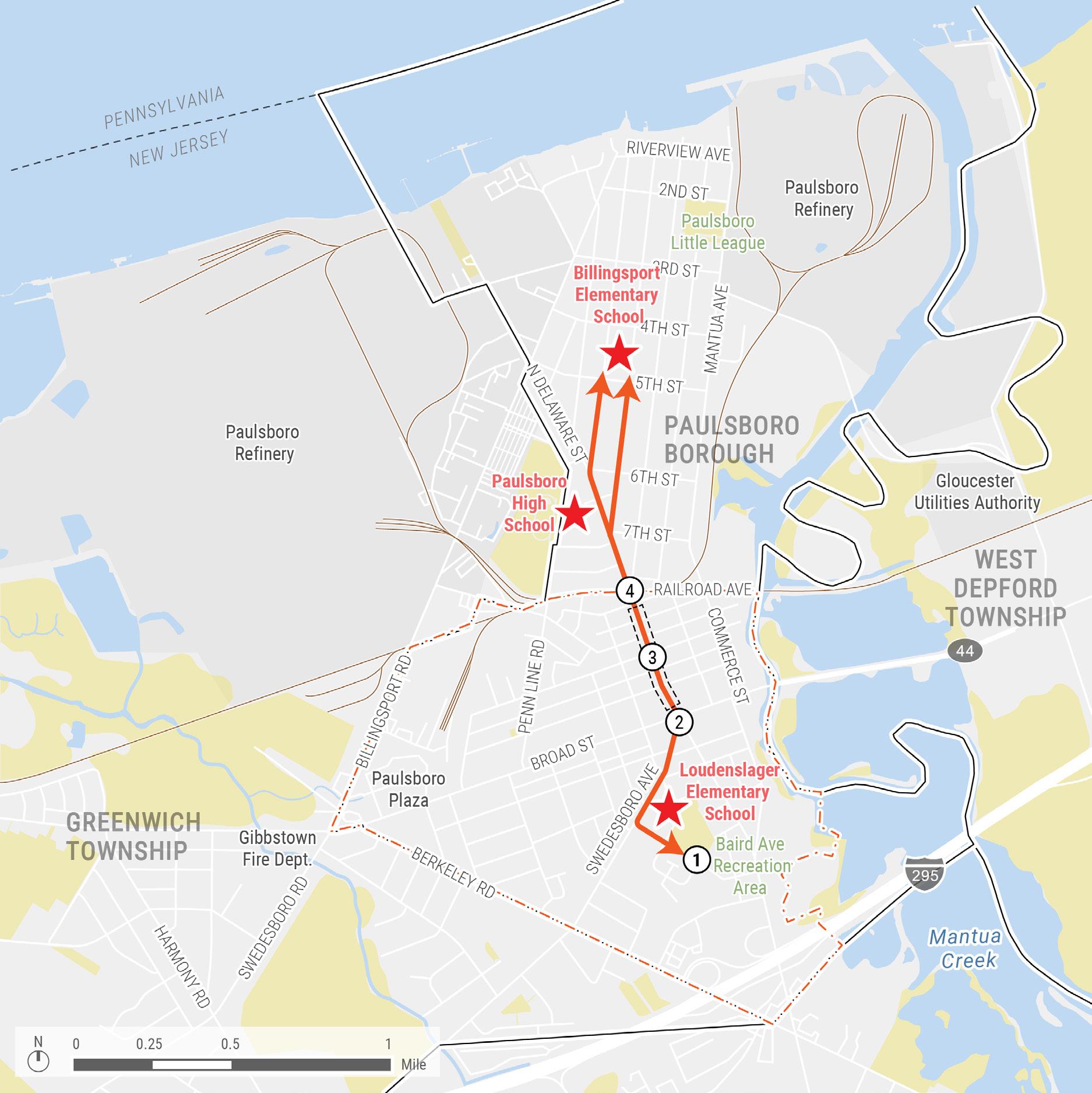
2.26: School Walking Route Improvement Areas
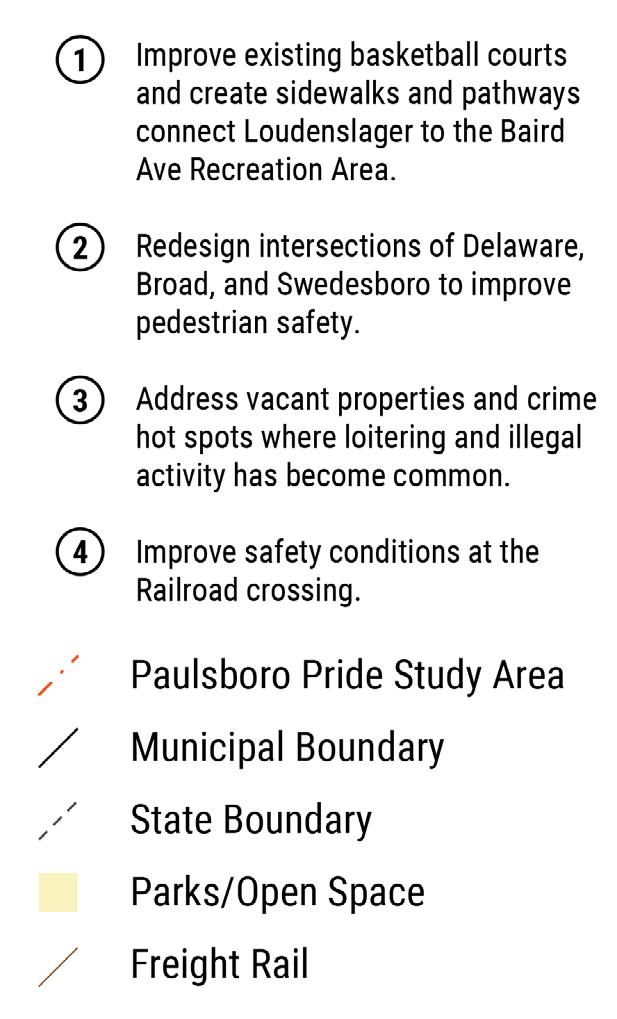
Figure
GOAL 4: Clean
and beautify the community in a way that shows our “Paulsboro Pride”
Basic services and neighborhood conditions remain major concerns for Paulsboro residents, with trash collection being a particularly pressing issue. Many residents have voiced frustration over inconsistent sanitation services, highlighting the need for better waste management and recycling services. Beyond sanitation, the neighborhood’s high vacancy rate has led to overgrown lots and poorly maintained properties that diminish the area’s overall appearance and livability. Commercial corridors also lack wayfinding, beautification, and placemaking efforts, though recent public art installations, such as a mural on Delaware Street, have been well received by residents eager to see visible improvements.
STRATEGY 1:
Beautify vacant lots and underutilized spaces
4.1 Start a community gardens program, prioritizing underutilized open space or vacant lots that are unlikely to be developed. Explore community garden models that are designed to grow fresh food for neighborhood residents.
4.2 Start a neighborhood clean-up initiative to supplement existing clean-up programs and target areas in-need. Currently Gloucester County’s Clean Communities program supports neighborhood clean-ups twice a year, but a locally support program could supplement this effort by targeting blocks or areas with the greatest need and engaging more community members in the effort.
4.3 Start a sideyard program, where a neighboring homeowner can acquire a vacant lot next door to their home. Priority should be given to vacant lots that are not appropriate for infill development.
Vacant Lot Program - Philadelphia, PA
Vacant to Vibrant: Communities like the Parkside neighborhood in Philadelphia have had success turning cleaned up vacant lots into fun places - hosting programming such as concerts, exercise classes, community dinners, and events in once abandoned lots.
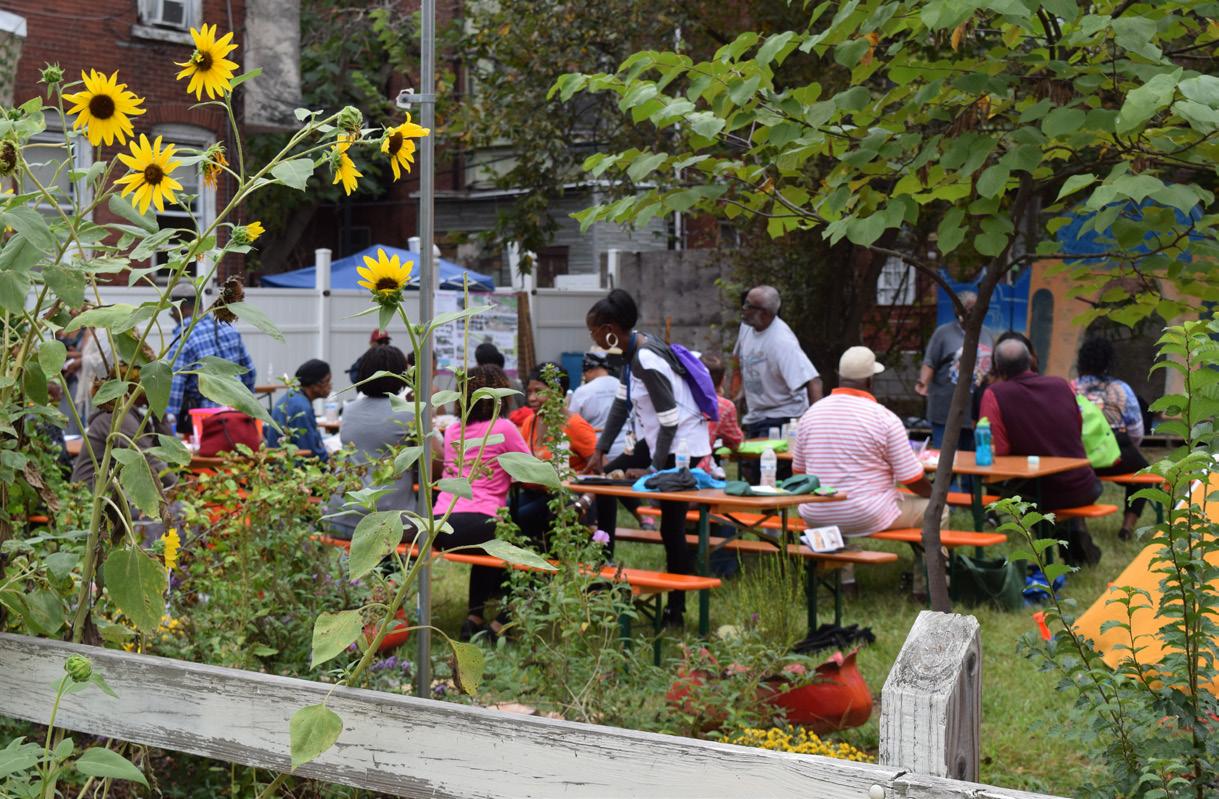
STRATEGY 2:
Address trash, litter, and illegal dumping
4.4 Improve trash and recycling services. Considerations may include introducing bulk pickup services monthly or quarterly, allowing households to have more than one trash can, ensuring the placement of cans on trash day don’t conflict with parked cars, and reintroducing recycling pickups.
4.5 Map hotspots for illegal dumping and develop site-specific strategies to alleviate the issue.
STRATEGY 3:
Show Paulsboro’s Pride at key routes and gateways
4.6 Implement traffic calming, pedestrian safety, and beautification elements at Delaware Avenue and Broad Street, which sits at the intersection of two key commercial streets and is crossed daily by children going to and from local school.
4.7 Work with the owner of the Paulsboro Plaza to activate the parking lot using low-cost, high-impact strategies incorporating asphalt art, planters, facade improvements, traffic calming, and parking lane striping.
4.8 Develop an ordinance that allows and supports murals, and seek grant funding that supports the addition of murals and public art in high-visibility locations throughout the neighborhood.
4.9 Implement streetscape improvements to key streets, such as planters and banners.
” “ “
We need to find out who owns these old boarded-up properties… We also need to see who owns/buying up all of the commercial property in town. There’s bad curb appeal on Delaware Street; it looks like a junkyard. Clean Paulsboro up! I would like to see gardens, flowers, where kids can use space.”
Figure 2.27: Improvements to Paulsboro Plaza
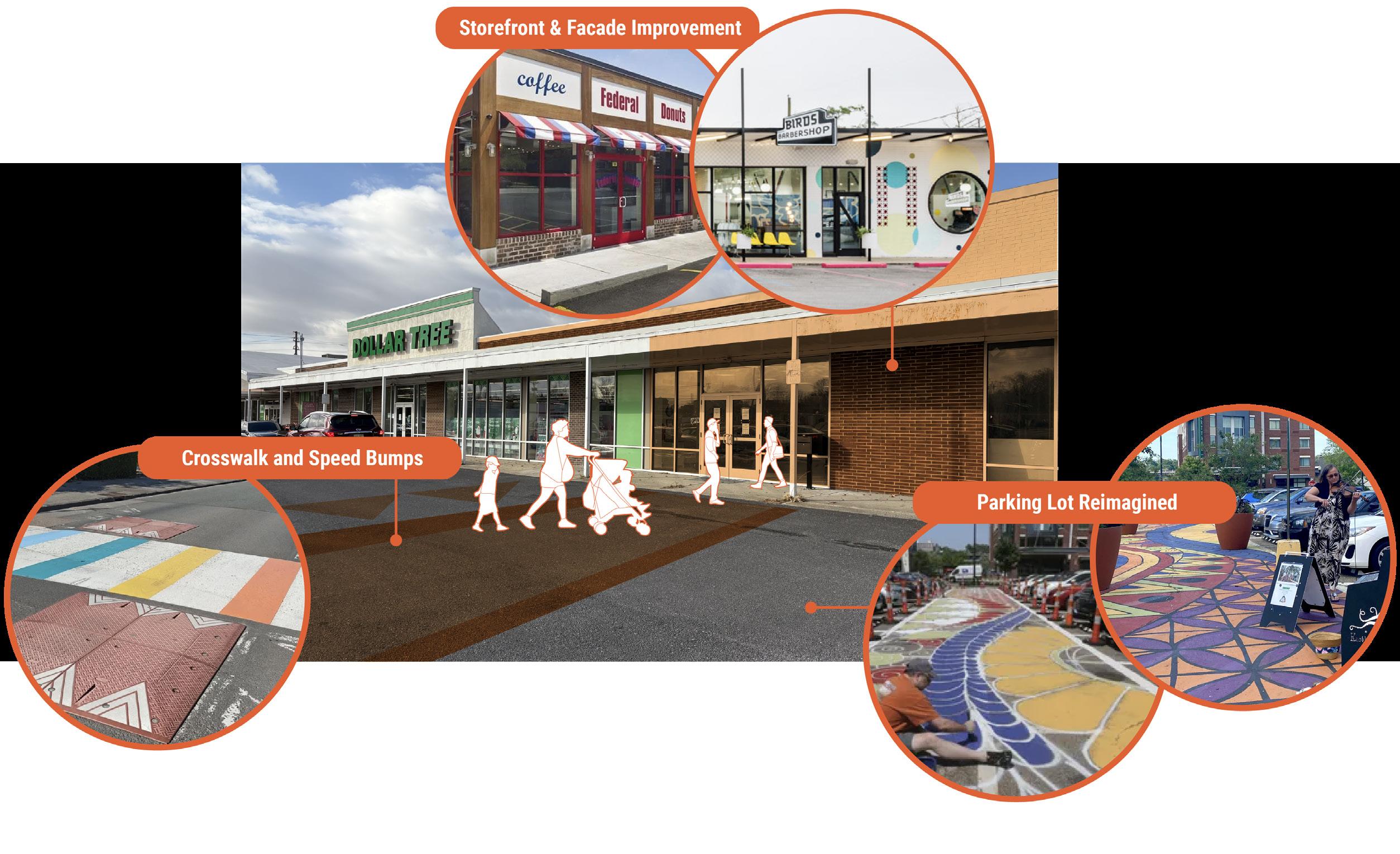
Figure 2.28: Improvements to Delaware and Broad

Main Street Banner Program - Boston, MA
In 2023, Greater Grove Hall Main Streets, a nonprofit organization dedicated to improve the economic vitality of the Greater Grove Hall neighborhood in Boston, created the Black Women Lead project which features 212 of Boston’s most admired and successful Black female leaders on banners displayed on two miles of Blue Hill Avenue. Each banner shows a portrait of one of the women, her name, and credentials. The list of women spans from the 1700s to present day, showcasing the long-standing history of Black women who have helped shape Boston.
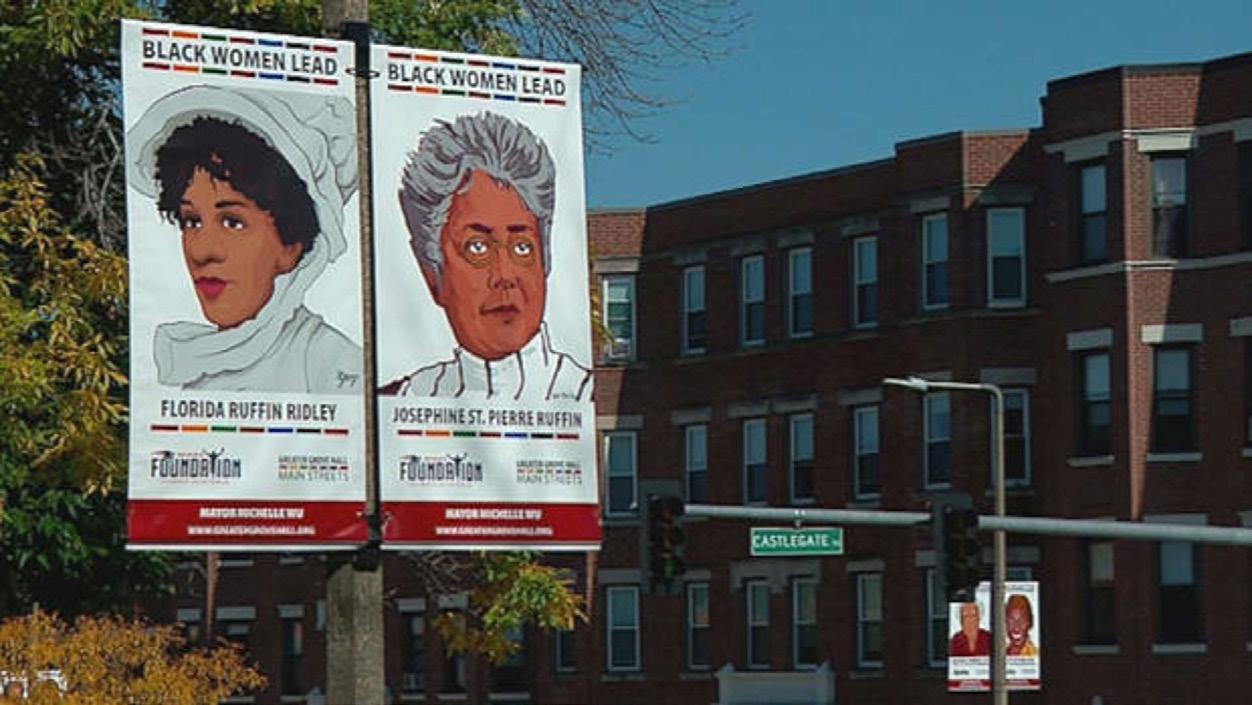

GOAL 5: Promote stable and accessible housing options to help existing and new residents establish long-term roots
Housing stability and affordability remain pressing concerns in the Paulsboro Pride neighborhood, where homeownership has declined over the past decade, reflecting a broader national trend. Financial challenges further exacerbate housing issues, with many residents—both renters and homeowners—experiencing periodic instability in meeting their housing expenses. Renters, in particular, face significant financial strain, with a considerable portion struggling to afford their rent, and many aspiring homeowners unable to purchase homes due to financial barriers. Additionally, the neighborhood’s aging housing stock presents challenges, as many homes require costly repairs and upgrades that can be difficult for homeowners to manage. These trends highlight the need for targeted housing policies and investment to support affordability, expand homeownership opportunities, and preserve existing homes.
STRATEGY 1:
Create support programs to help prospective homeowners and renters
5.1 Provide financial support to prospective homeowners by offering down payment assistance, savings matching programs, or low-interest loans to first-time homebuyers.
5.2 Help prospective homeowners learn the steps they need to take to own a home by providing credit counseling and homeownership education.
5.3 Create an emergency rental fund to help renters in times of crisis.
Figure 2.29: Average Home Sales Price By Year
Reinvestment Fund Analysis of NJ MOD IV Historical Database 2022
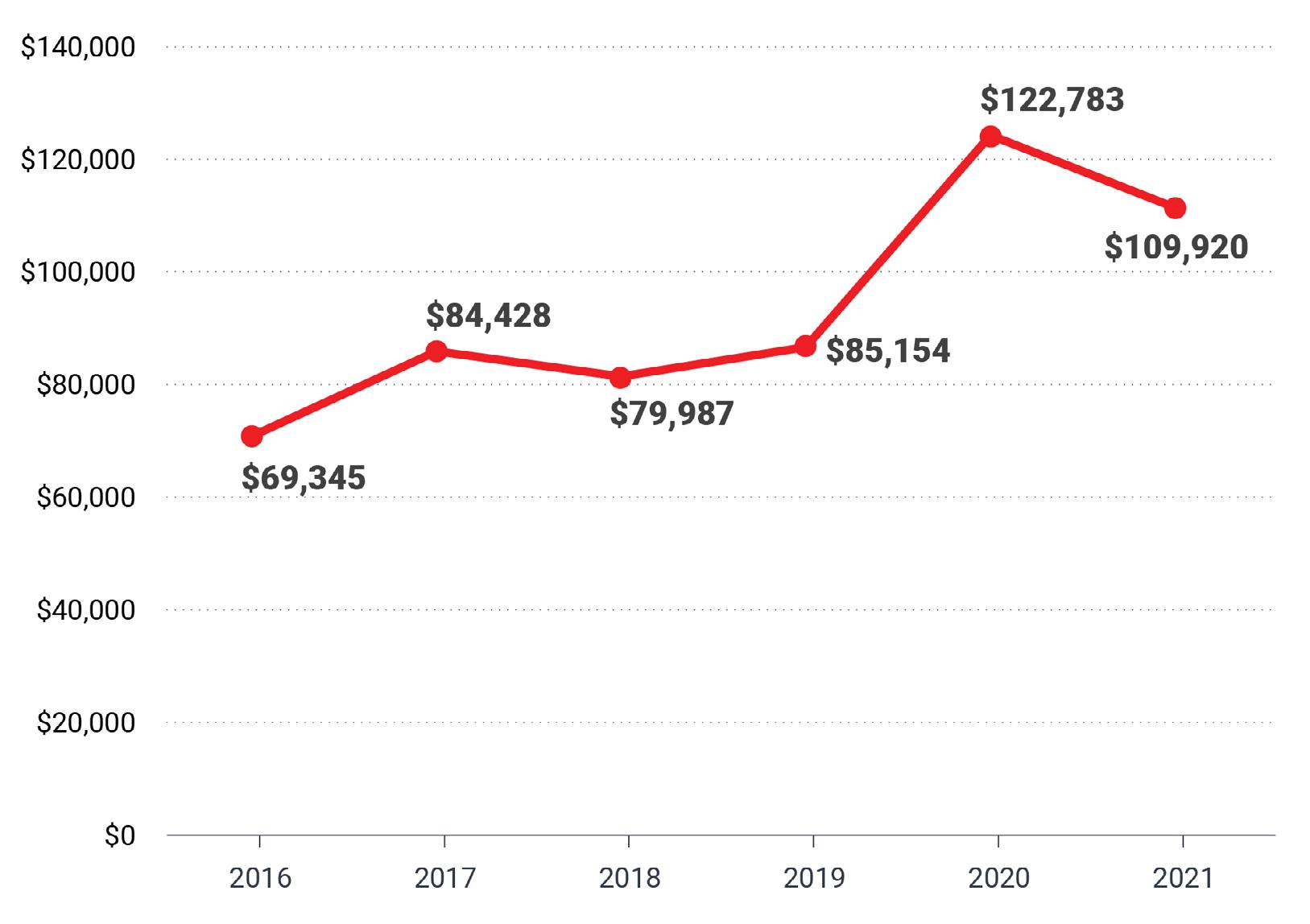
STRATEGY 2:
Preserve and rehabilitate existing housing
5.4 Create a home repair program to help with necessary health and safety upgrades. Eligibility requirements may restrict this program to those most in need, such as seniors, low-income families, etc.
5.5 Start a “Front Porch” program to address exterior home improvements, with the goal of improving curb appeal and raising property values on the block.
5.6 Address rental housing conditions through improved code enforcement.
Figure 2.30: Occupied Housing Units by Year Built
American Community Survey 5-Year Estimates 2017-2021
Paulsboro is still my community and it still means a lot to me. Moving elsewhere is not an option for me.” “
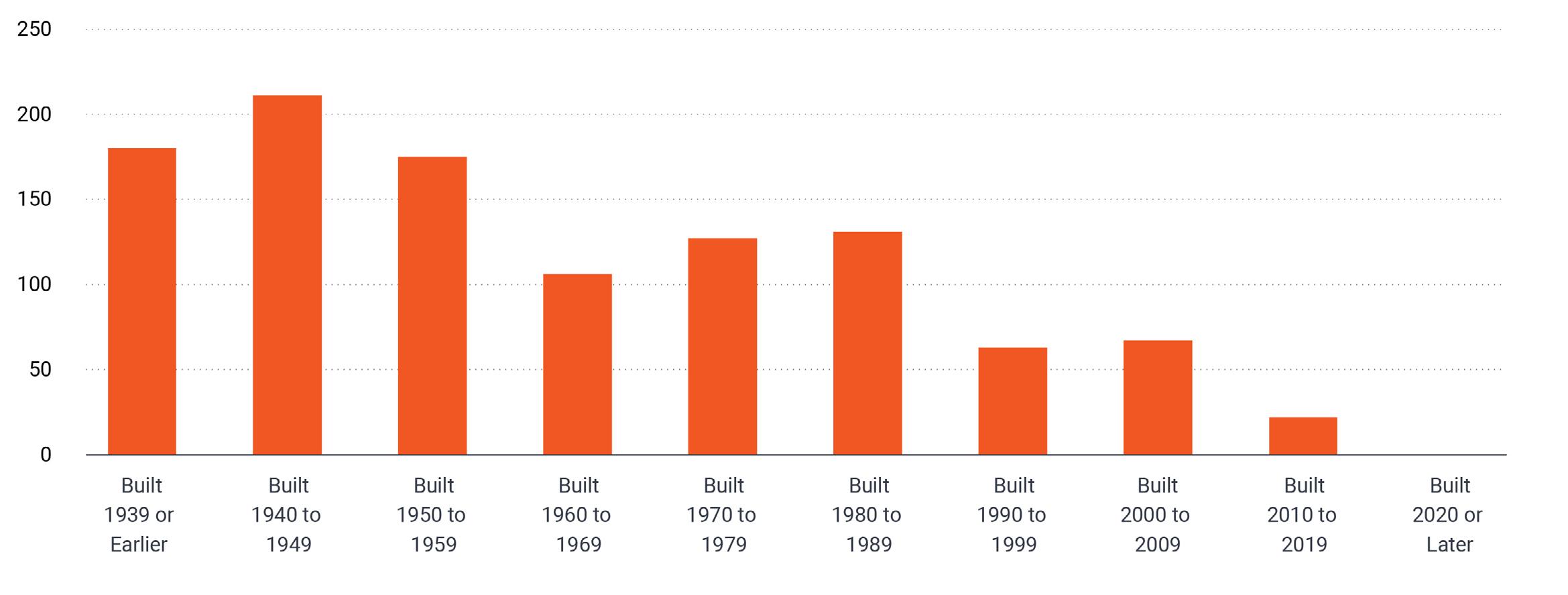
2.31: Diagram of Strategies & Actions to Improve Housing & Block Conditions
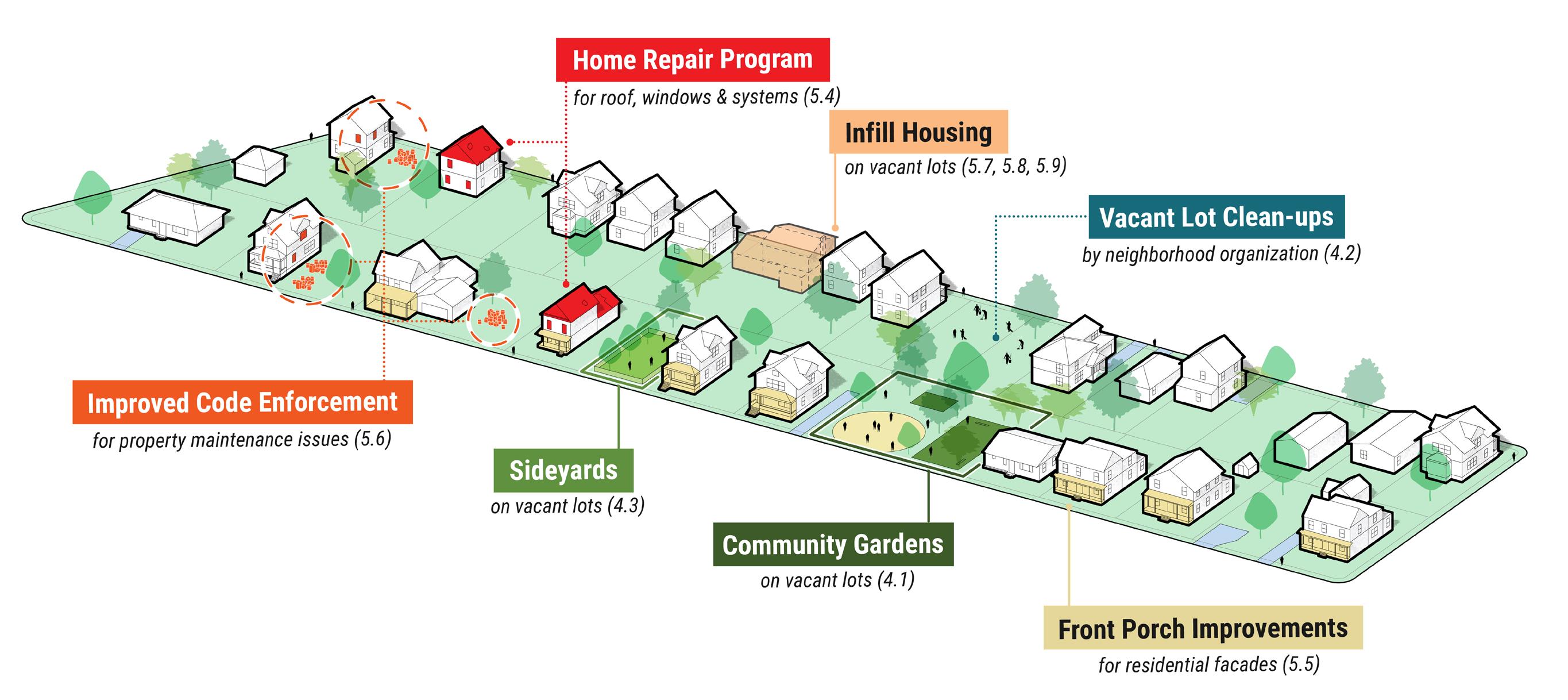
Figure
STRATEGY 3:
Promote infill development
5.7 Acquire vacant properties and land for infill housing development, with a focus on properties zoned for residential in the portions of the community north of Broad Street where the greatest concentration of vacant land is.
5.8 Use publicly-owned land for strategic infill development and housing rehabilitation.
5.9 Develop new affordable and market-rate housing throughout the community. Affordable units should be mixed with market-rate units so as not to concentrate poverty in certain areas.
The Fitzgerald Revitalization ProjectDetroit, MI
The Fitzgerald Revitalization Project is a community-driven redevelopment effort focused on leveraging publicly owned land to stabilize and revitalize a neighborhood facing high vacancy rates. Spearheaded by the City of Detroit, the project targeted a 100-block area in the Fitzgerald neighborhood, transforming vacant lots and abandoned homes into new housing, parks, and community spaces. The initiative prioritized strategic infill development, affordable housing rehabilitation, and the creation of green infrastructure, such as Ella Fitzgerald Park.
Regardless of where I live, I am still committed to Paulsboro.
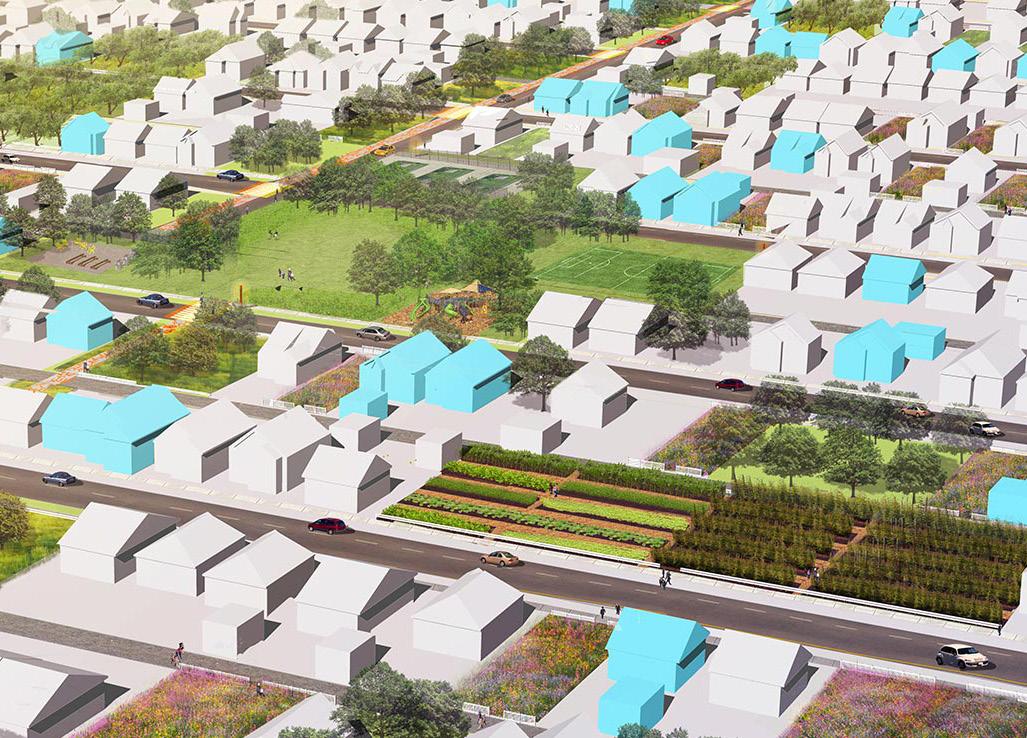

Figure 2.32: Potential
Infill Development Sites
Overlaid with Residential Zoning Districts
Gloucester County, NJ Office of Information Technology, Office of GIS (NJOGIS) 2023, Desktop and Field Research 2024, and Google Maps 2021

GOAL 6: Make Paulsboro a community where people can afford a good quality of life
Affordability remains a pressing concern in Paulsboro, a historically working-class community where economic challenges have intensified in recent years. Unemployment in Paulsboro is alarmingly high—four times greater than the county rate. Household incomes also lag behind those in the County, limiting economic mobility for many residents. These financial struggles contribute to widespread hardship, with many residents experiencing food insecurity and delaying necessary medical and dental care due to cost.
Limited access to reliable transportation further exacerbates economic difficulties, as Paulsboro households are less likely to have access to a car than the broader County, making it harder to reach employment centers and job opportunities. Educational attainment also falls below national trends, with fewer residents holding bachelor’s degrees, creating additional barriers to economic advancement. These combined factors highlight the urgent need for targeted investments in workforce development, public transportation, and social services to support economic stability and upward mobility in Paulsboro.
STRATEGY 1:
Improve transit service to major destinations outside of Paulsboro
6.1 Work with NJTransit to advocate for service improvements to the NJ-402 bus line to increase frequency of service and close the gap between the time it takes to reach major destinations by car versus by public transit.
6.2 Support the Borough’s shuttle bus service, and explore funding sources to expand the shuttle’s service.
6.3 Connect Paulsboro to Gloucester County’s Multi-Purpose Trail System to enable residents to reach destinations across the County by bike.
“ Lots of things are far away, and it’s hard to get out of town.
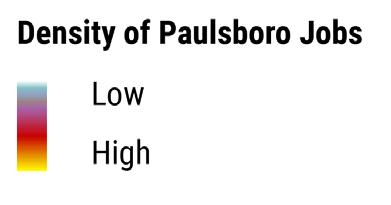


Figure 2.33: Where Paulsboro Residents Work & Transit Times US Census Bureau, LEHD OnTheMap 2021
Improve access to employment opportunities and trainings
6.4 Work with the Chamber of Commerce to hold workforce development trainings and mentorship programs geared toward local job opportunities and career advancement.
6.5 Work with local colleges and universities to create accessible job training programs, with a focus on educational programs that open pathways for economic mobility.
6.6 Host job fairs in the community to connect local employers with skilled residents looking for work. This should also involve convening local employers to understand their hiring needs and what skills are in-demand for their industries.
Figure 2.34: Median Household Incomes
American Community Survey 5-Year Estimates 2017-2021, via Policy Map’s Community Profile Report of Paulsboro Pride Neighborhood

STRATEGY 3: Support neighborhoodbased social services
6.7 Explore grants and opportunities to partner with schools and local institutions to create or expand social programs serving families with children, such as food/ household pantries or laundry.
6.8 Work with partners and advocate to improve pharmaceutical access in Paulsboro. This could include the Borough’s shuttle service, telepharmacy services, collaborating with existing providers such as CAMCare, and/or attracting a grocery store with a pharmacy.
6.9 Work with local social service organizations to provide services in the community. Examples include CAMCare, Volunteers of America, and the Gloucester County Boys & Girls Club, among others.
6.10 Address food insecurity by partnering with local churches, non-profits, local farmers, and institutional partners to provide food banks and farmer’s market that accept public assistance.
Pharmacy Adaptive Reuse
(1) Station 411 (proposed) - Tarentum, PA: In 2018, Rite Aid closed its store in downtown Tarentum, PA. Unable to sell the property, Rite Aid donated it in 2019 to the Abundant Joy Fellowship Church after the pastor proposed converting it into a community center. Named “Station 411,” the center is planned to include a daycare, performance spaces, and a commercial kitchen. Since the donation, the church has been fundraising for renovations.
(2) Natural Grocers, multiple locations: Natural Grocers is a specialty grocer specializing in organic food and produce, vitamins, and dietary supplements, with over 160 locations across the country. Many of the grocer’s locations have been developed via the adaptive reuse of existing buildings, including multiple properties that were formerly major drugstore chains including CVS, Walgreens, and Rite Aid.
(3) Fitness Depot - Picayune, MS: An adaptive reuse of a former freestanding Rite Aid, The 15,000 square foot square foot Fitness Depot in Picayune, MS is a locally owned and operated gym that offers a variety of cardio and strength training equipment plus group classes and circuit workouts.

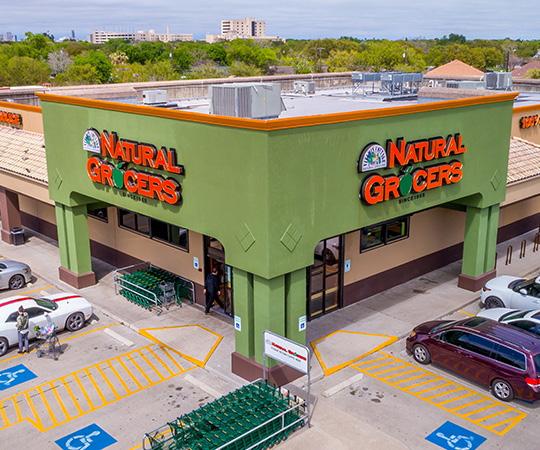
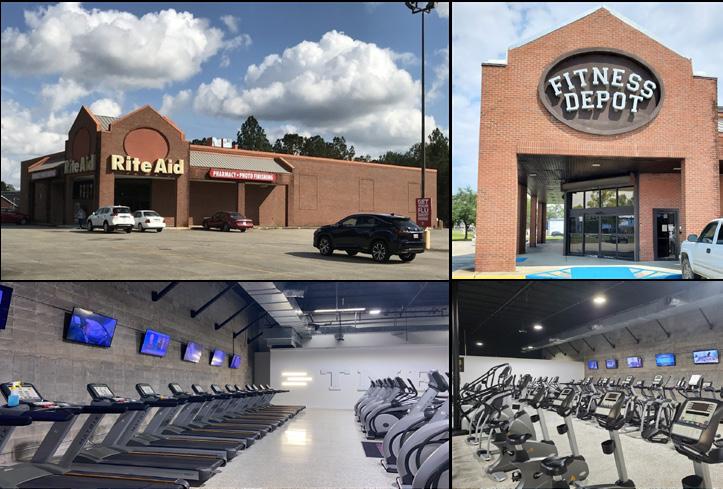
GOAL 7: Advance economic development through local businesses and services to meet residents’ daily needs
Expanding small businesses, services, and local shopping opportunities is essential to strengthening Paulsboro’s economy and improving residents’ quality of life. Many residents currently do their primary grocery shopping outside the community, highlighting a major gap in local food access. The sole grocery store in the community, the Save-A-Lot, is not a full-service supermarket and to-date does not have approval from the County to use WIC program vouchers to purchase produce from the store.
Beyond grocery access, residents have expressed dissatisfaction with the variety of goods and services available locally, noting the absence of key businesses such as a full-service supermarket, pharmacy, fitness or recreation facility, clothing store, full-service restaurant, and an urgent care or healthcare center. Addressing these gaps would not only increase local spending and economic activity but also enhance convenience and accessibility for residents, reducing the need to travel outside the community for basic needs.
STRATEGY 1:
Infill vacant commercial buildings and shopping areas
7.1 Advance redevelopment of the Paulsboro Plaza as a full-service community shopping center. Identify opportunities for either full-scale renovation or strategic infill development overtime.
7.2 Support the renovation and infill of existing commercial buildings on Broad and Delaware Streets.
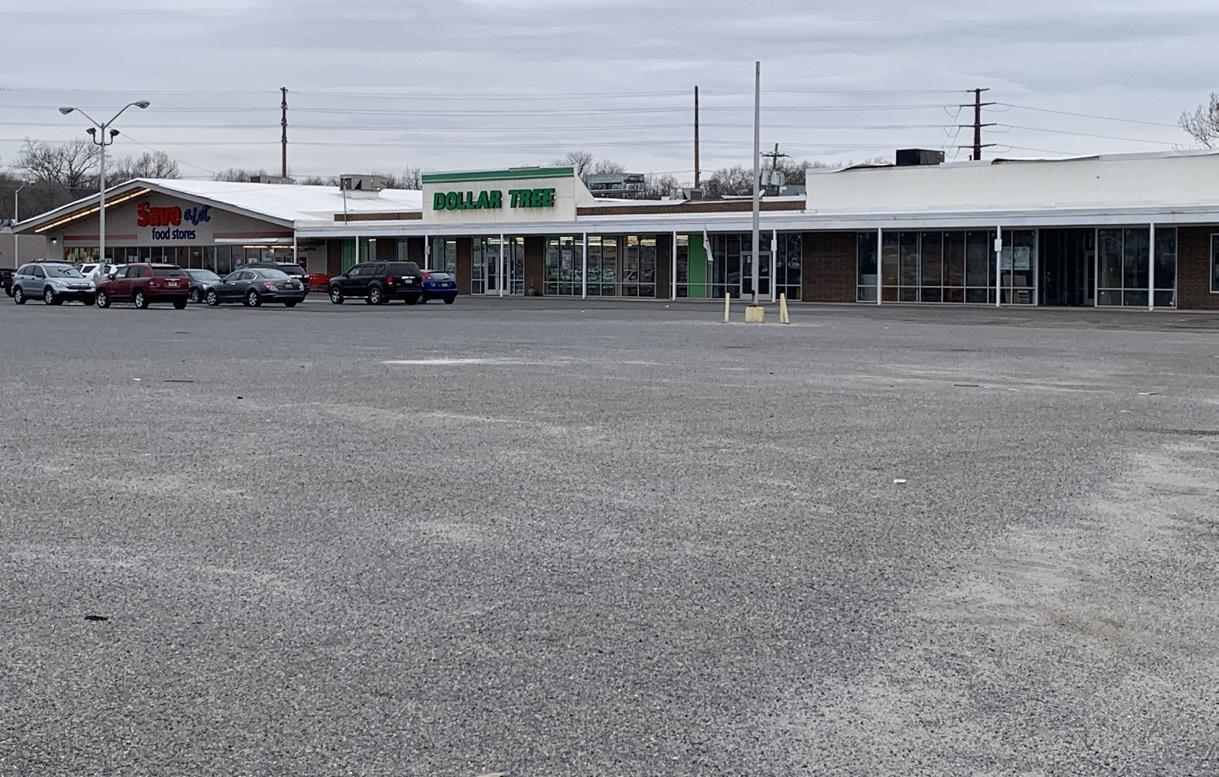
If you need anything, you have to leave Paulsboro to buy it. There are no doctors in town. We need to do something about that. All the dentists have left except for one.” ” “
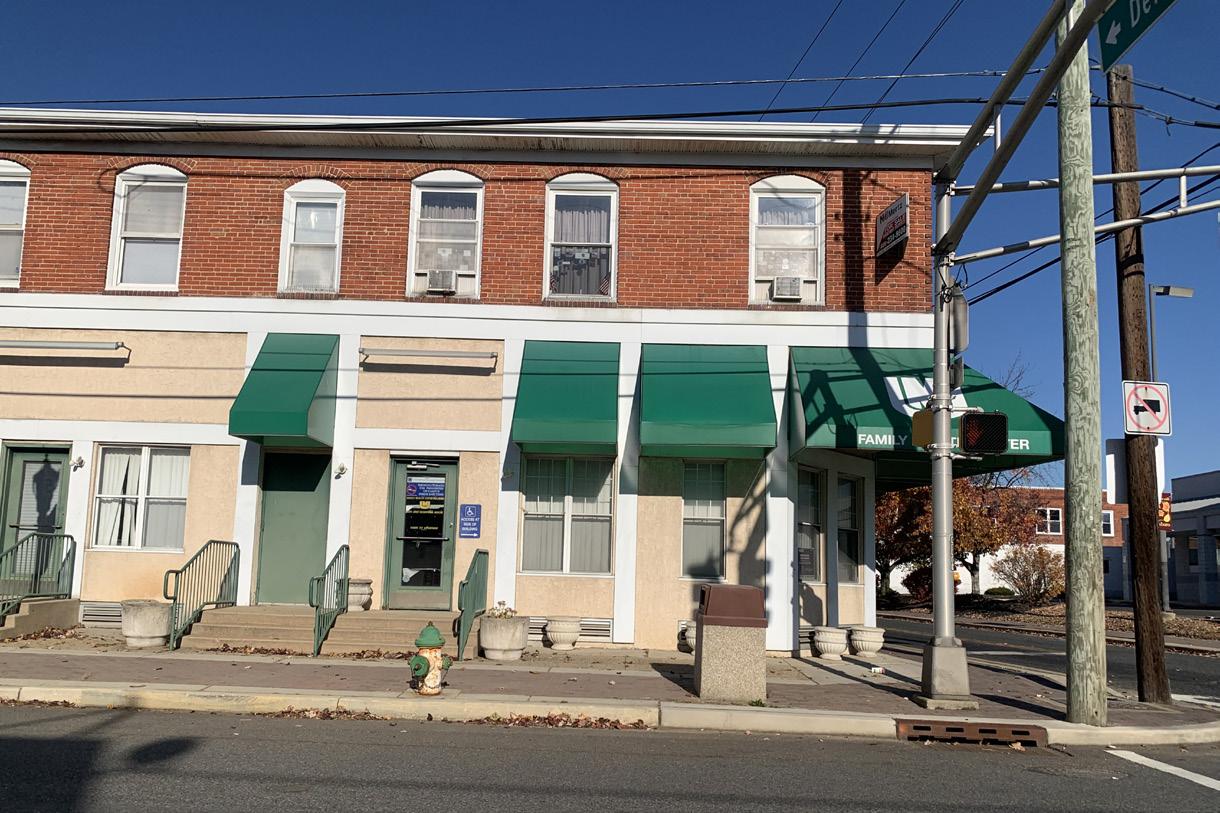
Existing conditions of the Paulsboro Plaza shopping center, which suffers from a high level of vacancy and underutilized land.
The partially vacant Underwood Office at Broad and Delaware Streets, with apartments above. This building is an example of vacant commercial buildings with excellent historic character in the Borough.
STRATEGY 2:
Provide support for new and existing businesses
7.3 Create a small business incubator to support both creators and makers working out of their home, and people with small brick-and-mortar businesses in Paulsboro.
7.4 Create a facade improvement program to support storefront improvements to local businesses. This can drive additional customers to neighborhood businesses while also improving the curb appeal of commercial streets.
7.5 Create a business owner spotlight program that highlights local Paulsboro business owners in social media, print media, and on the city’s website and email newsletters.
Figure 2.35: Facade Improvements for Commercial Buildings

Can churches work with food kitchen & CAP to figure out where they can help people get benefits? “ ”
STRATEGY 3:
Redesign Broad St./Route 44 to promote foot traffic
7.6 Redesign Broad Street/Route 44 to encourage commercial revitalization and more pedestrian activity. Broad Street, a state highway, has narrow sidewalks but excessively wide vehicle lanes, creating an opportunity to expand sidewalks that better serve the needs of local businesses and pedestrians. In the past ten years, Woodbury, NJ worked with the State to redesign their main commercial street (Broad St./Route 44) to eliminate excess vehicle lanes and add bike lanes.
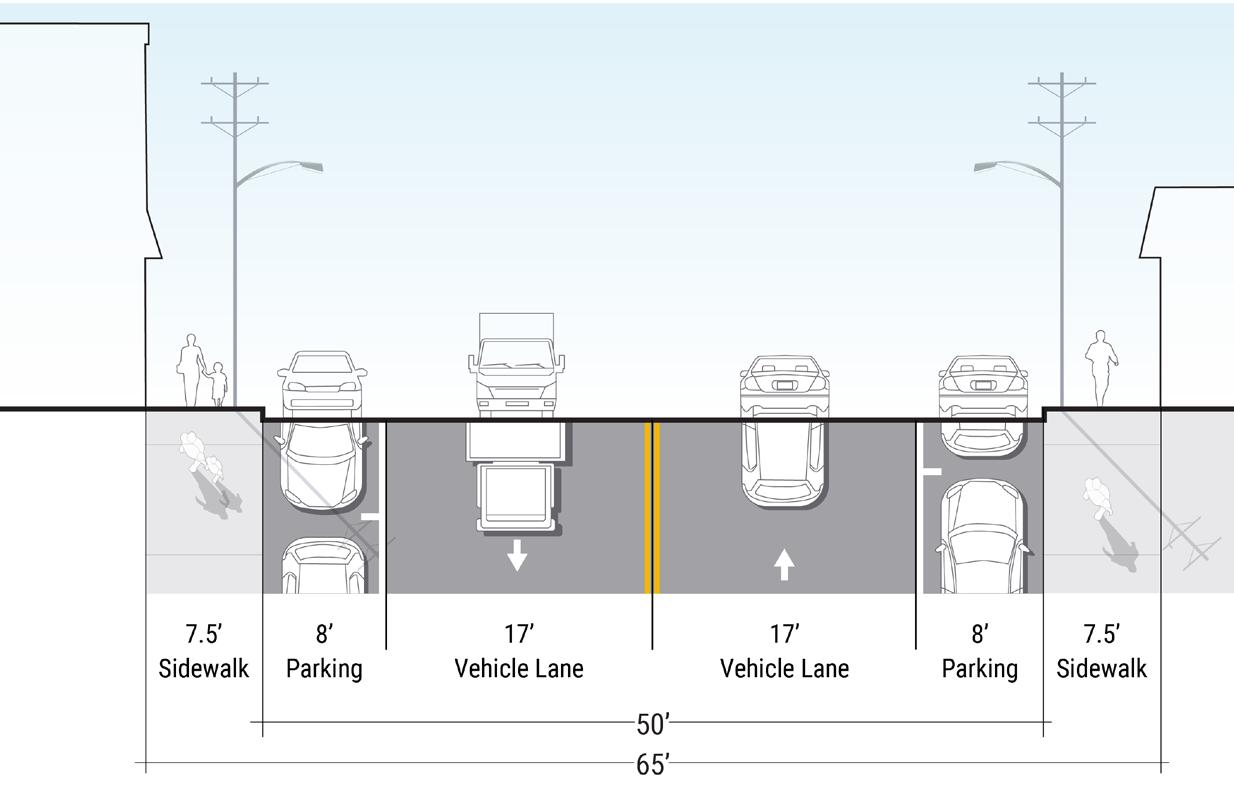
Proposed Option 1
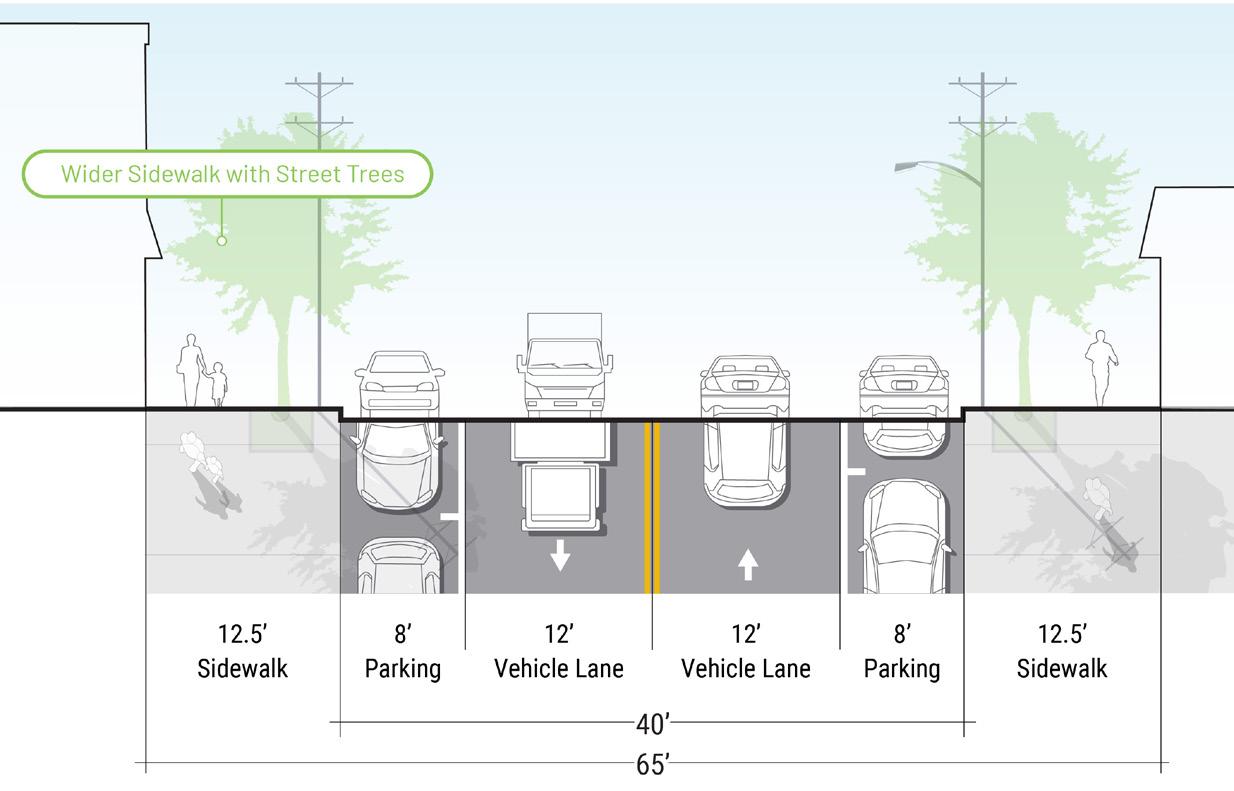
Proposed Option 2

Figure 2.36: Potential Redesign of Broad St. (near Delaware St.)


03 IMPLEMENTATION
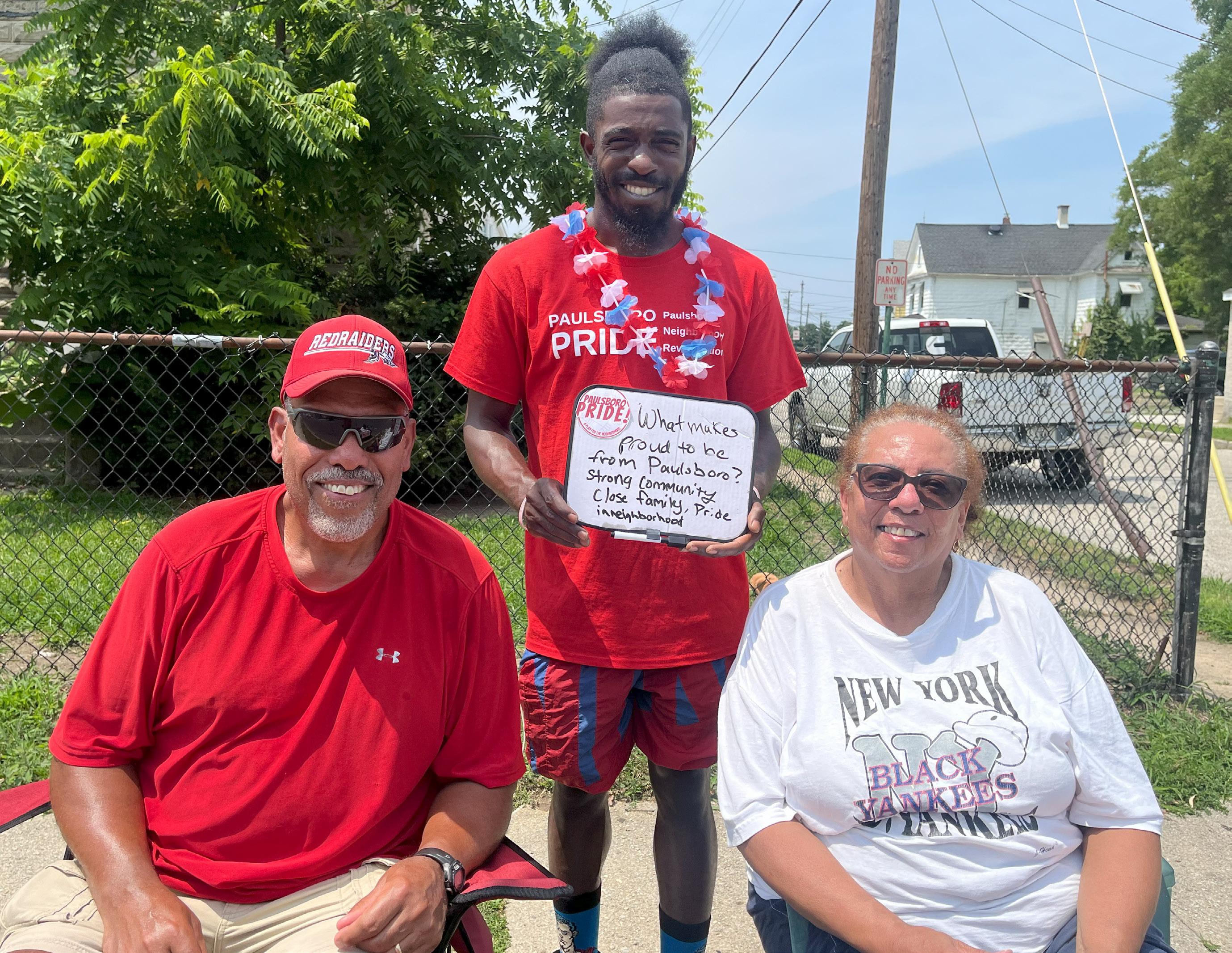
Implementation Approach
The Paulsboro Pride Neighborhood Plan was developed under the guidance of Gateway Community Action Partnership and the Plan’s Steering Committee with the substantial input of residents, the City, community organizations, institutions, youth, and stakeholders committed to the neighborhood’s revitalization. The Plan is a guide for neighborhood revitalization with a focus on the next 5-10 years.
Immediate next steps should include:
• Submit the Paulsboro Pride Neighborhood Plan to the Borough of Paulsboro for approval and adoption.
• Raise awareness about the Plan. Options include engaging communication methods such as developing a website and/or social media channel to share the Plan and provide details about how to get involved.
• Transition the Steering Committee into an Implementation Committee - a team of neighborhood groups, residents, institutions, and advocates ready to work with each other, the Borough, potential funders, and private partners to steer the Plan’s implementation and push for real change.
• Submit the Plan to the New Jersey Department of Community Affairs (NJDCA) Division of Community Resources for approval as a community-based comprehensive plan under the Neighborhood Revitalization Tax Credit (NRTC) program. Once approval is obtained, Gateway Community Partnership and its partners should file an application for funding for a year-
one package of proposed NRTC projects totaling up to $985,000 annually in proposed capital investments. At least 60% of the funds must be used for housing and economic development activities. Up to 40% of the funds may be used for supportive services, if applicable. If the plan receives NJDCA approval under the NRTC program, Paulsboro will be eligible for funding on a yearly basis of up to $985,000 for the next 10 years.
The Implementation Matrix shown in the following pages outlines the timeframe, potential partners, and funding for all of the strategies and actions in the Plan. It is a dynamic tool that is meant to be used as a guide for organizing and tracking the implementation progress, and should be updated as new partners and funding sources are identified.
STRATEGY #1—MAKE SAFETY A TOP PRIORITY IN PAULSBORO.
FOSTER POSITIVE POLICE-COMMUNITY RELATIONS
1.1
Encourage opportunities for regular community/police interactions to build trust with residents
1.2
1.3
Host bi-monthly meetings between residents and police to review community safety issues and collaboratively work through solutions
Provide a text message, 311, or similarly easy-touse anonymous service for residents to report nonemergency safety issues and improve communication with law enforcement
• Paulsboro Police Department
• Borough of Paulsboro
• Local Organizations
• Paulsboro Police Department
• VOA
• Safe Communities Coalition
• Paulsboro Police Department
• Borough of Paulsboro
Short (1-2 Years)
• Increase in public meetings and community activities involving PPD
• Improved trust between residents and PPD, improved resident perceptions of safety
Short (1-2 Years)
• 6-12 monthly meetings with residents and PPD per calendar year
• Improved trust between residents and PPD, improved resident perceptions of safety
• Creation of reporting system
Medium (3-5 Years)
• Improved trust between residents and PPD, improved resident perceptions of safety
• Year-over-year improvements in crime and clearance rate
1.4
1.5
Increase foot patrols around the neighborhood to deter crime in known hotspots and have a visible presence of officers at key times
Support a variety of activities that bring youth and local police together
• Paulsboro Police Department Short (1-2 Years)
• Increase in police presence in community
• Improved trust between residents and PPD, improved resident perceptions of safety
• Year-over-year improvements in crime and clearance rate
• Neighborhood Revitalization Tax Credit (NRTC)
• Local & National Foundations
• Corporate Sponsors, COPS Hiring Program (CHP - Federal)
• Paulsboro Police Department
• VOA
• Safe Communities Coalition Short (1-2 Years)
• Increase in community activities involving PPD and neighborhood youth
• Improved trust between residents and PPD, improved resident perceptions of safety
COORDINATE EFFORTS TO STRATEGICALLY ADDRESS SAFETY ISSUES
• Neighborhood Revitalization Tax Credit (NRTC)
• Local & National Foundations
1.6
Improve coordination across departments by creating a committee on public safety
• Paulsboro Police Department
• Borough of Paulsboro Short (1-2 Years)
• Creation of public safety committee that meetings monthly or quarterly
• Improved trust between residents and PPD, improved resident perceptions of safety
• Corporate Sponsors,
• Everytown Community Safety Fund CPTED Grants
• New Jersey Office of the Attorney General Community-Based Violence Intervention (CBVI) Program
1.7
1.8
Create a security camera incentive program
Use Crime Prevention Through Environmental Design (CPTED) to enhance lighting, maintain vacant spaces, and other safety-related physical improvements
1.9
• Paulsboro Police Department
• Borough of Paulsboro Short (1-2 Years)
• At least 10 new security cameras
• Year-over-year improvements in crime and clearance rate
• Paulsboro Police Department
• Borough of Paulsboro Medium (3-5 Years)
• Identification of hotspots for CPTED projects
• At least 1 CPTED project completed per year
• Elimination of crime hotspots identified
Regularly evaluate the effectiveness of crime prevention/safety interventions and adapt strategies as needed
• Paulsboro Police Department Short (1-2 Years)
• Improved trust between residents and PPD, improved resident perceptions of safety
• Year-over-year improvements in crime and clearance rate STRATEGY #2—LEVERAGE OUR
CELEBRATE THE CULTURAL DIVERSITY AND RICH HISTORY OF PAULSBORO
2.1
Incorporate the history of Paulsboro into the school’s curriculum, and provide field trips that help students see the important roles Paulsboro played in the early history of the United States.
2.2
2.3
Pursue grant funding to promote local historic tourism and storytelling
Host culture-focused events to celebrate the rich history of the community and its residents
• Paulsboro Historic Preservation Commission
• Paulsboro Public Schools Medium (3-5 Years)
• Paulsboro Historic Preservation Commission Short (1-2 Years)
• Paulsboro Historic Preservation Commission
• Local Partner Organizations & Institutions Short (1-2 Years)
• Borough of Paulsboro
• Chamber of Commerce
• Gateway CAP
2.4
• Neighborhood Revitalization Tax Credit (NRTC)
• Local & National Foundations
• Corporate Sponsors
• Everytown Community Safety Fund CPTED Grants
• New Jersey Office of the Attorney General Community-Based Violence Intervention (CBVI) Program
• New curriculum that integrates history of Paulsboro
• At least 1 field trip for grades 3-12 per year
• Increased Paulsboro Pride among young people
• Increased local knowledge about Paulsboro’s history
• Increase in historic tourism to Paulsboro
• Host at least four events per year related to local culture and history
• Increased local knowledge about Paulsboro’s history
• Increased Paulsboro Pride among young people
• NJ Council for Humanities
• Gloucester County Cultural and Heritage Commission
Create a welcome packet to introduce new residents and businesses to Paulsboro.
• Paulsboro Historic Preservation Commission
• Local Partner Organizations & Institutions Short (1-2 Years)
• Increased engagement with new residents
RECOGNIZE AND PROMOTE THE UNIQUE SKILLS AND TALENTS OF RESIDENTS
2.5
2.6
Host an all-ages Paulsboro talent show to celebrate the variety of skills and interests of residents
Create a directory highlighting the skills and services of local residents and businesses
• Boys and Girls Club
• Paulsboro Public Schools Short (1-2 Years)
• Borough of Paulsboro
• Chamber of Commerce Short (1-2 Years)
• At least 1 talent show held per year
• Increased Paulsboro Pride among young people
• Launch of directory listing at least 20 residents and local businesses
HOST A VARIETY OF EVENTS THROUGHOUT THE YEAR THAT BRING PAULSBORO RESIDENTS TOGETHER
• Local churches
2.7
2.8
Host regularly scheduled events that bring the entire community together
Create volunteer and paid opportunities for residents to connect with one another and work collaboratively on small projects and initiatives
• Borough of Paulsboro
• Community organizations
• Recreation Committee Short (1-2 Years)
• Local churches
• Borough of Paulsboro
• Community organizations
• Recreation Committee Short (1-2 Years)
• At least four community events per year (could include supporting/improving existing events or new ones)
• Increase in social connections between new and long-time neighbors
• At least four events, engaging at least 50 residents per year
• Increase in social connections between new and long-time neighbors
• Improved rating of cleanliness in the community (applicable for clean-up related projects)
• NJ Council for Humanities
• NJDEP Arts Grant Program
• Neighborhood Revitalization Tax Credit (NRTC)
• Local & National Foundations
2.9
Recruit younger leaders and volunteers to run and strengthen staple community events such as Paulsboro Day and the Juneteenth Event
• Borough of Paulsboro
• Paulsboro Day Event Planning Committee
• Boys and Girls Club,
• Paulsboro Public Schools
Short (1-2 Years)
• Recruit 2-5 new residents to event committees
• Neighborhood Revitalization Tax Credit (NRTC)
• Regional Foundation
• Neighborhood Revitalization Tax Credit (NRTC)
• Local & National Foundations
3.1
Build a community recreation center to provide a space for year-round, high quality programs and activities
• Gateway CAP
• Borough of Paulsboro
• County of Gloucester
Long (5-10+ years)
• A variety of year-round programs for youth and families of all ages and interest
• Improved health and fitness access & impact for youth in the community
• Corporate Sponsors
• Borough Capital Budget
• County of Gloucester
• Local Recreation Improvement Grants (LRIG)
• Green Acres Program
• Community Development Block Grant
3.2
Provide operational and capital support that recognizes Gill Memorial Library’s role as a community hub
• Gill Memorial Library
• Borough of Paulsboro
• Gateway CAP
• County of Gloucester Medium (3-5 Years)
• Provide opportunity for local residents to work with the children who frequent the library. Classes for adults who attend such as financial literacy, homeownership etc.
• Increase in visitors & membership to library
• Increase in programs offered and participants
•
3.3
Work with the Boys and Girls Club to build programs and staff supports to appeal to tweens and teens
3.4
Make improvements to the Baird Avenue Recreation Area
• Boys and Girls Club Borough of Paulsboro
• Gateway CAP
• Paulsboro Public Schools Short (1-2 Years)
• Increase in teens and tweens using the Boys & Girls Club
• Increase in programming for teens and tweens
• Greater variety alternative programs to keep teens active and involved throughout the community.
3.5
Resolve issues with the Kaboom Playground and add amenities at Buck Street Park.
• Borough of Paulsboro
• Gateway CAP
• County of Gloucester
• Paulsboro Public Schools Medium (3-5 Years)
• Borough of Paulsboro
• Gateway CAP Short (1-2 Years)
• Increase in number of visitors using the recreation area
• Improved satisfaction with public spaces in Paulsboro
• Increase in number of visitors using Buck Street Park
• Improved satisfaction with public spaces in Paulsboro
• Neighborhood Revitalization Tax Credit (NRTC)
• Local & National Foundations
• Corporate Sponsors
• Borough Capital Budget
• County of Gloucester
• Local Recreation Improvement Grants (LRIG)
• Green Acres Program
• Community Development Block Grant
3.6
Leverage planned investments in Fort Billings Park to create a permanent natural park for residents with access to the waterfront and shore
• Borough of Paulsboro
• Gateway CAP
• County of Gloucester Short (1-2 Years)
• Improved public space and waterfront access, increase in number of users at Fort Billings Park
• Increased local knowledge about Paulsboro’s history
• Increase in historic tourism to Paulsboro
3.7
Consider establishing adult recreation leagues in Paulsboro
• Borough of Paulsboro
• Gateway CAP
• County of Gloucester Short (1-2 Years)
• Improved satisfaction with public spaces in Paulsboro
• Increase in social connections between new and long-time neighbors
SUPPORT
A WIDE VARIETY OF YEAR-ROUND, HIGH-QUALITY PROGRAMS FOR YOUTH OF ALL AGES
• Gateway CAP
3.8
Create youth-oriented programs and events, such as a summer play streets program, to keep youth active and engaged in the summer
3.9
Provide financial and in-kind support to a wide variety of after-school and summer programs for youth of all ages
• Borough of Paulsboro
• Paulsboro Police Department
• Boys and Girls Club
• Paulsboro Public Schools Short (1-2 Years)
• Greater number of high-quality activities available for youth during summer break of all ages
• Provide youth in the community with safe, fun activities while engaging with local law enforcement.
• Increase in availability of high-quality afterschool and summer programs for all ages
3.10
Support high-quality daycare, aftercare, and pre-school programs
• Boys and Girls Club
• Paulsboro Public Schools Short (1-2 Years)
• Increased enrollment in after-school and summer programs
• Increased satisfaction of both parents and kids
• Neighborhood Revitalization Tax Credit (NRTC)
• Local & National Foundations
• Grow NJ
3.11
Seek funding to use public school facilities for programming that happens outside of school hours
• Local Childcare Centers
• Head Start
• Paulsboro Public Schools Medium (3-5 Years)
• Increase in the number of high-quality daycare and pre-school programs in Paulsboro
• Long-term improved academic outcomes associated with enrollment in pre-school programs
3.12
Provide employment, enrichment, and careerdevelopment programs for youth
• Gateway CAP
• Borough of Paulsboro
• County of Gloucester
• Paulsboro Public Schools Short (1-2 Years)
• Chamber of Commerce
• Borough of Paulsboro
• Gateway CAP
• County of Gloucester
• Paulsboro Public Schools
• Local Employers Medium (3-5 Years)
MAKE IT SAFER TO WALK IN PAULSBORO FOR KIDS OF ALL AGES
• Gateway CAP
3.13
Start a walking school bus to make it safer for children to walk to and from school
• Borough of Paulsboro
• Paulsboro Public Schools
• Local Parents Short (1-2 Years)
• Increase in availability of all-season programming for youth
• Increased enrollment in after-school programs
• Increased satisfaction of both parents and kids
• Create job opportunities for youth in the community
• Provide ways for youth to stay active during the summer months
• Support local businesses
• Increase in children of all ages walking safely to school in groups
• Increase in engaged parent volunteers
• Neighborhood Revitalization Tax Credit (NRTC)
• Local & National Foundations
• Neighborhood Revitalization Tax Credit (NRTC)
• Local & National Foundations
• NJ Department of Environmental Protection (NJDEP) Youth Inclusion Initiative
• New Jersey Youth Service Collaborative (NJYSC) Scholarships
• New Jersey YouthBuild Program
• Neighborhood Revitalization Tax Credit (NRTC)
• Local & National Foundations
• Safe Routes to School Grants
3.14
Advocate for infrastructure maintenance (sidewalks, lighting, crosswalks) and traffic calming to make safer streets for pedestrians
• Borough of Paulsboro
• Gateway CAP
• County of Gloucester
• Relevant Jurisdictions & Property Owners Long (5-10+ years)
• Reduction in accidents involving pedestrians
• Improved feeling of safety walking during the day or night
• Neighborhood Revitalization Tax Credit (NRTC)
• Local & National Foundations
• Safe Routes to School Grants
STRATEGY #4— CLEAN AND BEAUTIFY THE COMMUNITY IN A WAY THAT SHOWS OUR “PAULSBORO PRIDE“.
BEAUTIFY VACANT LOTS AND UNDERUTILIZED SPACES
• Gateway CAP
4.1
4.2
Start a community gardens program, prioritizing underutilized open space or vacant lots that are unlikely to be developed
Start a neighborhood cleanup initiative to supplement existing clean-up programs and target areas in-need
4.3
Start a sideyard program, where a neighboring homeowner can acquire a vacant lot next door to their home
• Paulsboro Public Schools
• Boys and Girls Club
• Senior Center
• Gill Library Short (1-2 Years)
• Gateway CAP
• Borough of Paulsboro Short (1-2 Years)
• Enhance nutrition and help combat food insecurity in the community
• Increase access and availability of healthy food
• Community beautification in the neighborhood
• More residents engaged in small actions to improve their community
• Cleaner streets and public spaces
• Borough of Paulsboro
• Gateway CAP Medium (3-5 Years)
• Fewer vacant and unmaintained vacant lots
• Cleaner streets and public spaces
ADDRESS TRASH, LITTER, AND ILLEGAL DUMPING
4.4 Improve trash and recycling services
4.5 Map hotspots for illegal dumping and develop sitespecific strategies to alleviate the issue
• Borough of Paulsboro
• Gateway CAP Short (1-2 Years)
• Provide additional opportunities for residents to dispose of household trash
• Educate residents on current trash/recycling initiatives
• Find additional ways to get more residents involved with the recycling/trash program
• Neighborhood Revitalization Tax Credit (NRTC)
• Local & National Foundations
• USDA NRCS Community Gardens/Farm Grant Opportunity
• NJDEP Clean Communities Program
• Native Plant Society of New Jersey (NPSNJ) Mini-Grants
• Sustainable Jersey Grants
• Borough of Paulsboro
• Paulsboro Police Department Short (1-2 Years)
• Identify areas were illegal dumping is occurring
• Design interventions that reduce illegal dumping across the borough
• Cleaner streets and public spaces
• Neighborhood Revitalization Tax Credit (NRTC)
• Local & National Foundations
• NJDEP Clean Communities Program
SHOW PAULSBORO’S PRIDE AT KEY ROUTES AND GATEWAYS
4.6
Implement traffic calming, pedestrian safety, and beautification elements at Delaware Avenue and Broad Street
4.7
Work with the owner of Paulsboro Plaza to activate the parking lot using low-cost, high-impact strategies
• Borough of Paulsboro
• Gateway CAP
• County of Gloucester
• NJ-DOT Medium (3-5 Years)
• Development of elements aimed to beautify the downtown area of the neighborhood
• Reduction in accidents involving pedestrians
• Improved feeling of safety walking during the day or night
• Increased investment in commercial buildings on both corridors
• Neighborhood Revitalization Tax Credit (NRTC)
• Local & National Foundations
• New Jersey Department of Transportation (NJDOT) Municipal Aid Program
• Local Transportation Projects Fund
4.8
Develop an ordinance that allows and supports murals and seek grant funding that supports the addition of murals and public art in highvisibility locations throughout the neighborhood
• Gateway CAP
• Property Owner
• Borough of Paulsboro
• Local Artists & Designers Short (1-2 Years)
• Borough of Paulsboro
• Gateway CAP
• Local Artists & Designers Short (1-2 Years)
• Create a safer parking area for residents
• Less incidents/accidents in Paulsboro Plaza
• Improve shopping experiencing for those visiting the Plaza
• Create opportunity for arts in the community
• Create visually appealing spaces throughout the community
• Neighborhood Revitalization Tax Credit (NRTC)
• Local & National Foundations
• NJDEP Clean Communities Program
• New Jersey State Council on the Arts Grants
• NJEDA’s A.R.T. Phase II Program
4.9
Implement streetscape improvements to key streets, such as planters and banners
• Borough of Paulsboro
• Gateway CAP
• Local Artists & Designers Short (1-2 Years)
• Create opportunities for community beautification and commercial corridor enhancement
• Create visually appealing spaces throughout the community
• Neighborhood Revitalization Tax Credit (NRTC)
• Local & National Foundations
• New Jersey Department of Transportation (NJDOT) Municipal Aid Program
• Local Transportation Projects Fund
STRATEGY #5—PROMOTE STABLE/ACCESSIBLE HOUSING OPTIONS TO HELP EXISTING/NEW RESIDENTS
5.1
Provide financial support to prospective homeowners by offering down payment assistance, savings matching programs, or low-interest loans to first-time homebuyers.
• Gateway CAP
• Local Financial Institutions Medium (3-5 Years)
• Partner with local institutions to develop programs that provide financial support to first-time home buyers
• Grow homeownership in Paulsboro
• Neighborhood Revitalization Tax Credit (NRTC)
• Local & National Foundations
5.2
Help prospective homeowners learn the steps they need to take to own a home by providing credit counseling and homeownership education
• Gateway CAP
• Local Financial Institutions Medium (3-5 Years)
• Partner with local institutions to develop programs that help prepare potential buyers
• Grow homeownership in Paulsboro
• U.S. Department of Housing and Urban Development (HUD) Housing Counseling Grants
• New Jersey Housing and Mortgage Finance Agency (NJHMFA) Programs
5.3
Create an emergency rental fund to help renters in times of crisis
• Gateway CAP
• VOA Short (1-2 Years)
• Develop a program that provides emergency rental assistance to those behind in their rental payments.
PRESERVE AND REHABILITATE EXISTING HOUSING
5.4
Create a home repair program to help with necessary health and safety upgrades
5.5
Start a “Front Porch” program to address exterior home improvements
• Gateway CAP Medium (3-5 Years)
• Help residents whose homes may be in need for repair but can not afford to make the upgrades.
• Improve the appearance of homes and properties in neighborhoods
• Neighborhood Revitalization Tax Credit (NRTC)
• Local & National Foundations
• U.S. Department of Housing and Urban Development (HUD) Housing Counseling Grants
• New Jersey Housing and Mortgage Finance Agency (NJHMFA) Programs
5.6
Address rental housing conditions through improved code enforcement
PROMOTE INFILL DEVELOPMENT
5.7
Acquire vacant properties and land for infill housing development
5.8
Use publicly-owned land for strategic infill development and housing rehabilitation
• Gateway CAP Medium (3-5 Years)
• Help residents whose home exteriors may be in need for repair but can not afford to make the upgrades.
• Improve the appearance of homes and properties in neighborhoods
• Cite landlords whose properties have code violations, incentivizing landlords to bring buildings up to code
• Neighborhood Revitalization Tax Credit (NRTC)
• Local & National Foundations
• USDA Section 504 Home Repair Program
• New Jersey Housing and Mortgage Finance Agency (NJHMFA)
• Borough of Paulsboro Short (1-2 Years)
• Improve the appearance of homes in the neighborhood by holding renters accountable for keeping their properties maintained
5.9
Develop new affordable and market rate housing
• Gateway CAP
• Borough of Paulsboro Short (1-2 Years)
• Work with the Borough to acquire 20+ properties for infill housing development
• Gateway CAP
• Borough of Paulsboro Medium (3-5 Years)
• Develop a housing strategy with the Borough for the disposition and use of publicly owned land to meet housing needs
• Grow homeownership in Paulsboro
• Increase in amount of high-quality affordable and market rate housing
• Neighborhood Revitalization Tax Credit (NRTC)
• Local & National Foundations
• New Jersey Affordable Housing Trust Fund (AHTF)
• HOME Investment Partnerships Program
• Community Development Block Grants (CDBG)
• Gateway CAP
• Borough of Paulsboro Medium (3-5 Years)
• Grow homeownership in Paulsboro
• Increase in the share of renters who would like to buy a home in the community
• Low-Income Housing Tax Credit (LIHTC) Program
• New Jersey Community Capital (NJCC)
STRATEGY #6— MAKE PAULSBORO A COMMUNITY WHERE PEOPLE CAN AFFORD A GOOD QUALITY OF LIFE.
IMPROVE
TRANSIT SERVICE TO MAJOR DESTINATIONS OUTSIDE OF PAULSBORO
6.1
Work with NJTransit to advocate for service improvements to the NJ-402 bus line
• Gateway CAP
• Borough of Paulsboro
• NJ Transit
• County of Gloucester Medium (3-5 Years)
• Improved bus service with additional service hours and more frequent, faster service to major destinations
• Help to promote the shuttle bus service available throughout town
6.2 Support the Borough’s shuttle bus service
• Borough of Paulsboro Medium (3-5 Years)
• Support need for increased route options
• Assist with promotion and advertising of this service
• Neighborhood Revitalization Tax Credit (NRTC)
• Local & National Foundations
• NJ TRANSIT Local Programs Funding
• NJDOT Local Transportation Projects Fund
• NJDOT Safe Streets to Transit (SSTT) Program
• NJTPA Local Transit Grants
6.3
Connect Paulsboro to Gloucester County’s MultiPurpose Trail System
• Borough of Paulsboro
• Gloucester County Long (5-10+ years)
• Provide residents with alternate transportation options outside of the local community.
IMPROVE ACCESS TO EMPLOYMENT OPPORTUNITIES AND TRAININGS
6.4
Work with the Chamber of Commerce to hold workforce development trainings and mentorship programs
6.5
Work with local colleges and universities to create accessible job training programs
6.6
Host job fairs in the community to connect local employers with skilled residents
• Chamber of Commerce Medium (3-5 Years)
• Create programs that expand job training opportunities for local residents.
• Improve employment and career-prospects for residents
• Rowan College of South Jersey Medium (3-5 Years)
• Chamber of Commerce
• Local Employers Short (1-2 Years)
SUPPORT NEIGHBORHOOD-BASED SOCIAL SERVICES
6.7
Explore grants and opportunities to partner with schools and local institutions to create or expand social programs serving families with children
• Paulsboro Public Schools
• Gateway CAP Short (1-2 Years)
• Increase opportunities for easily accessible programs either held in the community or provide resources to allow residents to get to the training programs.
• Work with local leaders to host job/ employment fair for local employers to attract individuals looking for employment.
• Neighborhood Revitalization Tax Credit (NRTC)
• Local & National Foundations
• New Jersey Department of Labor and Workforce Development (NJDOL) Grant Programs
• New Jersey Economic Development Authority (NJEDA) Initiatives
• New Jersey Business Action Center (NJBAC) Resources
• New Jersey Pay It Forward
6.8
Work with partners and advocate to improve pharmaceutical access in Paulsboro
• CAMCare
• Gateway CAP Medium (3-5 Years)
• Develop partnerships with local organizations
• Create opportunities for more resources
• Provide additional services for those in need
• Advocate for a pharmacy to come to the community
• Neighborhood Revitalization Tax Credit (NRTC)
• Local & National Foundations, Community Services Block Grant (CSBG)
• Social Services Block Grant (SSBG)
• WorkFirst New Jersey (WFNJ)
• Age-Friendly Community Grants
6.9
Work with local social service organizations to provide services in the community
6.10 Address food insecurity
• CAMCare, Volunteers of America
• GCBGC others Short (1-2 Years)
• Local churches
• Local non-profits
• Local farmers
• Institutional partners Short (1-2 Years)
• Create and strengthen partnerships with other local organizations.
• Work with community, county and state leaders to develop strategies to improve food insecurity in the community.
• Partner with the local food banks and distribution sites to improve food access.
• Neighborhood Revitalization Tax Credit (NRTC)
• Local & National Foundations, Community Services Block Grant (CSBG)
• Social Services Block Grant (SSBG)
• WorkFirst New Jersey (WFNJ)
• Age-Friendly Community Grants
STRATEGY #7—ADVANCE ECONOMIC DEVELOPMENT THROUGH LOCAL BUSINESSES & SERVICES TO MEET RESIDENTS’ DAILY NEEDS.
VACANT COMMERCIAL BUILDINGS AND SHOPPING AREAS
7.1
Advance redevelopment of the Paulsboro Plaza as a fullservice community shopping center
7.2
Support the renovation and infill of existing commercial buildings on Broad and Delaware Streets
• Property Owner
• Borough of Paulsboro
• Chamber of Commerce Long (5-10+ years)
• Bring additional businesses to the community
• Creation of jobs for local residents
• More places for local residents to shop for necessities
• More revenue generation businesses for the town
• Bring additional businesses to the community
• Creation of jobs for local residents
• Neighborhood Revitalization Tax Credit (NRTC)
• Local & National Foundations
• Local Property Acquisition Grant Program
• Neighborhood Preservation Program (NPP)
• Borough of Paulsboro
• Gateway CAP Long (5-10+ years)
PROVIDE SUPPORT FOR NEW AND EXISTING BUSINESSES
• Borough of Paulsboro
7.3 Create a small business incubator
7.4 Create a facade improvement program
• Rowan College of South Jersey Medium (3-5 Years)
• Borough of Paulsboro
• Gateway CAP
• Chamber of Commerce Medium (3-5 Years)
• More places for local residents to shop for necessities
• More revenue generation businesses for the town
• Cleanup the downtown area
• Support local small businesses that have limited resources
• Provide opportunities for development and business classes
• Create space for small businesses to have a physical location
• Improve the exterior of local businesses to make them more appealing and inviting
• Neighborhood Revitalization Tax Credit (NRTC)
• Local & National Foundations
• Local Property Acquisition Grant Program
• Neighborhood Preservation Program (NPP)
7.5 Create a business owner spotlight program
• Chamber of Commerce Short (1-2 Years)
• Create a program the highlights local businesses throughout the community
• Provide opportunity for local businesses to promote their services
• Redevelop the commercial corridors of the community
• Neighborhood Revitalization Tax Credit (NRTC)
• Local & National Foundations
• Local Property Acquisition Grant Program
• Neighborhood Preservation Program (NPP)
7.6 Redesign Broad Street/Route 44 to encourage commercial revitalization and more pedestrian activity
• Borough of Paulsboro
• Gateway CAP
• County of Gloucester
• NJ-DOT Long (5-10+ years)
• More people visiting and walking along commercial corridors
• Increased investment in commercial corridor properties
• Improved opportunities for local business owners
• Neighborhood Revitalization Tax Credit (NRTC)
• Local & National Foundations
• NJDOT Municipal Aid Program
• New Jersey’s Statewide Transportation Improvement Program (STIP)



APPENDIX 04
Executive Summary
The Paulsboro Pride Neighborhood, home to over 4,000 residents, represents the heart of the Borough, accounting for 65% of its total population. It is a diverse community, yet economic disparities persist, with median household incomes significantly lower than the county average and unemployment rates more than double those of the broader region. Housing affordability is a growing concern, particularly among renters, highlighting financial strain within the community.
In recent years the Paulsboro Pride Neighborhood has experienced increasing challenges. Rising crime, deteriorating housing conditions, and vacant lots have negatively impacted perceptions of safety and quality of life. The neighborhood has transitioned from a majorityhomeowner to a majority-renter community, reflecting broader housing market pressures. Additionally, the loss of major pharmacy chains, a full-service grocery store, and the designation of Paulsboro as a food desert underscore difficulties in accessing essential goods and services, particularly for those without reliable transportation.
Educational underperformance and a lack of youth programming further challenge the community’s longstanding identity as an ideal place to raise a family. However, residents remain deeply committed to revitalization, and the Paulsboro Pride Neighborhood Plan reflects their collective vision for a stronger, more equitable future.
Developed through extensive public engagement, the Plan incorporates feedback from residents, business owners, and community stakeholders. Outreach efforts included surveys, focus groups, and interactive events at key gatherings such as Juneteenth and Paulsboro Day. This inclusive process ensures that the Plan is rooted in community aspirations, providing a roadmap for economic renewal, housing stability, and enhanced public amenities.
The Paulsboro Pride Neighborhood Plan outlines seven goals and action steps intended to realize the community’s vision for the future of their neighborhood:
1. Make safety a top priority.
2. Bring back the Paulsboro Pride, and strengthen and restore the feeling of Paulsboro as a village.
3. Ensure Paulsboro is a great place for young people to grow up and a great place to raise a family.
4. Clean and beautify the community in a way that reflects the pride residents have for Paulsboro.
5. Promote stable and accessible housing options to help existing and new residents establish long-term roots.
6. Strive to make Paulsboro a community where people can afford a good quality of life.
7. Advance economic development through local businesses and services to meet residents’ daily needs.

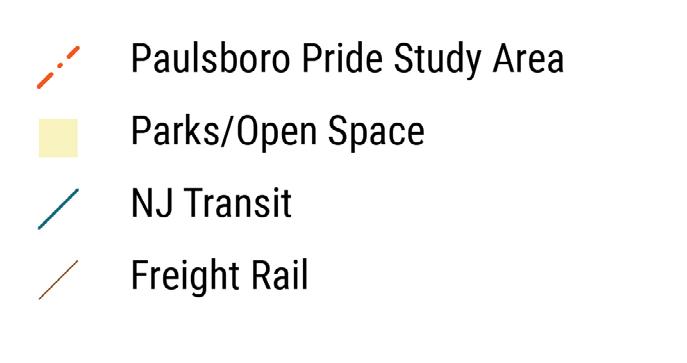
Figure 4.37: Paulsboro Pride Neighborhood
Demographics
Median Household Income (Adjusted for 2025 inflation)
Poverty
Groups 1, 2, & 3 encompass the majority of the neighborhood)
Tenure
Housing Cost Burden
INCOME
Area Median Income (AMI)
Moderate-to low-income (80% of AMI)
$114,700
$91,760
% of Paulsboro Census Tract Households at moderate-low income >53.8%
Low-income (50% of AMI)
$57,350
% of Paulsboro Census Tract Households at low income >38.3%
The Philadelphia-Camden-Wilmington, PA-NJ-DE-MD MSA contains the following areas: New Castle County, DE; Cecil County, MD; Burlington County, NJ; Camden County, NJ; Gloucester County, NJ; Salem County, NJ; Bucks County, PA; Chester County, PA; Delaware County, PA; Montgomery County, PA; and Philadelphia County, PA
Source: HUD’s FY 2024 for Philadelphia-Camden-Wilmington, PA-NJ-DE-MD MSA
Neighborhood Assets
COMMUNITY ASSETS
Medical
• CAMCare Health Center: CAMCare at 1000 N Delaware St, Paulsboro, NJ 08066
Transportation
NJ Transit Bus, Routes: 455, 402 and 410, including bus stops at:
• BROAD ST AT CEDAR AVE
• BROAD ST (RT 44) AT CHESTNUT ST
• BROAD ST (RT 44) AT PINE ST
• BROAD ST AT CEDAR AVE
• BROAD ST (RT 44) 250’N OF SOUTH COMMERCE ST
• BROAD ST (RT 44) 50’N OF PAUL AVENUE
Educational
• Gateway CAP Head Start/Early Head Start: 910 N. Delaware St. Paulsboro, NJ 08066
• Loudenslager Elementary School: 100 Baird Ave, Paulsboro, NJ 08066
• Paulsboro High School: 670 N Delaware St, Paulsboro, NJ 08066 (outside of neighborhood)
• Billingsport Early Learning Center: 441 Nassau Ave, Paulsboro, NJ 08066 (outside of neighborhood)
PARKS AND RECREATION
Parks
• Buck Street Park, 311 W. Buck Street Paulsboro, NJ 08066
• Baird Avenue Recreation Area at Loudenslager Elementary School: 100 Baird Ave, Paulsboro, NJ 08066
• Waterfront: Fort Billings Park, Paulsboro, NJ 08066 (outside of neighborhood)
Ballfields
• Baird Avenue Recreation Area at Loudenslager Elementary School: 100 Baird Ave, Paulsboro, NJ 08066
• Near Paulsboro High School: 670 N Delaware St, Paulsboro, NJ 08066 (outside of neighborhood)
• Little League Football/Baseball Fields 136 Mantua Ave Paulsboro, NJ 08066 (outside of neighborhood)
Sports Courts
• Basketball Courts at Baird Ave. Recreation Area at Loudenslager Elementary School: 100 Baird Ave, Paulsboro, NJ 08066
• Track Court Near Paulsboro High School: 670 N Delaware St, Paulsboro, NJ 08066 (outside of neighborhood)
Community
• Boys and Girls Club: 301 Mantua Ave, Paulsboro, NJ 08066
• Elks Lodge: 275 W Buck St, Paulsboro, NJ 08066
• Gill Memorial Library: 145 E Broad St, Paulsboro, NJ 08066
• Paulsboro Senior Citizens Center: 28 E Broad St, Paulsboro, NJ 08066
• Sons of Italy In America-Lodge 2580, 525 W Broad St Paulsboro, New Jersey
• Mt. Carmel UMAE Church: 126 Gill Ave, Paulsboro, NJ 08066
• Second Baptist Church: 1540 Swedesboro Ave, Paulsboro, NJ 08066
• Visions Christian Center: 812 N Delaware St, Paulsboro, NJ 08066
• St Paul’s UMC: 16 E Broad St, Paulsboro, NJ 08066
• Paulsboro Borough Munipal Department: 1211 N Delaware St, Paulsboro, NJ 08066
Celebrations
• Paulsboro Day (annually)
• Juneteenth Celebration (annually)
• Fourth of July Parade on Delaware Street (annually)
• Memorial Day Service (annually)
• Tree Lighting Ceremony (annually)
Regional Assets
NEARBY COMMUNITY CENTERS
• Riverwinds Community Center: 1000 Riverwinds Dr, West Deptford, NJ 08086
• Hispanic Family Center Woodbury: 21 Delaware St, Woodbury, NJ 08096
• Deptford Township Community Center: 1219 Delsea Dr, Westville, NJ 08093
• Mosiac Family Success Center 110 High St E, Glassboro, NJ 08028
LOCAL EMPLOYERS
• Exxon Mobil Lube Plant: 1001 Billingsport Rd, Paulsboro, NJ 08066
• Paulsboro Refinery PBF: 800 Billingsport Rd, Paulsboro, NJ 08066
• Amazon Fullfillment Center, 240 Mantua Grove Rd, West Deptford, NJ 08066
• Paulsboro Public School District: 670 N Delaware St, Paulsboro, NJ 08066
REGIONAL INSTITUTIONS & CARE PROVIDERS
• Inspira Health Center Woodbury: 30 Oak St, Woodbury, NJ 08096
• Inspira Medical Center Mullica Hill: 700 Mullica Hill Rd, Mullica Hill, NJ 08062
• Jefferson Washington Township Hospital: 435 HurffvilleCross Keys Rd, Sewell, NJ 08080
• Virtua Our Lady of Lourdes Hospital: 1600 Haddon Ave, Camden, NJ 08103
• Rowan University: 129 Broadway, Camden, NJ 08102
• Acenda: 42 Delsea Dr S, Glassboro, NJ 08028
• County of Gloucester Health Department: 204 E Holly Ave, Sewell, NJ 08080
• Gloucester County Workforce Development Board: 1480 Tanyard Road Suite B Sewell, NJ 08080
• Carter Medical Associates: 321 E Broad St, Gibbstown, NJ 08027
• South Jersey Family Medicine: 831 Kings Hwy # 100, West Deptford, NJ 08096
REGIONAL PERFORMANCE SPACE
• Freedom Mortgage Pavilion: 1 Harbour Blvd, Camden, NJ 08103
Form NP-3
STRATEGY #1—MAKE SAFETY A TOP PRIORITY IN PAULSBORO.
FOSTER POSITIVE POLICE-COMMUNITY RELATIONS
1.1
Encourage opportunities for regular community/police interactions to build trust with residents
1.2
Host bi-monthly meetings between residents and police to review community safety issues and collaboratively work through solutions
• Increase in public meetings and community activities involving PPD
• Improved trust between residents and PPD, improved resident perceptions of safety
• 6-12 monthly meetings with residents and PPD per calendar year
• Improved trust between residents and PPD, improved resident perceptions of safety
• Documentation of public meetings and community activities throughout the year
• Improved ranking of “Safety in the Community” and “Quality of Public services” (Q5 from Neighborhood Survey)
• Documentation of monthly public meetings and sign-in sheets
• Improved ranking of “Safety in the Community” and “Quality of Public services” (Q5 from Neighborhood Survey)
• List of meetings and activities with PPD, including sign-in sheets where applicable
• Neighborhood Survey
• List of meetings, minutes, and sign-in sheets
• Neighborhood Survey
1.3
Provide a text message, 311, or similarly easy-touse anonymous service for residents to report nonemergency safety issues and improve communication with law enforcement
• Creation of reporting system
• Improved trust between residents and PPD, improved resident perceptions of safety
• Year-over-year improvements in crime and clearance rate
• Increase in police presence in community
• Number of residents that are signed up and actively use the service
• Improved ranking of “Safety in the Community” and “Quality of Public services” (Q5 from Neighborhood Survey)
• Reduction in crime and improvements in clearance rates
• Number and frequency of foot patrols
1.4
Increase foot patrols around the neighborhood to deter crime in known hotspots and have a visible presence of officers at key times
• Improved trust between residents and PPD, improved resident perceptions of safety
• Year-over-year improvements in crime and clearance rate
• Improved ranking of “Safety in the Community” and “Quality of Public services” (Q5 from Neighborhood Survey)
• Reduction in crime and improvements in clearance rates
• Reporting system usage data
• Neighborhood Survey
• Crime data from PPD
1.5
Support a variety of activities that bring youth and local police together
• Increase in community activities involving PPD and neighborhood youth
• Improved trust between residents and PPD, improved resident perceptions of safety
1.6
Improve coordination across departments by creating a committee on public safety
• Creation of public safety committee that meetings monthly or quarterly
• Improved trust between residents and PPD, improved resident perceptions of safety
• Documentation of youth-focused community activities throughout the year
• Improved ranking of “Safety in the Community” and “Quality of Public services” (Q5 from Neighborhood Survey)
• Documentation of public safety committee meetings throughout the year
• Improved ranking of ”Safety in the Community” and ”Quality of Public services” (Q5 from Neighborhood Survey)
• Foot patrol data from PPD
• Neighborhood Survey
• Crime data from PPD
• List of activities with PPD, including sign-in sheets where applicable
• Neighborhood Survey
• List of meetings, minutes, and sign-in sheets
• Neighborhood Survey
1.7
Create a security camera incentive program
1.8
Use Crime Prevention Through Environmental Design (CPTED) to enhance lighting, maintain vacant spaces, and other safety-related physical improvements
1.9
Regularly evaluate the effectiveness of crime prevention/safety interventions and adapt strategies as needed
• At least 10 new security cameras
• Year-over-year improvements in crime and clearance rate
• Identification of hotspots for CPTED projects
• At least 1 CPTED project completed per year
• Elimination of crime hotspots identified
• Improved trust between residents and PPD, improved resident perceptions of safety
• Year-over-year improvements in crime and clearance rate
• Documentation of installed cameras
• Reduction in crime and improvements in clearance rates
• Documentation of hotspots
• Documentation of completed projects and dollar amounts
• Reduction in crime and improved clearance rates at hotspots
• Improved ranking of “Safety in the Community” and “Quality of Public services” (Q5 from Neighborhood Survey)
• Reduction in crime and improvements in clearance rates
• Security camera installation records from PPD
• Crime data from PPD
• List and map of hotspots
• List including address, project description, data completed, and budget
• Crime data from PPD focused on hotspots
• Neighborhood Survey
• Crime data from PPD
STRATEGY #2—LEVERAGE OUR PAULSBORO PRIDE &STRENGTHEN & RESTORE THE FEELING OF PAULSBORO AS A VILLAGE.
CELEBRATE THE CULTURAL DIVERSITY AND RICH HISTORY OF PAULSBORO
2.1
Incorporate the history of Paulsboro into the school’s curriculum, and provide field trips that help students see the important roles Paulsboro played in the early history of the United States.
2.2
Pursue grant funding to promote local historic tourism and storytelling
• New curriculum that integrates history of Paulsboro
• At least 1 field trip for grades 3-12 per year
• Increased Paulsboro Pride among young people
• Increased local knowledge about Paulsboro’s history
• Increase in historic tourism to Paulsboro
• Documentation of curriculum
• Documentation of field trips and grades participating
• Increase in students in grades 3-12 who say they are proud to be from Paulsboro
• New survey question about local resident knowledge of Paulsboro’s history
• Increase in visitors to key historic sites in Paulsboro
• Curriculum and field trip data from PPS
• Youth Survey
2.3
Host culture-focused events to celebrate the rich history of the community and its residents
2.4
Create a welcome packet to introduce new residents and businesses to Paulsboro.
• Host at least four events per year related to local culture and history
• Increased local knowledge about Paulsboro’s history
• Increased Paulsboro Pride among young people
• Increased engagement with new residents
• Documentation of events
• New survey question about local resident knowledge of Paulsboro’s history
• Increase in students in grades 3-12 who say they are proud to be from Paulsboro
• Improved ranking of “Friendliness of Neighbors in the Community” (Q5 from Neighborhood Survey)
RECOGNIZE AND PROMOTE THE UNIQUE SKILLS AND TALENTS OF RESIDENTS
2.5
Host an all-ages Paulsboro talent show to celebrate the variety of skills and interests of residents
• At least 1 talent show held per year
• Increased Paulsboro Pride among young people
• Documentation of talent show
• Increase in students in grades 3-12 who say they are proud to be from Paulsboro
• Neighborhood Survey
• Visitor logs from historic sites
• List of events, including dates, attendance, description, and partners
• Neighborhood Survey
• Youth Survey
• Neighborhood Survey
• Log of talent show participants, attendance, and outcomes
• Youth Survey
2.6
Create a directory highlighting the skills and services of local residents and businesses
• Launch of directory listing at least 20 residents and local businesses
• Creation of directory
• Increased sales and engagement for individuals listed in directory
HOST A VARIETY OF EVENTS THROUGHOUT THE YEAR THAT BRING PAULSBORO RESIDENTS TOGETHER
2.7
Host regularly scheduled events that bring the entire community together
2.8
Create volunteer and paid opportunities for residents to connect with one another and work collaboratively on small projects and initiatives
• At least four community events per year (could include supporting/improving existing events or new ones)
• Increase in social connections between new and long-time neighbors
• At least four events, engaging at least 50 residents per year
• Increase in social connections between new and long-time neighbors
• Improved rating of cleanliness in the community (applicable for clean-up related projects)
2.9
Recruit younger leaders and volunteers to run and strengthen staple community events such as Paulsboro Day and the Juneteenth Event
• Recruit 2-5 new residents to event committees
• Number of events and attendees
• Improved ranking of “Friendliness of Neighbors in the Community” (Q5 from Neighborhood Survey)
• Number of events and attendees
• Improved ranking of “Friendliness of Neighbors in the Community” (Q5 from Neighborhood Survey)
• Improved ranking of “Cleanliness of the community” and “Physical condition of streets, sidewalks, and public spaces” (Q5 from Neighborhood Survey)
• Feedback from individuals listed on directory on whether this tool has increased sales and engagement traffic
• List of events, including dates, attendance, description, and partners
• Neighborhood Survey
• List of events, including dates, attendance, description, and partners
• Neighborhood Survey
• Number of new planning committee members
• List of new planning committee members
STRATEGY #3—ENSURE PAULSBORO IS A GREAT PLACE FOR YOUNG PEOPLE TO GROW UP AND A GREAT PLACE TO RAISE A FAMILY.
3.1
Build a community recreation center to provide a space for year-round, high quality programs and activities
• A variety of year-round programs for youth and families of all ages and interest
• Improved health and fitness access & impact for youth in the community
3.2
Provide operational and capital support that recognizes Gill Memorial Library’s role as a community hub
• Provide opportunity for local residents to work with the children who frequent the library. Classes for adults who attend such as financial literacy, homeownership etc.
• Increase in visitors & membership to library
• Increase in programs offered and participants
• Improved ranking of satisfaction living in the community (Q4 from Neighborhood Survey)
• Increase in students in grades 3-12 who say they are proud to be from Paulsboro
• Future engagement and surveys with recreation center users
• Improved ranking of satisfaction living in the community (Q4 from Neighborhood Survey)
• Increase in students in grades 3-12 who say they are proud to be from Paulsboro
• Future engagement and surveys with library visitors
• Neighborhood Survey
• Youth Survey
• Community Engagement Activities
• Neighborhood Survey
• Youth Survey
• Community Engagement Activities
3.3
Work with the Boys and Girls Club to build programs and staff supports to appeal to tweens and teens
• Increase in teens and tweens using the Boys & Girls Club
• Increase in programming for teens and tweens
• Greater variety alternative programs to keep teens active and involved throughout the community.
• Improved ranking of satisfaction living in the community (Q4 from Neighborhood Survey
• Increase in students in grades 3-12 who say they are proud to be from Paulsboro
• Future engagement and surveys with Boys & Girls Club users
• Improved ranking of satisfaction living in the community (Q4 from Neighborhood Survey)
3.4
Make improvements to the Baird Avenue Recreation Area
• Increase in number of visitors using the recreation area
• Improved satisfaction with public spaces in Paulsboro
3.5
Resolve issues with the Kaboom Playground and add amenities at Buck Street Park.
3.6
Leverage planned investments in Fort Billings Park to create a permanent natural park for residents with access to the waterfront and shore
• Increase in number of visitors using Buck Street Park
• Improved satisfaction with public spaces in Paulsboro
• Increase in students in grades 3-12 who say they are proud to be from Paulsboro
• Increase in percentage of residents who say they “go to a park, playground, or other green space” in this community (Q7 from Neighborhood Survey)
• Improved ranking of satisfaction living in the community (Q4 from Neighborhood Survey)
• Increase in students in grades 3-12 who say they are proud to be from Paulsboro
• Increase in percentage of residents who say they “go to a park, playground, or other green space” in this community (Q7 from Neighborhood Survey)
• Neighborhood Survey
• Youth Survey
• Community Engagement Activities
3.7
Consider establishing adult recreation leagues in Paulsboro
• Improved public space and waterfront access, increase in number of users at Fort Billings Park
• Increased local knowledge about Paulsboro’s history
• Increase in historic tourism to Paulsboro
• Improved satisfaction with public spaces in Paulsboro
• Increase in social connections between new and long-time neighbors
• Increase in percentage of residents who say they “go to a park, playground, or other green space” in this community (Q7 from Neighborhood Survey)
• New survey question about local resident knowledge of Paulsboro’s history
• Increase in visitors to key historic sites in Paulsboro
• Improved ranking of “Friendliness of Neighbors in the Community” (Q5 from Neighborhood Survey)
• Increase in percentage of residents who say they “go to a park, playground, or other green space” in this community (Q7 from Neighborhood Survey)
SUPPORT A WIDE VARIETY OF YEAR-ROUND, HIGH-QUALITY PROGRAMS FOR YOUTH OF ALL AGES
3.8
Create youth-oriented programs and events, such as a summer play streets program, to keep youth active and engaged in the summer
• Greater number of high-quality activities available for youth during summer break of all ages
• Provide youth in the community with safe, fun activities while engaging with local law enforcement.
• Increase in number of, and participation in, recreational activities that engage youth with local law enforcement officers
• Increase in students in grades 3-12 who say they are proud to be from Paulsboro
• Improved ranking of “Safety” and “Quality of public services” (Q5 from Neighborhood Survey)
• Neighborhood Survey
• Youth Survey
• Community Engagement Activities
• Neighborhood Survey
• Youth Survey
• Community Engagement Activities
• Neighborhood Survey
• Visitation data to Fort Billings Park
• Neighborhood Survey
• Neighborhood Survey
• Youth Survey
• List of events, including dates, attendance, description, and partners
3.9
Provide financial and in-kind support to a wide variety of after-school and summer programs for youth of all ages
• Increase in availability of high-quality after-school and summer programs for all ages
• Increased enrollment in after-school and summer programs
• Increased satisfaction of both parents and kids
• Increase in number of, and participation in, afterschool and summer programs
• Improved educational outcomes, retention of learning over summer break
• Increase in students in grades 3-12 who say they are proud to be from Paulsboro
• Program participation records
• School district performance data
• Youth Survey
3.10
Support high-quality daycare, aftercare, and pre-school programs
• Increase in the number of high-quality daycare and pre-school programs in Paulsboro
• Long-term improved academic outcomes associated with enrollment in pre-school programs
• Improvement in Grow NJ Kids star ranking system for daycare and pre-school options in Paulsboro
• Increased share of Paulsboro K-12 students enrolled in an aftercare program
• Improved educational outcomes
3.11
Seek funding to use public school facilities for programming that happens outside of school hours
3.12
Provide employment, enrichment, and careerdevelopment programs for youth
• Increase in availability of all-season programming for youth
• Increased enrollment in after-school programs
• Increased satisfaction of both parents and kids
• Create job opportunities for youth in the community
• Provide ways for youth to stay active during the summer months
• Support local businesses
MAKE IT SAFER TO WALK IN PAULSBORO FOR KIDS OF ALL AGES
3.13
Start a walking school bus to make it safer for children to walk to and from school
• Increase in children of all ages walking safely to school in groups
• Increase in engaged parent volunteers
• Increase in number of, and participation in, all-season programming
• Improved educational outcomes
• Increase in students in grades 3-12 who say they are proud to be from Paulsboro
• Increased youth employment
• Increase in students in grades 3-12 who say they are proud to be from Paulsboro
• Grow NJ star ranking system data
• School district aftercare enrollment and performance data
• Program participation records
• School district performance data
• Youth Survey
• Internal data of youth participants who complete programs and secure employment opportunities
• Youth Survey
3.14
Advocate for infrastructure maintenance (sidewalks, lighting, crosswalks) and traffic calming to make safer streets for pedestrians
• Reduction in accidents involving pedestrians
• Improved feeling of safety walking during the day or night
• Parent feedback on program after first 3-6 months of implementation
• Analysis of pedestrian/vehicle accidents year-overyear
• Improved ranking of feelings of safety walking during the day and night (Q9-10 from Neighborhood Survey)
• School Board survey and/or focus groups
• Feedback from parents at PTA meetings
• Vehicle crash data
• Neighborhood Survey
STRATEGY #4— CLEAN AND BEAUTIFY THE COMMUNITY IN A WAY THAT SHOWS OUR “PAULSBORO PRIDE“.
BEAUTIFY VACANT LOTS AND UNDERUTILIZED SPACES
4.1
Start a community gardens program, prioritizing underutilized open space or vacant lots that are unlikely to be developed
• Enhance nutrition and help combat food insecurity in the community
• Increase access and availability of healthy food
• Community beautification in the neighborhood
4.2
Start a neighborhood cleanup initiative to supplement existing clean-up programs and target areas in-need
4.3
Start a sideyard program, where a neighboring homeowner can acquire a vacant lot next door to their home
• More residents engaged in small actions to improve their community
• Cleaner streets and public spaces
• Fewer vacant and unmaintained vacant lots
• Cleaner streets and public spaces
ADDRESS TRASH, LITTER, AND ILLEGAL DUMPING
• Provide additional opportunities for residents to dispose of household trash
• Improved ranking of “cleanliness” and “physical condition of streets, sidewalks, and public spaces” in the community (Q5 from Neighborhood Survey)
• Increase in resident volunteers participating in program (both in terms of number of residents, and frequency that individuals volunteer)
• Improved ranking of “cleanliness” and “physical condition of streets, sidewalks, and public spaces” in the community (Q5 from Neighborhood Survey)
• Decrease in vacant and unmaintained lots
• Improved ranking of “cleanliness” and “physical condition of streets, sidewalks, and public spaces” in the community (Q5 from Neighborhood Survey)
• Neighborhood Survey
• Sign-in sheets and participation records
• Neighborhood Survey
• Parcel survey of physical conditions in the neighborhood
• Neighborhood Survey
4.4 Improve trash and recycling services
• Educate residents on current trash/ recycling initiatives
• Find additional ways to get more residents involved with the recycling/trash program
• Improved ranking of “cleanliness”, “physical condition of streets, sidewalks, and public spaces” and “quality of public services” in the community (Q5 from Neighborhood Survey
• Improved ranking of satisfaction with “trash collection” (Q6 from Neighborhood Survey)
• Neighborhood Survey
4.5
Map hotspots for illegal dumping and develop sitespecific strategies to alleviate the issue
• Identify areas were illegal dumping is occurring
• Design interventions that reduce illegal dumping across the borough
• Cleaner streets and public spaces
• Improved ranking of “cleanliness” and “physical condition of streets, sidewalks, and public spaces” in the community (Q5 from Neighborhood Survey)
• Reduction in number of hot spots and severity of dumping at hot spots
• Neighborhood Survey
• Internal monitoring of hot spots
SHOW PAULSBORO’S PRIDE AT KEY ROUTES AND GATEWAYS
• Development of elements aimed to beautify the downtown area of the neighborhood
• Improved ranking of “cleanliness” and “physical condition of streets, sidewalks, and public spaces” in the community (Q5 from Neighborhood Survey)
4.6
Implement traffic calming, pedestrian safety, and beautification elements at Delaware Avenue and Broad Street
4.7
Work with the owner of Paulsboro Plaza to activate the parking lot using lowcost, high-impact strategies
• Reduction in accidents involving pedestrians
• Improved feeling of safety walking during the day or night
• Increased investment in commercial buildings on both corridors
• Create a safer parking area for residents
• Less incidents/accidents in Paulsboro Plaza
• Improve shopping experiencing for those visiting the Plaza
• Analysis of pedestrian/vehicle accidents year-overyear
• Improved ranking of feelings of safety walking during the day and night (Q9-10 from Neighborhood Survey)
• Reduction in vacant commercial properties within a 1-2 block radius
• Neighborhood Survey
• Vehicle crash data
• Parcel survey of physical conditions in the neighborhood
4.8
Develop an ordinance that allows and supports murals and seek grant funding that supports the addition of murals and public art in highvisibility locations throughout the neighborhood
• Create opportunity for arts in the community
• Create visually appealing spaces throughout the community
• Documentation of increase in additional usage of the parking lot
• Increase in foot traffic for Paulsboro Plaza tenants
• Increase in percentage of residents who do their main grocery shopping in the community (Q7 from Neighborhood Survey)
• Observational analysis of parking lot usage
• Interviews with Paulsboro Plaza business owners/ tenants
• Neighborhood Survey
• Qualitative feedback from customers, employees, and tenants
4.9
Implement streetscape improvements to key streets, such as planters and banners
• Create opportunities for community beautification and commercial corridor enhancement
• Create visually appealing spaces throughout the community
• Improved ranking of “cleanliness” and “physical condition of streets, sidewalks, and public spaces” in the community (Q5 from Neighborhood Survey)
• Improved ranking of community improvement in the past 3 years and into the future (Q11-12 from Neighborhood Survey)
• Improved ranking of “cleanliness” and “physical condition of streets, sidewalks, and public spaces” in the community (Q5 from Neighborhood Survey)
• Improved ranking of community improvement in the past 3 years and into the future (Q11-12 from Neighborhood Survey)
• Neighborhood Survey
• Qualitative feedback from customers, employees, and tenants
• Neighborhood Survey
• Qualitative feedback from customers, employees, and tenants
STRATEGY #5—PROMOTE STABLE/ACCESSIBLE HOUSING OPTIONS TO HELP EXISTING/NEW RESIDENTS ESTABLISH LONG-TERM ROOTS.
5.1
Provide financial support to prospective homeowners by offering down payment assistance, savings matching programs, or lowinterest loans to first-time homebuyers.
• Partner with local institutions to develop programs that provide financial support to first-time home buyers
• Grow homeownership in Paulsboro
• Documentation of the increase of first-time home buyers
• Increase in the homeownership rate
• Internal data on program participation and success of participants over time
• US Census
5.2
Help prospective homeowners learn the steps they need to take to own a home by providing credit counseling and homeownership education
5.3
Create an emergency rental fund to help renters in times of crisis
• Partner with local institutions to develop programs that help prepare potential buyers
• Grow homeownership in Paulsboro
• Develop a program that provides emergency rental assistance to those behind in their rental payments.
• Documentation of the increase of first-time home buyers
• Increase in the homeownership rate
• Increased amount of residents who are able to remain in their homes without facing eviction or homelessness
• Internal data on program participation and success of participants over time
• US Census
• Internal tracking and feedback from residents who have been provided assistance
5.4
Create a home repair program to help with necessary health and safety upgrades
5.5
Start a “Front Porch” program to address exterior home improvements
• Help residents whose homes may be in need for repair but can not afford to make the upgrades.
• Improve the appearance of homes and properties in neighborhoods
• Help residents whose home exteriors may be in need for repair but can not afford to make the upgrades.
• Improve the appearance of homes and properties in neighborhoods
• Dollars invested in repairs
• Number of participating homes in program
• Satisfaction of repairs from participants
• Improved ranking of “physical condition of homes” in the community (Q5 from Neighborhood Survey)
• Dollars invested in repairs
• Number of participating homes in program
• Satisfaction of repairs from participants
• Improved ranking of “physical condition of homes” in the community (Q5 from Neighborhood Survey)
• Internal home repair program data
• Surveys of participating residents
• Neighborhood Survey
• Internal home repair program data
• Surveys of participating residents
• Neighborhood Survey
5.6
Address rental housing conditions through improved code enforcement
5.7
Acquire vacant properties and land for infill housing development
• Cite landlords whose properties have code violations, incentivizing landlords to bring buildings up to code
• Improve the appearance of homes in the neighborhood by holding renters accountable for keeping their properties maintained
• Documentation of the decrease in the number of rental property violations
• Improved ranking of “physical condition of homes” in the community (Q5 from Neighborhood Survey)
• Code violation data
• Neighborhood Survey
5.8
Use publicly-owned land for strategic infill development and housing rehabilitation
• Work with the Borough to acquire 20+ properties for infill housing development
• Develop a housing strategy with the Borough for the disposition and use of publicly owned land to meet housing needs
• Grow homeownership in Paulsboro
• Documentation of acquired vacant properties with approvals for infill housing
• Development and adoption of housing strategy by the Borough
• Year-over-year improvements in number of properties that have received infill development or rehabilitation
• Increase in the homeownership rate
• Improved ranking of “physical condition of homes” in the community (Q5 from Neighborhood Survey)
• List of acquired properties and documentation of approvals
• Annual progress update of housing strategy implementation
• US Census
• Neighborhood Survey
5.9 Develop new affordable and market rate housing
STRATEGY
6.1
6.2
6.3
• Increase in amount of high-quality affordable and market rate housing
• Grow homeownership in Paulsboro
• Increase in the share of renters who would like to buy a home in the community
• Documentation of increase in new or rehabilitated housing units brought to market
• Increase in the homeownership rate
• Improved ranking of “physical condition of homes” in the community (Q5 from Neighborhood Survey)
• Increase in share of renters who would consider purchasing a home in the community (Q17 from Neighborhood Survey)
• Internal data on developed properties
• US Census
• Neighborhood Survey
A COMMUNITY WHERE PEOPLE CAN AFFORD A GOOD QUALITY OF
TRANSIT SERVICE TO MAJOR DESTINATIONS OUTSIDE OF PAULSBORO
Work with NJTransit to advocate for service improvements to the NJ-402 bus line
Support the Borough’s shuttle bus service
• Improved bus service with additional service hours and more frequent, faster service to major destinations
• Help to promote the shuttle bus service available throughout town
• Support need for increased route options
• Assist with promotion and advertising of this service
Connect Paulsboro to Gloucester County’s MultiPurpose Trail System
• Provide residents with alternate transportation options outside of the local community.
• Improved ranking of “access to transportation” and “access to employment centers” in the community (Q5 from Neighborhood Survey)
• Increase in residents using the service.
• Improved ranking of “access to transportation” and “access to employment centers” in the community (Q5 from Neighborhood Survey)
• Documentation of increased transportation options connecting residents to locations outside of the local community
• Increased trail ridership through Paulsboro
6.4
Work with the Chamber of Commerce to hold workforce development trainings and mentorship programs
6.5
Work with local colleges and universities to create accessible job training programs
6.6
Host job fairs in the community to connect local employers with skilled residents
• Create programs that expand job training opportunities for local residents.
• Improve employment and careerprospects for residents
• Increase opportunities for easily accessible programs either held in the community or provide resources to allow residents to get to the training programs.
• Work with local leaders to host job/ employment fair for local employers to attract individuals looking for employment.
• Number of residents who successfully complete program and find employment
• Increase in percentage of residents over 16 who are employed
• Number of residents who successfully complete program and find employment
• Increase in percentage of residents over 16 who are employed
• Number of residents who successfully complete program and find employment
• Increase in percentage of residents over 16 who are employed
• Neighborhood Survey
• Shuttle service ridership data
• Neighborhood Survey
• Trail completion and ped/bike ridership data
• Internal program data
• US Census
• Internal program data
• US Census
• Internal program data
• US Census
SUPPORT NEIGHBORHOOD-BASED SOCIAL SERVICES
6.7
Explore grants and opportunities to partner with schools and local institutions to create or expand social programs serving families with children
• Develop partnerships with local organizations
• Create opportunities for more resources
• Provide additional services for those in need
6.8
Work with partners and advocate to improve pharmaceutical access in Paulsboro
6.9
Work with local social service organizations to provide services in the community
6.10 Address food insecurity
• Advocate for a pharmacy to come to the community
• Improved rankings on financial situation, food insecurity, and access to medical care (multiple questions in Neighborhood Survey)
• Resident satisfaction with advocacy efforts for a pharmacy in the community.
• Ranking of pharmacy as a service in need moves down the list of desired services (Q8 in Neighborhood Survey)
• Improved rankings on access/affordability of prescription medications (Q21 in Neighborhood Survey)
• Neighborhood Survey
• Resident feedback
• Neighborhood Survey
• Create and strengthen partnerships with other local organizations.
• Work with community, county and state leaders to develop strategies to improve food insecurity in the community.
• Partner with the local food banks and distribution sites to improve food access.
• Improved rankings on financial situation, food insecurity, and access to medical care (multiple questions in Neighborhood Survey)
• Improved rankings on number and severity of residents experiencing food insecurity (Q20 in Neighborhood Survey)
• Neighborhood Survey
• Neighborhood Survey
STRATEGY #7—ADVANCE ECONOMIC DEVELOPMENT THROUGH LOCAL BUSINESSES & SERVICES TO MEET RESIDENTS’
• Bring additional businesses to the community
7.1
Advance redevelopment of the Paulsboro Plaza as a fullservice community shopping center
• Creation of jobs for local residents
• More places for local residents to shop for necessities
• More revenue generation businesses for the town
• Improved ranking of “variety of goods and services available for purchase” and residents who stay in the community when shopping, eating at restaurants, and other commercial services (Q5 & Q7 in Neighborhood Survey)
• Neighborhood Survey
INFILL VACANT COMMERCIAL BUILDINGS AND SHOPPING AREAS
7.2
Support the renovation and infill of existing commercial buildings on Broad and Delaware Streets
• Bring additional businesses to the community
• Creation of jobs for local residents
• More places for local residents to shop for necessities
• More revenue generation businesses for the town
• Cleanup the downtown area
PROVIDE SUPPORT FOR NEW AND EXISTING BUSINESSES
• Support local small businesses that have limited resources
• Improved ranking of “variety of goods and services available for purchase” and residents who stay in the community when shopping, eating at restaurants, and other commercial services (Q5 & Q7 in Neighborhood Survey
• Improved ranking of “cleanliness” (Q5 in Neighborhood Survey)
• Decrease in commercial vacancy
7.3 Create a small business incubator
• Provide opportunities for development and business classes
• Create space for small businesses to have a physical location
• Improved ranking of “variety of goods and services available for purchase” and residents who stay in the community when shopping, eating at restaurants, and other commercial services (Q5 & Q7 in Neighborhood Survey
• Decrease in commercial vacancy
• Increase in new, locally-driven business starts
• Improved ranking of “cleanliness” and “physical condition of streets, sidewalks, and public spaces” in the community (Q5 from Neighborhood Survey)
• Neighborhood Survey
• Parcel survey of physical conditions
7.4 Create a facade improvement program
• Improve the exterior of local businesses to make them more appealing and inviting
• Improved ranking of community improvement in the past 3 years and into the future (Q11-12 from Neighborhood Survey)
• Positive feedback from business owners
7.5 Create a business owner spotlight program
• Create a program the highlights local businesses throughout the community
• Provide opportunity for local businesses to promote their services
REDESIGN STREETSCAPES TO PROMOTE FOOT TRAFFIC
• Redevelop the commercial corridors of the community
• Increased patronage of local businesses in the neighborhood
• Positive feedback from business owners
• Neighborhood Survey
• Parcel survey of physical conditions
• Internal tracking data of incubator participants
7.6
Redesign Broad Street/Route 44 to encourage commercial revitalization and more pedestrian activity
• More people visiting and walking along commercial corridors
• Increased investment in commercial corridor properties
• Improved opportunities for local business owners
• Increased foot traffic
• Decrease in commercial vacancy
• Increased patronage of local businesses in the neighborhood
• Positive feedback from business owners
• Neighborhood Survey
• Interviews with business owners
• Internal data from participating businesses
• Interviews with business owners
• Pedestrian counters
• Parcel survey of physical conditions and commercial vacancy
• Internal data from participating businesses
• Interviews with business owners
Form NP-4
STRATEGY #1—MAKE SAFETY A TOP PRIORITY IN PAULSBORO.
FOSTER POSITIVE POLICE-COMMUNITY RELATIONS
1.1
1.2
Encourage opportunities for regular community/ police interactions to build trust with residents
Short (1-2 Years)
$25,000 Annually for events
• Partner: Identify appropriate existing events and meetings
• Lead: Create a schedule of personnel to attend, and ways police can support existing gatherings
• Lead & Partners: Regularly seek feedback from community groups and the Borough
• Paulsboro Police Department
• Borough of Paulsboro
• Local Organizations
1.3
Host bi-monthly meetings between residents and police to review community safety issues and collaboratively work through solutions
Provide a text message, 311, or similarly easy-touse anonymous service for residents to report non-emergency safety issues and improve communication with law enforcement
Short (1-2 Years)
$5,000 For support, outreach to residents
• Lead & Partners: Set-up a recurring bi-monthly public meeting calendar and location
• Lead & Partners: Create an agenda collaboratively with community partners
• Paulsboro Police
• VOA
• Safe Communities Coalition
• Neighborhood Revitalization Tax Credit (NRTC)
• Local & National Foundations
Medium (3-5 Years)
$100,000 Annually for service and associated costs
• Lead: Identify potential 311 services and associated costs and technology requirements. Make report to the Borough on findings and recommendations for how to move forward.
• Paulsboro Police Department
• Borough of Paulsboro
• Corporate Sponsors, COPS Hiring Program (CHP - Federal)
1.4
Increase foot patrols around the neighborhood to deter crime in known hotspots and have a visible presence of officers at key times
Short (1-2 Years)
$50,000 Annually for officer time
• Lead: Use internal police data and resident input to identify hot spots. Assign officers to foot patrols and regularly evaluate results.
• Paulsboro Police Department
1.5
Support a variety of activities that bring youth and local police together
Short (1-2 Years)
$25,000 Annually for events
• Partner: Identify activities for youth and police interaction. Research precedents from other communities to get ideas for new programs.
• Lead: Help identify youth programs. Ask for officers to volunteer at events. Provide financial support for new events to bring youth and police together.
COORDINATE EFFORTS TO STRATEGICALLY ADDRESS SAFETY ISSUES
1.6
Improve coordination across departments by creating a committee on public safety
1.7 Create a security camera incentive program
Short (1-2 Years)
$5,000 Annually for staff time
• Lead & Partner: Work together to organize, schedule, and lead meetings. Establish structure of safety committee.
• Paulsboro Police Department
• VOA
• Safe Communities Coalition
• Neighborhood Revitalization Tax Credit (NRTC)
• Local & National Foundations
• Corporate Sponsors, COPS Hiring Program (CHP - Federal)
Short (1-2 Years)
$25,000 Annually for inventory and installation
• Lead: Research and identify a security camera product or vendor. Establish protocol for connecting camera footage to police. Create marketing assets for program
• Partner: Refine plan for financial support for installing cameras (grant, loan, etc.)
• Paulsboro Police Department
• Borough of Paulsboro
• Paulsboro Police Department
• Borough of Paulsboro
• Neighborhood Revitalization Tax Credit (NRTC)
• Local & National Foundations
• Corporate Sponsors,
• Everytown Community Safety Fund CPTED Grants
1.8
Use Crime Prevention Through Environmental Design (CPTED) to enhance lighting, maintain vacant spaces, and other safety-related physical improvements Medium (3-5 Years)
1.9 Regularly evaluate the effectiveness of crime prevention/safety interventions and adapt strategies as needed
$25,000 Per project
• Lead: Use internal police data and resident input to identify hot spots.
• Lead & Partners: Work with Borough to identify CPTED projects based on hotspot analysis. Implement and monitor effectiveness of interventions.
• Paulsboro Police Department
• Borough of Paulsboro
• New Jersey Office of the Attorney General Community-Based Violence Intervention (CBVI) Program
Short (1-2 Years)
$15,000 Annually for staff time
• Lead: Develop in-house or contract for assistance in analysis of crime prevention and the efficacy of strategies. Create yearly progress reports for distribution to the public.
• Paulsboro Police Department
STRATEGY #2—LEVERAGE OUR PAULSBORO PRIDE &STRENGTHEN & RESTORE THE FEELING OF PAULSBORO AS A VILLAGE. CELEBRATE THE CULTURAL DIVERSITY AND RICH HISTORY OF PAULSBORO
2.1
Incorporate the history of Paulsboro into the school’s curriculum, and provide field trips that help students see the important roles Paulsboro played in the early history of the United States.
Medium (3-5 Years)
2.2
2.3
Pursue grant funding to promote local historic tourism and storytelling
Short (1-2 Years)
$25,000
$15,000
Annually to support training, staff time, field trip expenses, materials
Annually for staff time to research and apply for grants
Host culture-focused events to celebrate the rich history of the community and its residents
Short (1-2 Years)
$50,000
Annually for events
• Lead & Partners: Co-develop model curriculum for different grade levels.
• Lead: Identify Paulsboro historic sites and facts, prepare assets or documentation on local history for students.
• Lead & Partners: Identify field trip opportunities, conduct outreach to sites to organize field trips.
• Lead: Research and apply for grant funding.
• Lead: Recommend sites and moments in local history to highlight.
• Partners: Organize events and help develop events that are relevant and interesting to the target audience.
• Lead & Partners: Develop and run events.
• Paulsboro Historic Preservation Commission
• Paulsboro Public Schools
• Paulsboro Historic Preservation Commission
• Paulsboro Historic Preservation Commission
• Local Partner Organizations & Institutions
• Borough of Paulsboro
• Chamber of Commerce
• NJ Council for Humanities
• Gloucester County Cultural and Heritage Commission
2.4
Create a welcome packet to introduce new residents and businesses to Paulsboro.
Short (1-2 Years)
$10,000
For development and printing of packet
• Lead & Partners: Draft and research packet contents.
• Lead & Partners: Hire a local designer for attractive packaging of the packet.
RECOGNIZE AND PROMOTE THE UNIQUE SKILLS AND TALENTS OF RESIDENTS
2.5
Host an all-ages Paulsboro talent show to celebrate the variety of skills and interests of residents
Short (1-2 Years)
$5,000
Annually for staff time, outreach, talent show
• Lead & Partners: Schedule talent show and identify location and rules. Market and recruit interested performers.
• Gateway CAP
• Paulsboro Historic Preservation Commission
• Local Partner Organizations & Institutions
• Boys and Girls Club
• Paulsboro Public Schools
• NJ Council for Humanities
• NJDEP Arts Grant Program
2.6
Create a directory highlighting the skills and services of local residents and businesses
2.7
Host regularly scheduled events that bring the entire community together
Short (1-2 Years)
$10,000 For staff time, printing, distribution
• Lead: Put out a call for interested businesses to be listed in the directory.
• Partners: Collect information about each business and hire professional photography to take pictures of local businesses and business owners.
• Partner: Hire a graphic designer and design and publish directory.
• Lead & Partners: Identify existing events, and what supports are needed (financial, volunteer, technical, other) to increase participation and improve.
• Borough of Paulsboro
• Chamber of Commerce
2.8
Create volunteer and paid opportunities for residents to connect with one another and work collaboratively on small projects and initiatives
Short (1-2 Years)
$40,000 Annually for events
Short (1-2 Years)
$10,000 Per project/ initiative
• Lead & Partners: Identify gaps in existing events and programming (both times of year and target demographic participating), and research, solicit input, or create new events and programs to fill the gap.
• Lead & Partners: Monitor attendance and visitor satisfaction. Continue to identify gaps or aspect of programs that could be improved and iterate.
• Lead & Parters: Identify and/or create a schedule of small projects and initiatives. This could come from a call-for-ideas from residents.
• Lead & Partners: Using the proposed schedule of events and goals, apply for funding.
• Lead & Partners: Identify volunteer and paid opportunities, including payment methods and amounts. Organize and facilitate events.
• Local churches
• Borough of Paulsboro
• Community organizations
• Recreation Committee
• Neighborhood Revitalization Tax Credit (NRTC)
• Local & National Foundations
• Local churches
• Borough of Paulsboro
• Community organizations
• Recreation Committee
• Neighborhood Revitalization Tax Credit (NRTC)
• Regional Foundation
2.9
Recruit younger leaders and volunteers to run and strengthen staple community events such as Paulsboro Day and the Juneteenth Event
Short (1-2 Years)
$5,000 For support, outreach to residents
• Lead: Create committee and event description, and roles to recruit for with asks for specific types of experience or interest as needed.
• Partners: Disseminate committee role information to youth and their families.
• Borough of Paulsboro
• Paulsboro Day Event Planning Committee
• Boys and Girls Club,
• Paulsboro Public Schools
3.1
IN PAULSBORO’S CIVIC ASSETS AND PUBLIC SPACES
Build a community recreation center to provide a space for year-round, high quality programs and activities
3.2
Provide operational and capital support that recognizes Gill Memorial Library’s role as a community hub
Long (5-10+ years)
$1,000,000+ For site acquisition, soft costs, and construction
• Lead & Partners: Perform a feasibility study to assess community needs, site options, and financial viability.
• Lead & Partners: Research and secure funding through grants, sponsorship, fundraising campaigns, and local budgets.
• Partners: Identify potential sites, and assess zoning compliance and infrastructure needs.
• Lead & Partners: Engage design team and organize public engagement events with residents and stakeholders.
• Lead & Partners: Obtain permits, oversee construction, and coordinate operations for launch.
• Lead: Identify operational and capital needs. Provide staffing and cost estimates for support.
• Partners: Research and secure funding.
• Gateway CAP
• Borough of Paulsboro
• County of Gloucester
3.3
Work with the Boys and Girls Club to build programs and staff supports to appeal to tweens and teens
Medium (3-5 Years)
$30,000 Annually
• Lead & Partners: Organize community engagement around improvements and seek ideas and feedback.
• Lead & Partners: Implement plans for new/enhanced operations, programming, and capital improvements.
• Lead & Partners: Solicit input from tweens and teens to identify types of programs needed or desired.
• Gill Memorial Library
• Borough of Paulsboro
• Gateway CAP
• County of Gloucester
• Neighborhood Revitalization Tax Credit (NRTC)
• Local & National Foundations
• Corporate Sponsors
• Borough Capital Budget
• County of Gloucester
• Local Recreation Improvement Grants (LRIG)
• Green Acres Program
• Community Development Block Grant
Short (1-2 Years)
$30,000 Annually
• Lead & Partners: Plan programs and research and secure funding. Engage outside vendors as necessary.
• Lead & Partners: Regularly evaluate interest level and attendance for programs.
• Boys and Girls Club Borough of Paulsboro
• Gateway CAP
• Paulsboro Public Schools
3.4 Make improvements to the Baird Avenue Recreation Area
Medium (3-5 Years)
3.5
Resolve issues with the Kaboom Playground and add amenities at Buck Street Park.
3.6 Leverage planned investments in Fort Billings Park to create a permanent natural park for residents with access to the waterfront and shore
Short (1-2 Years)
$250,000 For capital improvements
• Lead & Partners: Perform a feasibility study to assess community needs, site options, infrastructure, and financial viability.
• Lead & Partners: Research and secure funding through grants, sponsorship, fundraising campaigns, and local budgets.
• Lead & Partners: Engage design team and organize public engagement events with residents and stakeholders.
• Lead & Partners: Obtain permits, oversee construction, and coordinate operations for launch.
• Lead: Secure funding for improvements. Engage a contractor to address critical defects first.
• Borough of Paulsboro
• Gateway CAP
• County of Gloucester
• Paulsboro Public Schools
Short (1-2 Years)
$100,000 For capital improvements
$250,000 For capital improvements
• Lead & Partners: Secure funding and engage a designer to propose additional improvements to the site. Organize community outreach and oversee all aspects of construction.
• Lead & Partners: Research and secure funding through grants, sponsorship, fundraising campaigns, and local budgets.
• Lead & Partners: Engage design team and organize public engagement events with residents and stakeholders.
• Lead & Partners: Obtain permits, oversee construction, and coordinate operations for launch.
• Borough of Paulsboro
• Gateway CAP
• Neighborhood Revitalization Tax Credit (NRTC)
• Local & National Foundations
• Corporate Sponsors
• Borough Capital Budget
• County of Gloucester
• Local Recreation Improvement Grants (LRIG)
• Green Acres Program
• Community Development Block Grant
• Borough of Paulsboro
• Gateway CAP
• County of Gloucester
3.7 Consider establishing adult recreation leagues in Paulsboro
Short (1-2 Years)
$5,000 Annually to support programming, field permits
• Lead: Identify facilities for league play and availability.
• Lead & Partners: Work with volunteers, coaches, and interested residents in forming league.
• Borough of Paulsboro
• Gateway CAP
• County of Gloucester
SUPPORT A
VARIETY OF YEAR-ROUND, HIGH-QUALITY PROGRAMS FOR YOUTH OF ALL AGES
3.8
3.9
Create youth-oriented programs and events, such as a summer play streets program, to keep youth active and engaged in the summer
Provide financial and in-kind support to a wide variety of after-school and summer programs for youth of all ages
Short (1-2 Years)
$10,000 Annually for staff time and programming
• Lead & Partners: Work collaboratively to evaluate existing programs and identify critical gaps.
• Lead & Partners: Plan new events based on the gap analysis and community feedback, and seek funding and partnerships for implementation as needed.
• Gateway CAP
• Borough of Paulsboro
• Paulsboro Police Department
• Boys and Girls Club
• Paulsboro Public Schools
Short (1-2 Years)
3.10
Support high-quality daycare, aftercare, and pre-school programs
Medium (3-5 Years)
$100,000 Annually for programs
3.11
Seek funding to use public school facilities for programming that happens outside of school hours
$100,000 Annually for programs
• Lead & Partners: Perform a survey of existing programs and identify financial & resource needs.
• Lead & Partners: Secure funding to support youth programs.
• Lead & Partners: Develop an inventory of existing daycare, aftercare, and preschool programs.
• Lead & Partners: Evaluate enrollment, capacity, facility needs, and other issues or opportunities.
• Lead & Partners: Secure funding
• Lead & Partners: Market available programs, and regularly highlight opportunities to families and youth through the school district, the Borough, and other sources.
• Lead & Partners: Work with school district to evaluate community needs and facilities operated by the school district.
• Boys and Girls Club
• Paulsboro Public Schools
• Neighborhood Revitalization Tax Credit (NRTC)
• Local & National Foundations
• Grow NJ
• Local Childcare Centers
• Head Start
• Paulsboro Public Schools
Short (1-2 Years)
$30,000 Annually for programs
• Lead & Partners: Develop agreements with the school district for use of facilities outside of school hours, including policies, liability coverage, and scheduling plans.
• Lead: Secure funding for programs as needed.
• Lead & Partners: Launch and promote programs to engage the community and maximize participation.
• Gateway CAP
• Borough of Paulsboro
• County of Gloucester
• Paulsboro Public Schools
• Neighborhood Revitalization Tax Credit (NRTC)
• Local & National Foundations
3.12
Provide employment, enrichment, and careerdevelopment programs for youth
Medium (3-5 Years)
$30,000 Annually for programs
MAKE IT SAFER TO WALK IN PAULSBORO FOR KIDS OF ALL AGES
• Lead: Engage partners to identify employment opportunities for students, skills-in-demand, and youth mentors in different fields.
• Partners: Develop employment and enrichment programs and host a “job fair” at the high school.
• Chamber of Commerce
• Borough of Paulsboro
• Gateway CAP
• County of Gloucester
• Paulsboro Public Schools
• Local Employers
• Neighborhood Revitalization Tax Credit (NRTC)
• Local & National Foundations
• NJ Department of Environmental Protection (NJDEP) Youth Inclusion Initiative
• New Jersey Youth Service Collaborative (NJYSC) Scholarships
• New Jersey YouthBuild Program
3.13
Start a walking school bus to make it safer for children to walk to and from school
Short (1-2 Years)
$5,000 For support, outreach to residents
• Lead: Present the walking school bus concept existing school meetings (such as PTA meeting, etc.). Identify parents, teachers, and community members to supervise walking routes and provide safety training.
• Partners: Designate walking paths, install necessary safety measures, and set pickup/drop-off points.
• Lead & Partners: Engage families through outreach, ensure participation, and evaluate success for improvements.
• Gateway CAP
• Borough of Paulsboro
• Paulsboro Public Schools
• Local Parents
3.14
Advocate for infrastructure maintenance (sidewalks, lighting, crosswalks) and traffic calming to make safer streets for pedestrians
Long (5-10+ years)
$250,000 For capital improvements
• Lead: Conduct audits of sidewalks, lighting, and crosswalks, and identify high-risk areas for traffic calming.
• Lead & Partners: Present data to local officials, apply for grants, and advocate for budget allocations.
• Lead & Partners: Install upgrades, track effectiveness, and adjust strategies based on community feedback.
• Borough of Paulsboro
• Gateway CAP
• County of Gloucester
• Relevant Jurisdictions & Property Owners
• Neighborhood Revitalization Tax Credit (NRTC)
• Local & National Foundations
• Safe Routes to School Grants
STRATEGY #4— CLEAN AND BEAUTIFY THE COMMUNITY IN A WAY THAT SHOWS OUR “PAULSBORO PRIDE“.
BEAUTIFY VACANT LOTS AND UNDERUTILIZED SPACES
4.1
4.2
Start a community gardens program, prioritizing underutilized open space or vacant lots that are unlikely to be developed
4.3
Start a neighborhood clean-up initiative to supplement existing clean-up programs and target areas in-need
Short (1-2 Years)
$15,000$50,000
Annually for labor, materials, volunteer outreach. Permanent lot acquisition would increase the cost but allow gardens to become permanent.
• Lead: Assess vacant lots, determine ownership, and contact property owners.
• Lead & Partners: Recruit volunteers, design garden layouts, and provide resources for maintenance and storage of tools.
• Lead & Partners: Establish partnerships and create a management plan for long-term success.
• (If Applicable) Lead & Partners: Purchase vacant parcels to establish permanent community gardens.
• Gateway CAP
• Paulsboro Public Schools
• Boys and Girls Club
• Senior Center
• Gill Library
Short (1-2 Years)
$5,000 For support, outreach to residents
Start a sideyard program, where a neighboring homeowner can acquire a vacant lot next door to their home
Medium (3-5 Years)
$15,000 Annually for staff time
• Lead: Organize 1-3 pilot clean-ups, in partnership with existing community groups or organizations.
• Lead & Partners: Establish an official clean-up program with a regular calendar of activities. Identify roles for residents and Borough partners.
• Lead & Partners: Assess vacant properties, determine eligibility criteria, and create a lot inventory.
• Lead: Develop clear guidelines, simplify applications, and provide financial assistance or incentives.
• Lead: Engage homeowners, offer support for maintenance or improvements, and track program success.
• Gateway CAP
• Borough of Paulsboro
• Neighborhood Revitalization Tax Credit (NRTC)
• Local & National Foundations
• USDA NRCS Community Gardens/Farm Grant Opportunity
• NJDEP Clean Communities Program
• Native Plant Society of New Jersey (NPSNJ) Mini-Grants
• Sustainable Jersey Grants
• Borough of Paulsboro
• Gateway CAP
ADDRESS TRASH, LITTER, AND ILLEGAL DUMPING
4.4 Improve trash and recycling services
4.5
Map hotspots for illegal dumping and develop site-specific strategies to alleviate the issue
Short (1-2 Years)
$250,000+ Annually for improved services
• Lead & Partners: Evaluate existing issues with current trash and recycling services. Distribute a survey or hold community meetings to get resident feedback on specific aspects of this issue.
• Lead: Work with existing vendors to evaluate contracts and agreements with trash and recycling vendors. Work with vendors to identify areas that can be improved, and/or research other vendors as necessary.
• Lead & Partners: Reach out to other municipalities to understand how they operate trash and recycling.
• Borough of Paulsboro
• Gateway CAP
Short (1-2 Years)
4.6 Implement traffic calming, pedestrian safety, and beautification elements at Delaware Avenue and Broad Street
Medium (3-5 Years)
$15,000 Annually for staff time
$250,000+ For capital improvements
• Lead: Use internal police data and resident input to identify hot spots. Assign officers to foot patrols and regularly evaluate results.
• Lead & Partners: Assess traffic patterns, pedestrian risks, and beautification needs while gathering local feedback.
• Lead & Partners: Apply for grants, allocate budget resources, and obtain necessary permits for improvements.
• Lead & Partners: Install traffic calming measures, enhance pedestrian infrastructure, add landscaping, and evaluate effectiveness over time.
• Borough of Paulsboro
• Paulsboro Police Department
• Neighborhood Revitalization Tax Credit (NRTC)
• Local & National Foundations
• NJDEP Clean Communities Program
• Borough of Paulsboro
• Gateway CAP
• County of Gloucester
• NJ-DOT
• Neighborhood Revitalization Tax Credit (NRTC)
• Local & National Foundations
• New Jersey Department of Transportation (NJDOT) Municipal Aid Program
• Local Transportation Projects Fund
4.7
Work with the owner of Paulsboro Plaza to activate the parking lot using low-cost, highimpact strategies
4.8 Develop an ordinance that allows and supports murals and seek grant funding that supports the addition of murals and public art in high-visibility locations throughout the neighborhood
Short (1-2 Years)
Short (1-2 Years)
$50,000 For mural and other short-term improvements
• Lead: Engage with property owner and present concept and relevant examples.
• Lead & Partners: Engage a local artist/design to develop a concept. Circulate for comment and revise as necessary.
• Lead & Partners: Seek funding and implement improvements.
• Lead: Research similar ordinances as a template from other New Jersey municipalities.
$5,000 For staff time
• Lead & Partners: Draft ordinance and circulate among partners for review and comment.
• Lead & Partners: Adopt ordinance.
• Gateway CAP
• Property Owner
• Borough of Paulsboro
• Local Artists & Designers
• Neighborhood Revitalization Tax Credit (NRTC)
• Local & National Foundations
• NJDEP Clean Communities Program
• New Jersey State Council on the Arts Grants
• Borough of Paulsboro
• Gateway CAP
• Local Artists & Designers
• NJEDA’s A.R.T. Phase II Program
4.9 Implement streetscape improvements to key streets, such as planters and banners
Short (1-2 Years)
$30,000 For design and installation, additional dollars will be needed for ongoing maintenance
• Lead & Partners: Identify existing beautification elements on existing corridors and branding
• Lead: Put out an RFQ for design of new banners. Contract with a local non-profit or landscaping company for plantings
• Lead: Supervise installation and lead maintenance plan
• Borough of Paulsboro
• Gateway CAP
• Local Artists & Designers
• Neighborhood Revitalization Tax Credit (NRTC)
• Local & National Foundations
• New Jersey Department of Transportation (NJDOT) Municipal Aid Program
• Local Transportation Projects Fund
STRATEGY #5—PROMOTE STABLE/ACCESSIBLE HOUSING OPTIONS TO HELP EXISTING/NEW RESIDENTS ESTABLISH LONG-TERM ROOTS.
CREATE SUPPORT PROGRAMS TO HELP PROSPECTIVE HOMEOWNERS AND RENTERS
5.1
Provide financial support to prospective homeowners by offering down payment assistance, savings matching programs, or low-interest loans to first-time homebuyers.
Medium (3-5 Years)
$50,000
Annually for trainings and financial support
• Lead & Partners: Secure grants, allocate local funds, and partner with banks or housing organizations to finance assistance programs.
• Lead & Partners: Create clear eligibility criteria for down payment assistance, savings matching, and low-interest loans, then market them to first-time buyers.
• Lead & Partners: Provide financial counseling, streamline application processes, and monitor program success to ensure long-term homeownership stability.
• Gateway CAP
• Local Financial Institutions
5.2
Help prospective homeowners learn the steps they need to take to own a home by providing credit counseling and homeownership education
Medium (3-5 Years)
$30,000 To support programming annually
• Lead: Partner with local financial institutions to create credit counseling and homeownership education classes. Market programs to prospective homeowners.
• Partners: Dedicate resources to programs and identify instructors to run programs.
• Lead & Partners: Allocate local funds, apply for grants, and collaborate with housing organizations to establish the fund.
• Gateway CAP
• Local Financial Institutions
• Neighborhood Revitalization Tax Credit (NRTC)
• Local & National Foundations
• U.S. Department of Housing and Urban Development (HUD) Housing Counseling Grants
• New Jersey Housing and Mortgage Finance Agency (NJHMFA) Programs
5.3
Create an emergency rental fund to help renters in times of crisis
Short (1-2 Years)
$10,000 Per resident served
• Partners: Set clear criteria for assistance, streamline applications, and ensure quick response times for urgent cases.
• Lead: Raise awareness among renters and track program impact to ensure long-term effectiveness.
• Gateway CAP
• VOA
5.4
Create a home repair program to help with necessary health and safety upgrades
5.5
Start a “Front Porch” program to address exterior home improvements
Medium (3-5 Years)
$50,000 Per home
• Lead & Partners: Leverage grants, local funds, and partnerships with contractors or housing agencies.
• Lead & Partners: Establish criteria for assistance, prioritize health and safety repairs, and streamline applications.
• Lead & Partners: Coordinate licensed contractors, ensure quality work, and track program impact on housing conditions.
• Lead & Partners: Obtain grants, local funding, and collaborate with contractors or material suppliers.
• Gateway CAP
5.6
Address rental housing conditions through improved code enforcement
Medium (3-5 Years)
$25,000 Per home
• Lead & Partners: Set clear eligibility criteria for homeowners, create a simple application process, and prioritize repairs that enhance safety and curb appeal.
• Lead & Partners: Coordinate repairs, provide technical assistance, and monitor the program’s impact on neighborhood revitalization.
• Lead: Increase proactive inspections, streamline reporting systems, and enforce penalties for violations.
• Gateway CAP
• Neighborhood Revitalization Tax Credit (NRTC)
• Local & National Foundations
• USDA Section 504 Home Repair Program
• New Jersey Housing and Mortgage Finance Agency (NJHMFA)
Short (1-2 Years)
$15,000 For staff time
• Lead: Offer guidance on code requirements, tenant rights, and available repair assistance programs to both landlords and tenants.
• Lead: Maintain a database of noncompliant properties, prioritize highrisk cases, and coordinate with legal resources for enforcement.
• Borough of Paulsboro
5.7
Acquire vacant properties and land for infill housing development
Short (1-2 Years)
5.8
Use publicly-owned land for strategic infill development and housing rehabilitation
5.9 Develop new affordable and market rate housing
Medium (3-5 Years)
$50,000 Per property
• Lead: Assess vacant properties and determine redevelopment feasibility as new or rehabilitated housing units.
• Lead & Partners: Leverage public funds, grants, and private investment to acquire and prepare sites for redevelopment.
• Lead & Partners: Partner with developers, streamline permitting, and ensure projects align with affordability and community goals.
• Gateway CAP
• Borough of Paulsboro
Medium (3-5 Years)
$50,000
To develop a Borough wide housing strategy for publicly-owned land
$250,000 Per property
• Lead: Identify underutilized public properties suitable for housing development or rehabilitation.
• Lead & Partners: Collaborate with developers, secure funding, and offer incentives for affordable housing projects.
• Lead: Identify properties suitable for new housing development.
• Lead & Partners: Identify sources of public funding and private financing, and offer development incentives for affordable and mixed-income housing.
• Lead & Partners: Collaborate with developers to streamline the zoning and permitting process for new housing units, while ensuring that quality standards and affordability goals are met.
• Gateway CAP
• Borough of Paulsboro
• Neighborhood Revitalization Tax Credit (NRTC)
• Local & National Foundations
• New Jersey Affordable Housing Trust Fund (AHTF)
• HOME Investment Partnerships Program
• Community Development Block Grants (CDBG)
• Low-Income Housing Tax Credit (LIHTC) Program
• New Jersey Community Capital (NJCC)
• Gateway CAP
• Borough of Paulsboro
6.1
Work with NJTransit to advocate for service improvements to the NJ402 bus line
6.2 Support the Borough’s shuttle bus service
Medium (3-5 Years)
Medium (3-5 Years)
$15,000 For outreach and staff time
AFFORD
• Lead & Partners: Engage residents to collect feedback on their transit needs and desired improvements to the NJ402 bus line.
• Lead & Partners: Work with NJ Transit to analyze service gaps and identify priority improvements for the NJ-402 bus line.
• Gateway CAP
• Borough of Paulsboro
• NJ Transit
• County of Gloucester
OF
6.3
Connect Paulsboro to Gloucester County’s Multi-Purpose Trail System Long (5-10+ years)
$25,000 For marketing and associated costs of expanding shuttle service
• Lead: Gather rider feedback, analyze usage data, and identify opportunities for improved routes or schedules.
• Lead: Pursue grants, local funding, and partnerships to maintain and expand shuttle service.
• Lead: Increase public awareness, improve stops and signage, and ensure accessibility for riders.
• Lead: Analyze potential bike routes to connect to the trail system and conduct feasibility studies.
$25,000 For staff time, advocacy, and coordination
• Lead & Partners: Secure funding sources and coordinate with county and state agencies for required permits and approvals.
• Lead & Partners: Implement bike connections, install wayfinding signage, and promote awareness of connection to encourage community usage.
• Borough of Paulsboro
• Neighborhood Revitalization Tax Credit (NRTC)
• Local & National Foundations
• NJ TRANSIT Local Programs Funding
• NJDOT Local Transportation Projects Fund
• NJDOT Safe Streets to Transit (SSTT) Program
• NJTPA Local Transit Grants
• Borough of Paulsboro
• Gloucester County
6.4
Work with the Chamber of Commerce to hold workforce development trainings and mentorship programs
Medium (3-5 Years)
6.5
Work with local colleges and universities to create accessible job training programs
Medium (3-5 Years)
$30,000
6.6
Host job fairs in the community to connect local employers with skilled residents
Short (1-2 Years)
$30,000
Annually for facilitating and promoting programs
• Lead & Partners: Assess job market trends, skill gaps, and employer needs to tailor training programs.
• Lead & Partners: Organize workshops, mentorship initiatives, and certification courses aligned with local job opportunities.
• Chamber of Commerce
• Lead & Partners: Partner with businesses for job placements, internships, and ongoing career support while measuring program success.
• Lead & Partners: Assess local job market demands and align educational programs with highgrowth industries.
Annually for promoting programs and transportation/ child-care for trainees
• Lead & Partners: Create accessible courses, including evening, online, and certificate programs, to accommodate diverse learners.
• Lead & Partners: Establish career pathways through internships, apprenticeships, and employer partnerships to support economic mobility.
• Lead & Partners: Gather input from local employers on in-demand skills, hiring challenges, and job opportunities.
$15,000
Annually for programming
• Lead & Partners: Organize events featuring industries with high local demand and provide outreach to job seekers.
• Lead & Partners: Provide resume assistance, skills workshops, and direct connections to job training programs to enhance employability.
• Rowan College of South Jersey
• Neighborhood Revitalization Tax Credit (NRTC)
• Local & National Foundations
• New Jersey Department of Labor and Workforce Development (NJDOL) Grant Programs
• New Jersey Economic Development Authority (NJEDA) Initiatives
• New Jersey Business Action Center (NJBAC) Resources
• New Jersey Pay It Forward
• Chamber of Commerce
• Local Employers
6.7
6.8
Explore grants and opportunities to partner with schools and local institutions to create or expand social programs serving families with children
6.9
Work with partners and advocate to improve pharmaceutical access in Paulsboro
Short (1-2 Years)
$25,000 Annually for staff time
• Lead & Partners: Conduct outreach to determine demand for programs such as food/household pantries or laundry facilities.
• Lead & Partners: Identify funding sources and collaborate with schools, community centers, and local organizations to support program development.
• Lead & Partners: Conduct outreach to understand barriers to accessing medication, such as transportation, cost, or provider availability.
• Lead & Partners: Work with existing healthcare providers to introduce telepharmacy services.
• Paulsboro Public Schools
• Gateway CAP
Work with local social service organizations to provide services in the community
Medium (3-5 Years)
$15,000 Annually for advocacy and staff time
Short (1-2 Years)
$50,000
Annually for staff time and partnership activities
• Lead & Partners: Initiate discussions with grocery retailers to attract a grocery with a pharmacy to Paulsboro.
• Lead & Partners: Utilize the Borough’s shuttle service to increase access to pharmacies outside of Paulsboro.
• Lead & Partners: Explore the possibility of home delivery or mobile pharmacy programs for residents with limited mobility.
• Lead & Partners: Conduct outreach to determine priority services such as food assistance, mental health support, or housing aid.
• Lead & Partners: Collaborate with existing providers to offer services at accessible community centers, schools, or public facilities.
• Lead & Partners: Increase awareness through outreach campaigns, secure funding for long-term operations, and monitor service impact.
• CAMCare
• Gateway CAP
• Neighborhood Revitalization Tax Credit (NRTC)
• Local & National Foundations, Community Services Block Grant (CSBG)
• Social Services Block Grant (SSBG)
• WorkFirst New Jersey (WFNJ)
• Age-Friendly Community Grants
• CAMCare, Volunteers of America
• GCBGC others
6.10 Address food insecurity
Short (1-2 Years)
$25,000 Annually for program support
• Lead & Partners: Collaborate with local churches, non-profits, farms, and other organizations to expand food access through food banks and farmers’ markets that accept SNAP and other public assistance programs.
• Lead & Partners: Develop long-term strategies for funding, increased fresh food availability, and engage the community in food security initiatives.
• Local churches
• Local non-profits
• Local farmers
• Institutional partners
• Neighborhood Revitalization Tax Credit (NRTC)
• Local & National Foundations, Community Services Block Grant (CSBG)
• Social Services Block Grant (SSBG)
• WorkFirst New Jersey (WFNJ)
• Age-Friendly Community Grants
STRATEGY #7—ADVANCE ECONOMIC DEVELOPMENT THROUGH LOCAL BUSINESSES & SERVICES TO MEET RESIDENTS’ DAILY NEEDS. INFILL VACANT COMMERCIAL BUILDINGS AND SHOPPING AREAS
• Lead: Conduct a market analysis, evaluate renovation vs. infill options, and gather input from businesses and residents.
7.1
Advance redevelopment of the Paulsboro Plaza as a full-service community shopping center
7.2
Support the renovation and infill of existing commercial buildings on Broad and Delaware Streets
Long (5-10+ years)
$50,000 For business recruitment, beautification
Long (5-10+ years)
$100,000 Loan program per property
• Lead & Partners: Identify grants, tax incentives, and private investment opportunities to support redevelopment efforts.
• Lead: Enhance site accessibility and attract a mix of retail, service, and community-oriented businesses.
• Lead & Partners: Assess underutilized buildings, establish renovation priorities, and explore financial incentives such as grants or tax credits.
• Lead & Partners: Engage property owners and developers to encourage renovations, recruit new businesses, and provide small business support programs.
• Property Owner
• Borough of Paulsboro
• Chamber of Commerce
• Borough of Paulsboro
• Gateway CAP
• Neighborhood Revitalization Tax Credit (NRTC)
• Local & National Foundations
• Local Property Acquisition Grant Program
• Neighborhood Preservation Program (NPP)
PROVIDE SUPPORT FOR NEW AND EXISTING BUSINESSES
7.3
7.4
Create a small business incubator
7.5
Create a facade improvement program
Medium (3-5 Years)
7.6
Create a business owner spotlight program
Medium (3-5 Years)
$100,000 For programming and property development
• Lead & Partners: Identify a suitable location for the incubator, potential funding sources, and partnerships with local institutions and organizations.
• Lead & Partners: Offer mentorship, workshops, networking opportunities, and technical assistance to small businesses and entrepreneurs.
• Borough of Paulsboro
• Rowan College of South Jersey
Short (1-2 Years)
$25,000 Per property
• Lead: Identify grants, tax incentives, or matching funds, and set criteria for eligible improvements such as signage, lighting, and exterior upgrades.
• Lead & Partners: Conduct outreach to local businesses, offer design assistance, and streamline the application process.
• Lead: Conduct interviews with local business owners for media content.
• Borough of Paulsboro
• Gateway CAP
• Chamber of Commerce
• Neighborhood Revitalization Tax Credit (NRTC)
• Local & National Foundations
• Local Property Acquisition Grant Program
• Neighborhood Preservation Program (NPP)
Redesign Broad Street/Route 44 to encourage commercial revitalization and more pedestrian activity Long (5-10+ years)
$15,000 For program development, marketing
• Lead & Partners: Collaborate with different media outlets and the Borough to establish a schedule for local business features across various media platforms.
• Lead & Partners: Assess lane reduction feasibility, sidewalk expansion opportunities, and the impact on traffic flow and safety
• Chamber of Commerce
• Neighborhood Revitalization Tax Credit (NRTC)
$1,000,000+ For capital improvements
• Lead & Partners: Work with NJDOT to develop a redesign plan, advocate for funding, and gather input from local businesses and residents.
• Lead & Partners: Expand sidewalks, add bike lanes, improve lighting, and enhance pedestrian crossings to support a more walkable and business-friendly corridor.
• Borough of Paulsboro
• Gateway CAP
• County of Gloucester
• NJ-DOT
• Local & National Foundations
• NJDOT Municipal Aid Program
• New Jersey’s Statewide Transportation Improvement Program (STIP)
